mirror of
https://github.com/verymeticulous/wikAPEdia.git
synced 2025-06-12 12:47:57 -05:00
Compare commits
22 Commits
| Author | SHA1 | Date | |
|---|---|---|---|
| 12d2c144ea | |||
| 8e55413e7b | |||
| a78c1641b4 | |||
| 794abc0db2 | |||
| 8fdd8da215 | |||
| ec4606bce4 | |||
| adce416a9f | |||
| ff6a28a52d | |||
| fc35d6297b | |||
| 2725d73cc9 | |||
| 705ecc97bf | |||
| 8f09b55ec9 | |||
| a49483bad6 | |||
| e2a9631da6 | |||
| 1c7d9a361c | |||
| f04be5cc00 | |||
| 90e9607300 | |||
| d377b209eb | |||
| 515ce1f690 | |||
| fc9a3b0944 | |||
| e7962edba2 | |||
| f9190405f2 |
@ -0,0 +1,13 @@
|
||||
For new Apes: This is what happened yesterday
|
||||
=============================================
|
||||
|
||||
| Author | Source |
|
||||
| :-------------: |:-------------:|
|
||||
| [u/derAres](https://www.reddit.com/user/derAres/) | [Reddit](https://www.reddit.com/r/Superstonk/comments/og5llh/for_new_apes_this_is_what_happened_yesterday/) |
|
||||
|
||||
---
|
||||
|
||||
|
||||
[HODL 💎🙌](https://www.reddit.com/r/Superstonk/search?q=flair_name%3A%22HODL%20%F0%9F%92%8E%F0%9F%99%8C%22&restrict_sr=1)
|
||||
|
||||

|
||||
139
Crypto/2021-07-07-A-Crypto-Deep-Dive.md
Normal file
139
Crypto/2021-07-07-A-Crypto-Deep-Dive.md
Normal file
@ -0,0 +1,139 @@
|
||||
A crypto dive with the Jellyfish - 10 things about crypto that could be useful to know going into the 7/14 reveal.
|
||||
==================================================================================================================
|
||||
|
||||
| Author | Source |
|
||||
| :-------------: |:-------------:|
|
||||
| [u/Dismal-Jellyfish](https://www.reddit.com/user/Dismal-Jellyfish/) | [Reddit](https://www.reddit.com/r/Superstonk/comments/ofndb0/a_crypto_dive_with_the_jellyfish_10_things_about/) |
|
||||
|
||||
---
|
||||
|
||||
|
||||
[DD 👨🔬](https://www.reddit.com/r/Superstonk/search?q=flair_name%3A%22DD%20%F0%9F%91%A8%E2%80%8D%F0%9F%94%AC%22&restrict_sr=1)
|
||||
|
||||
[](https://preview.redd.it/7du1kjnfot971.jpg?width=320&format=pjpg&auto=webp&s=59591863e05125f8bd644d116f2b5d85aabac612)
|
||||
|
||||
Good afternoon r/Superstonk, Jellyfish here to try and discuss crypto (ducks!)
|
||||
|
||||
1\. NFTs
|
||||
|
||||
NFTs on E t h e r e u m are what I think everyone is most familiar with already. They are unique tokens that can be used by creators to tokenize a wide range of content (not just art).
|
||||
|
||||
[](https://preview.redd.it/lvao1vkmot971.png?width=891&format=png&auto=webp&s=5ff19d7073639abdfc1d05d3be0cd694c65a3d84)
|
||||
|
||||
According to a report by decentralized app marketplace DappRadar, the average number of NFT sales rose almost 300%, from 21,815 per day in January, to 82,373 in May (so far). This number rose even higher as crypto prices started to plummet on May 12, with sales surging to almost 94,000 NFT transactions a day.
|
||||
|
||||
2\. Smart Contracts
|
||||
|
||||
Smart Contracts automatically executes code once specific terms have been met. They first started as programmable money but are decentralized digital legos capable of lending, borrowing, swapping, and much more to come.
|
||||
|
||||
[](https://preview.redd.it/8cdhs7zqot971.jpg?width=1600&format=pjpg&auto=webp&s=e66c3ecbd4cddec46073ad8f9f1d495667d96801)
|
||||
|
||||
3\. DeFi
|
||||
|
||||
DeFi: has exploded but in GameStop's case, I think it might be leveraged for flexibility and its non-custodial nature. With DeFi, GameStop can become its own bank and cut out costly middlemen. This is also why [I think GameStop should participate in this FDIC sprint](https://www.reddit.com/r/Superstonk/comments/oevr9p/guys_the_fdic_might_not_realize_it_yet_but_they/)
|
||||
|
||||
[](https://preview.redd.it/t9wyuo4sot971.gif?format=mp4&s=233a990c2aea7d7c4e3f3f967b390d3bf6e674d5)
|
||||
|
||||
How it is today
|
||||
|
||||
[](https://preview.redd.it/dcbrp34uot971.png?width=729&format=png&auto=webp&s=5917e265b8dabec0ddd9e2f18eadf40f79015303)
|
||||
|
||||
How it could be
|
||||
|
||||
4\. Developers
|
||||
|
||||
E t h e r e u m is attracting the world's developers. Since Q3 2019, E t h e r e u m has gained more than 300 developers per month, with GameStop entering the fray with:
|
||||
|
||||
[Jordan Holberg @eviljordan](https://twitter.com/eviljordan), [Matt FinΞstonΞ | @finestonematt](https://twitter.com/finestonematt), [j@Cyberhorsey](https://twitter.com/Cyberhorsey)
|
||||
|
||||
5\. Interoperability
|
||||
|
||||
This is one area I feel many people are overlooking. E t h e r e u m will unlock potentially hundreds of billions of dollars in liquidity from POS blockchains through interchain accounts and interoperable staking.
|
||||
|
||||
[Maybe they work with NFT Ghost?](https://twitter.com/ghostnft?lang=en)
|
||||
|
||||
I see these guys as more of a competitor currently, but what if Dapper Labs want to take advantage of GameStop's brand loyalty customer base to market [Top Shot](https://nbatopshot.com/), [CryptoKitties](https://www.cryptokitties.co/?utm_source=dapperlabs), [Wizards](https://cheezewizards.com/?utm_source=dapperlabs), or [Dapper](https://www.meetdapper.com/?utm_source=dapperlabs) in the GameStop NFT Marketplace?
|
||||
|
||||
-[What if they partner with Age of Rust and let it on the GameStop NFT marketplace?](https://enjin.io/powered-by-enjin/age-of-rust)
|
||||
|
||||
0:00
|
||||
|
||||
2:13
|
||||
|
||||
Looks niffty!
|
||||
|
||||
6\. Metaverse
|
||||
|
||||
NFTs on E t h e r e u m will power a universe beyond our own like the Oasis in Ready Player One.
|
||||
|
||||
Virtual reality technology will power an augmented reality of virtual space and tokenized in-app purchases.
|
||||
|
||||
[](https://preview.redd.it/ahbjvus6pt971.jpg?width=300&format=pjpg&auto=webp&s=df069651e90d4016a1e16dbe2a3cd805b052b0eb)
|
||||
|
||||
7\. Decentralized autonomous organizations (DAOs)
|
||||
|
||||
DAOs are entities made up of any number of individuals who maintain the group's decisions in a distributed manner. Individuals can use tokens to vote and propose ideas they want for the protocol. I wouldn't be surprised if GameStop goes this route for governance. As a side note, I do see DAO's as the future of [r/Superstonk](https://www.reddit.com/r/Superstonk/) after MOASS for fairly and transparently kicking ass with tendies.
|
||||
|
||||
[](https://preview.redd.it/nir4ttr7pt971.png?width=446&format=png&auto=webp&s=e5f5cf8ed0f17e5573ea0a38d24e4d95279d8176)
|
||||
|
||||
8\. Layer Two (L2)
|
||||
|
||||
There are a lot of projects working on layer two scaling solutions in an effort to scale E t h e r e u m---big argument against E t h e r u m as it stands now as it cannot process enough transactions efficiently to scale.
|
||||
|
||||
L2 solutions (where GameStop will live) focus on highly complex topics ZK-rollups for example (great to have Matthew Finestone!) as they have the ability to bring E t h e r e u m to 2,000 TPS
|
||||
|
||||
[](https://preview.redd.it/fzc9kfvapt971.png?width=744&format=png&auto=webp&s=2ddf370809298a5b6d8e468d0cab18aea924e470)
|
||||
|
||||
GameStop's head of blockchain comes by way of Loopring
|
||||
|
||||
9\. EIP-1559
|
||||
|
||||
I think the company should allocate a portion of that to staking e t h e r e u m and offering the ability to stake to GameStop's user base.
|
||||
|
||||
In the future, I believe GME values decentralization of ownership of our digital assets, which is why we should buy and mint NFT's on GameStop's Blockchain.
|
||||
|
||||
For the less blockchain familiar GameStop users, I think GameStop should open up the protocol to allow E t h e r e u m 2 staking with GME. Empower the players to secure the metaverse?
|
||||
|
||||
For the balance sheet though, if you're staking on E t h e r e u m 2.0, E t h e r e u m 's parallel PoS network, your operations are earning you a roughly 8% annual percentage return (APR). This number is higher than the rate of inflation that we covered as well! Yes, E t h e r e u m fluctuates in price, but as we covered above, staking will also further secure and make the network stronger, which in turn does the same for the metaverse!
|
||||
|
||||
EIP-1559 is in flight. What this means is that the net "issuance" of new coins minted is going to be dramatically lowered. To put it in perspective, the issuance rate right now is 4.5% per year, the estimates for the issuance rate after EIP 1559 is implemented are .5 - 1%. Why does this matter?
|
||||
|
||||
So b I t c o in issuance halves every 4 years right? (this is what makes the stock-to-flow model tick) Well, an issuance drop from 4.5% is the equivalent of 3 halvenings happening at one time. (4.5 cut in half to 2.25 again to 1.125 and again to .56). E t h e r e u m is already at a multi-year low supply on exchanges, once this happens E t h e r e u m will become more instantly scarce. People have dubbed this the "Cliffening".
|
||||
|
||||
Right now, a lot of the crypto user interfaces 'for the less tech-savvy' are more akin to trying to navigate Windows 2.0 30+ years ago.
|
||||
|
||||
Currently, if you mess up a transaction (don't include enough gas for it to get picked up by a miner for example), the transaction will just sit. The process of updating said transaction can be *cumbersome* depending on how you are set up, to impossible if you are hoping to just have an iPhone like user experience.
|
||||
|
||||
EIP-1559 is going to go a long way to help on the usability front for users.
|
||||
|
||||
Clarifying further, with EIP-1559, anyone transacting would have to pay a total transaction cost, which would be known beforehand, completely eliminating the need for a bidding system, where your transaction could get stuck as I described above..
|
||||
|
||||
I hope that helps and I didn't screw anything up too badly!
|
||||
|
||||
But to tie this back to inflation, (because you know I can't help myself!), this also leaves the deflationary action of EIP-1559 intact :)
|
||||
|
||||
10\. S t a b l e c o i n s
|
||||
|
||||
E t h e r e u m is home to many stablecoins, which have grown bigly with differenrt use cases. For example:
|
||||
|
||||
$U S D T: $62B
|
||||
|
||||
$U S D C: $25B
|
||||
|
||||
$D A I: $5B
|
||||
|
||||
They are very popular for use in DeFi, but I think will be relevant to GameStop as VISA will soon accept transaction settlement in U S D C.
|
||||
|
||||
[](https://preview.redd.it/3v18fr8ppt971.gif?format=mp4&s=ae903e7f3b199528835d94cb78012ad615595494)
|
||||
|
||||
I hope this one makes it through Automod!
|
||||
|
||||
Additional posts you may enjoy:
|
||||
|
||||
<https://www.reddit.com/r/Superstonk/comments/o77tkp/is_anyone_else_totally_jacked_for_the_714/>
|
||||
|
||||
<https://www.reddit.com/r/Superstonk/comments/oc8xb0/its_a_problem_now_its_going_to_be_a_huge_problem/>
|
||||
|
||||
<https://www.reddit.com/r/Superstonk/comments/o9mk4q/does_anyone_else_think_comic_books_would_make_a/>
|
||||
|
||||
<https://www.reddit.com/r/Superstonk/comments/ob8mzm/jellyfish_putting_on_his_tinfoil_hat_for_a/>
|
||||
@ -0,0 +1,99 @@
|
||||
A Deep Dive into nft.gamestop.com - Part 2: Electric Boogaloo
|
||||
=============================================================
|
||||
|
||||
| Author | Source |
|
||||
| :----: | :----: |
|
||||
| [u/schismsaints](https://www.reddit.com/user/schismsaints/) | [Reddit](https://www.reddit.com/r/Superstonk/comments/oh0zfe/a_deep_dive_into_nftgamestopcom_part_2_electric/) |
|
||||
|
||||
---
|
||||
|
||||
|
||||
[DD 👨🔬](https://www.reddit.com/r/Superstonk/search?q=flair_name%3A%22DD%20%F0%9F%91%A8%E2%80%8D%F0%9F%94%AC%22&restrict_sr=1)
|
||||
|
||||
[](https://preview.redd.it/lzsb9ky2h7a71.png?width=225&format=png&auto=webp&s=8d709e3952f111fa21f696a57a2c7a0104475412)
|
||||
|
||||
Hi, I'm Troy McClu...err, /u/schismsaints
|
||||
|
||||
You might remember me from my reddit hits such as "Why does AutoMod hate everything I do?", or [my most recent post from a couple of days ago](https://www.reddit.com/r/Superstonk/comments/of20ou/a_deep_dive_into_nftgamestopcom/).
|
||||
|
||||
I wanted to update my previous DD with some recent findings, clearing up a few points as well as expanding on the research I've done thus far. As before, you can find the current DD image in multiple formats here at my GitHub repo - <https://github.com/schismsaints/GME_NFT>
|
||||
|
||||
To start, if you aren't familiar with basic blockchain concepts, [my previous post](https://www.reddit.com/r/Superstonk/comments/of20ou/a_deep_dive_into_nftgamestopcom/) and [this one](https://www.reddit.com/r/Superstonk/comments/ofndb0/a_crypto_dive_with_the_jellyfish_10_things_about) from [/u/Dismal-Jellyfish](https://www.reddit.com/u/Dismal-Jellyfish/) (seriously, it's well worth a read) will help get you up to speed on the different token types, smart contracts, and other general blockchain concepts.
|
||||
|
||||
An Update on GME Tokens
|
||||
|
||||
- [ERC-20 GameStop.finance scam token](https://etherscan.io/token/0x9eb6be354d88fd88795a04de899a57a77c545590) - Obvious scam is obvious, but finding this token gave me a link to be able to more conclusively debunk the 69,420,000 ERC-20 token
|
||||
|
||||
[](https://preview.redd.it/tcf7cmqnr7a71.png?width=256&format=png&auto=webp&s=c4e2a7928d64cbbfc523ab59b7ade084dba3eef4)
|
||||
|
||||
[](https://preview.redd.it/ami03a1ur7a71.png?width=249&format=png&auto=webp&s=72c594892dfb607b865f03f9ef8f28755837fe9d)
|
||||
|
||||
"The missing link"
|
||||
|
||||
- [ERC-20 GME GameStop Token](https://etherscan.io/token/0x5b7d043ecb3a694069cc01e763159ea1bde0541d) - Thanks to several of the commenters on my last post(s), I went through a deeper dive into the ERC-20 GME ('fake 1337420' address) token and agree that it is likely a scam.
|
||||
|
||||
- The two most solid pieces of evidence identifying the scam are:
|
||||
|
||||
- [0xfoobar directly disputing its validity](https://twitter.com/0xfoobar/status/1409740353738096641?s=21)
|
||||
|
||||
- [More than one address holding the confirmed scam token as well as this one](https://etherscan.io/tokenholdings?a=0xfb5484a510c48c307fd0253ee4d0a0866950f9a3)
|
||||
|
||||
- [There is one address](https://etherscan.io/address/0x7f8c1877ed0da352f78be4fe4cda58bb804a30df) which has ties to some potentially relevant blockchain companies (Cudo primarily) that had me doubting early on whether it was a scam, but on further research I've found a lot of links to Nigeria, Dubai, etc which, while not red flags in and of themselves, certainly don't line up with GameStop corporate hiring their own domestic blockchain team.
|
||||
|
||||
[](https://preview.redd.it/1wimkjrp48a71.png?width=738&format=png&auto=webp&s=313c9516cfef292f5a4570e971a292ddce3810f7)
|
||||
|
||||
Largest single GME ERC-20 Token holder address
|
||||
|
||||
- [ERC-20 GME Coin Token](https://etherscan.io/token/0xd4596454a0e145842d1319d6921399e8e1622ad7) - I have identified [an external account](https://etherscan.io/address/0x503828976d22510aad0201ac7ec88293211d23da) involved in funding the GME Coin address, but the trail went cold after that. I can't confirm or deny that it is legitimate at this point; in either event, whoever created it went through more effort to hide their tracks than the other tokens. It does not appear to have been sold/swapped anywhere as of yet.
|
||||
|
||||
- [ERC-721 GME GameStop Token ("The One and Only")](https://etherscan.io/token/0x13374200c29C757FDCc72F15Da98fb94f286d71e) - I suspect this will be the only one of its kind minted, either as a teaser or POC token for further NFT work.
|
||||
|
||||
- One interesting possibility came to mind that - while not a crypto dividend per-se - could still have some interesting applications to securities exchanges or implications for the MOASS. Caution: Speculation/theorycrafting inbound
|
||||
|
||||
- Consider the scenario involved with shareholder voting, where each shareholder receives a control number on each brokerage where they hold shares. Each control number is associated with the number of shares held at a point in time snapshot.
|
||||
|
||||
- With ERC-721 or ERC-1155, a unique NFT could be minted for each shareholder/control number. The number of shares associated with each NFT could either be held in an external DB or as metadata (a field on the token itself).
|
||||
|
||||
- This would create a public record of the number of shares held by individual shareholders at a point in time and could be updated on an annual basis (or more frequently if desired) in line with shareholder voting standards.
|
||||
|
||||
- This also avoids the 'crypto dividend' hangups associated with Overstock as there isn't any money involved nor is there any way this method could prevent legitimate short selling - it's merely a public ledger of shares in circulation.
|
||||
|
||||
- Alternatively, if they do a crypto coin dividend instead of a crypto stock dividend like Overstock, presumably they wouldn't place the same restrictions on selling which was the main point of contention in the Overstock case as I understand it. See below for some reading on Overstock.
|
||||
|
||||
- <https://realmoney.thestreet.com/investing/stocks/overstock-is-paying-a-digital-dividend-and-it-gets-really-interesting-now-15037958>
|
||||
|
||||
- <https://www.irmagazine.com/technology-social-media/how-overstock-used-blockchain-distribute-its-digital-dividend>
|
||||
|
||||
[/u/No-Fox-1400](https://www.reddit.com/u/No-Fox-1400/) has a lot of the same thoughts I do in his posts here:
|
||||
|
||||
- <https://www.reddit.com/r/Superstonk/comments/ofiev4/the_man_with_the_plan/>
|
||||
|
||||
- The timeline here including Overstock was an excellent read, but the part I really want to call out is this
|
||||
|
||||
[](https://preview.redd.it/olsculkf38a71.png?width=678&format=png&auto=webp&s=dbdaefd50c398f333896a14a204bafaa79334fd2)
|
||||
|
||||
This is in line with my thoughts on timing - NFT platform launch on 7/14, announcement of dividend/crypto play on 7/14, and record date for a crypto based dividend on 7/24
|
||||
|
||||
- And here: <https://www.reddit.com/r/Superstonk/comments/ocvqlp/the_rules_dont_matter/>
|
||||
|
||||
[](https://preview.redd.it/89f8rnnw38a71.png?width=692&format=png&auto=webp&s=edc369dbfdb253baf183cdf837c9f725610a5a58)
|
||||
|
||||
Recent Activity
|
||||
|
||||
[/u/clawesome](https://www.reddit.com/u/clawesome/) and [/u/nuclear-falcon](https://www.reddit.com/u/nuclear-falcon/) noticed some recent activity on the original smart contract here
|
||||
|
||||
<https://www.reddit.com/r/Superstonk/comments/ogjbcy/one_of_the_addresses_associated_with_the_gamestop/>
|
||||
|
||||
I've drawn out these relations on the long format diagram, shown below
|
||||
|
||||
[](https://preview.redd.it/507nrqd258a71.png?width=530&format=png&auto=webp&s=26992c61f9346de0a90cc46bea65c17011018810)
|
||||
|
||||
Adding approving parties/other devs to the owner/approval list
|
||||
|
||||
Huge credit to [/u/HandyBananaMan](https://www.reddit.com/u/HandyBananaMan/) for being almost as obsessed with the transaction logs as me and pointing me toward several bread crumbs along the way.
|
||||
|
||||
TL:DR; Buy, Hold, Buckle Up. GME Blockchain team hard at work to bring us something mind blowing. I expect that *even if* a crypto dividend does not materialize, the [nft.gamestop.com](https://nft.gamestop.com/) project will be revolutionary and will function as a large catalyst for price movement regardless of a dividend play.
|
||||
|
||||
[](https://preview.redd.it/i09xoc4e78a71.png?width=4808&format=png&auto=webp&s=03f646219e746517c83364692af14e96180906d6)
|
||||
|
||||
This is the PNG format of the diagram here for convenience, but the current version is always on my GitHub repo.
|
||||
@ -0,0 +1,63 @@
|
||||
Calls/Puts Confirmed As Unreported Synthetic Short Shares - FINRA; Unsuccessful Attempt by MM/HF to Death Spiral GME Shows Correlation to Margin Debt
|
||||
=====================================================================================================================================================
|
||||
|
||||
| Author | Source |
|
||||
| :----: | :----: |
|
||||
| [u/Freadom6](https://www.reddit.com/user/Freadom6/) | [Reddit](https://www.reddit.com/r/Superstonk/comments/oh09v7/callsputs_confirmed_as_unreported_synthetic_short/) |
|
||||
|
||||
---
|
||||
|
||||
|
||||
[DD 👨🔬](https://www.reddit.com/r/Superstonk/search?q=flair_name%3A%22DD%20%F0%9F%91%A8%E2%80%8D%F0%9F%94%AC%22&restrict_sr=1)
|
||||
|
||||
Obligatory: Not financial advice. I am merely pointing out some items I have stumbled across during my late nights reading regulatory documents. Much of what I will discuss is my speculative opinion on information I am reading and using deductive reasoning to put this information together.
|
||||
|
||||
TL;dr FINRA confirms calls/puts used to create "synthetic shorts". I have pointed this out in a prior DD but used a bad title on the post. See my profile or [this link](https://www.reddit.com/r/Superstonk/comments/ofmswd/finra_requests_comment_on_short_interest_position/?utm_source=share&utm_medium=web2x&context=3) for my past DD on this...
|
||||
|
||||
Margin Debt has rocketed up just prior to the previous two recessions since 2000 (DOTCOM/Housing crashes) and it is currently on its largest rapid increase since the 2008 crash, but this time it is going substantially higher in a very short amount of time. When did this rapid margin debt ascent begin? When GME share pricing started turning glorious green in August of 2020. I believe Market Makers/Hedge Funds have been leveraging short sales in margin accounts on GME and other meme stocks and that is the cause of the current levels of margin debt. Don't want to read anymore? I don't blame you in the slightest. Look at the charts at the end of the post.
|
||||
|
||||
SKIP THIS PART IF YOU SAW MY LAST POST.
|
||||
|
||||
PUTS/CALLS Used as SYNTHETIC SHORTS and are NOT REPORTED, Confirmed by FINRA:
|
||||
|
||||
[Regulatory Notice 21-19](https://www.finra.org/rules-guidance/notices/21-19)
|
||||
|
||||
As my previous DD showed, FINRA has confirmed that synthetic shorts are being created through Call/Put Options and that information is not included in the current short interest reporting numbers. My apologies as I should have titled the post that way, so it got more visibility for those who wanted to see it. Direct quote from regulatory notice:
|
||||
|
||||
"enhanced short interest reporting could include synthetic short positions achieved through the sale of a call option and purchase of a put option (where the options have the same strike price and expiration month) or through other strategies."
|
||||
|
||||
For additional information on Regulatory Notice 21-19, see my previous DD or go to the link above for the actual Regulatory Notice.
|
||||
|
||||
OKAY, ON TO THE SUBJECT AT HAND:
|
||||
|
||||
What are Margin Accounts?
|
||||
|
||||
"A customer who purchases securities may pay for the securities in full or may borrow part of the purchase price from his or her securities firm. If the customer chooses to borrow funds from a firm, the customer will open a margin account with the firm. The portion of the purchase price that the customer must deposit is called margin and is the customer's initial equity in the account. The loan from the firm is secured by the securities that are purchased by the customer. A customer may also enter into a short sale through a margin account, which involves the customer borrowing stock from a firm in order to sell it, hoping that the price will decline. Customers generally use margin to leverage their investments and increase their purchasing power. At the same time, customers who trade securities on margin incur the potential for higher losses." [FINRA Defines Margin Account](https://www.finra.org/investors/learn-to-invest/advanced-investing/purchasing-margin)
|
||||
|
||||
My Interpration of Current Margin Debt Levels and Why Levels are Rapidly Elevating
|
||||
|
||||
Steady, slow increasing margin debt is expected in a robust and flourishing economy. It means the consensus is that the economy is strong and heading in the right direction and investors are willing to take on the risk associated with borrowing in a margin account because they feel the reward outweights the risk. Steadily declining margin debt would indicate the potential for a bear type sentiment or recession as investors are not willing to take on the risk of borrowing.
|
||||
|
||||
I have not been able to find many well written articles on rapid increases or decreases to Margin Debt from reputable sources, so I have taken it upon myself to chart the monthly reported margin debt numbers compared to the monthly (1st of the month) S&P 500 share prices. As you will see below, we have had two recessions since 2000 with the DOTCOM/Housing crashes. Prior to the crashes, Margin Debt RAPIDLY increased just like it has been doing since August of 2020. However, the increase this time is even more rapid and at substantially higher levels.
|
||||
|
||||
In prior years, Market Makers (MM), hedge funds (HF), etc. found that brick-and-mortar stores were a dying breed with the increase in online shopping and they realized they could make mountains (not piles) of money from naked shorting these businesses into a "[Death-Spiral](https://en.wikipedia.org/wiki/Death_spiral_financing)" where the ultimate result is the bankruptcy of the company, which means the borrowed shares do not need to be returned to the lender because the stock ceases to exist, which in turn leads to full profitability for the MM/HF aside from the fees associated with borrowing the stock to short.
|
||||
|
||||
If you were a MM or HF and you have found it to be highly lucrative (especially when fines for naked shorting are peanuts compared to profits) to bury companies in a death spiral scenario EVERY TIME YOU DO IT (Blockbuster, Toys-R-Us, Sears, etc.) would you feel comfortable using margin to continue doing this to other businesses? Maybe shorting more than 140% of the available float of a company's stock? I would not, but that is only because I am NOT a GIANT bag of shit. Remember, money sitting in the bank does nothing for these guys, it is best to have all your cash in play so you are making a profit on it versus losing value to inflation while sitting peacefully in a bank account. Some people would think that is a stupid idea (myself included), but if you had the ability to control a lot of the share pricing regarding securities through illegal and manipulative tactics, like MM's do, you are not overly concerned with the risk. Especially when death spiraling has worked every time before.
|
||||
|
||||
But what would happen if a company so severely shorted reimagined itself, found a large and dedicated shareholder base, and became profitable when the short interest is this high? Enter GAMESTOP. As you will see from the charts below, GME began showing significant positive share price movement in August of 2020. What happened to Margin Debt when Gamestop share prices went up? Margin Debt abso-fucking-lutely EXPLODED.
|
||||
|
||||
[](https://preview.redd.it/6zyntbass7a71.jpg?width=558&format=pjpg&auto=webp&s=1ccb5a9307aeab561438a541af100e8794207275)
|
||||
|
||||
Margin Debt 1997 - Current (Source: FINRA)
|
||||
|
||||
[](https://preview.redd.it/1j6w8gf4t7a71.jpg?width=555&format=pjpg&auto=webp&s=30ecc48bbca580af33be9fb090e09cf92323f5b4)
|
||||
|
||||
S&P Share Price 1997 - May 2021 (Source: https://www.multpl.com/s-p-500-historical-prices/table/by-month)
|
||||
|
||||
June margin debt numbers will be interesting to keep an eye on if we haven't begun our long awaited journey by that time. The numbers should be released by the 15th of this month.
|
||||
|
||||
My head hurts.
|
||||
|
||||
Hedgies R Fuk'd.
|
||||
|
||||
Tanks fo' readin.
|
||||
@ -0,0 +1,143 @@
|
||||
Hyperinflation is Coming- The Dollar Endgame: PART 1, "A New Rome"
|
||||
==================================================================
|
||||
|
||||
| Author | Source |
|
||||
| :----: | :----: |
|
||||
| [u/peruvian_bull](https://www.reddit.com/user/peruvian_bull/) | [Reddit](https://www.reddit.com/r/Superstonk/comments/o4vzau/hyperinflation_is_coming_the_dollar_endgame_part/) |
|
||||
|
||||
---
|
||||
|
||||
|
||||
[DD 👨🔬](https://www.reddit.com/r/Superstonk/search?q=flair_name%3A%22DD%20%F0%9F%91%A8%E2%80%8D%F0%9F%94%AC%22&restrict_sr=1)
|
||||
|
||||
I am getting increasingly worried about the amount of warning signals that are flashing red for hyperinflation- I believe the process has already begun, as I will lay out in this paper. The first stages of hyperinflation begin slowly, and as this is an exponential process, most people will not grasp the true extent of it until it is too late. I know I'm going to gloss over a lot of stuff going over this, sorry about this but I need to fit it all into four posts without giving everyone a 400 page treatise on macro-economics to read. Counter-DDs and opinions welcome. This is going to be a lot longer than a normal DD, but I promise the pay-off is worth it, knowing the history is key to understanding where we are today.
|
||||
|
||||
SERIES TL/DR (PARTS 1-4): We are at the end of a MASSIVE debt supercycle. This 80-100 year pattern *always* ends in one of two scenarios- default/restructuring (deflation a la Great Depression) or inflation( hyperinflation in severe cases (a la Weimar Republic). The United States has been abusing it's privilege as the World Reserve Currency holder to enforce its political and economic hegemony onto the Third World, specifically by creating massive artificial demand for treasuries/US Dollars, allowing the US to borrow extraordinary amounts of money at extremely low rates for decades, creating a [Sword of Damocles](https://idioms.thefreedictionary.com/a+sword+of+Damocles+hangs+over+head) that hangs over the global financial system. The massive debt loads have been transferred worldwide, and sovereigns are starting to call our bluff. Systemic risk within the US financial system (from derivatives) has built up to the point that collapse is all but inevitable, and the Federal Reserve has demonstrated it will do whatever it takes to defend legacy finance (banks, broker/dealers, etc) and government solvency, even at the expense of everything else (The US Dollar).
|
||||
|
||||
I'll break this down into four parts. ALL of this is interconnected, so please read these in order:
|
||||
|
||||
- Part One: The Global Monetary System- "A New Rome" < (YOU ARE HERE)
|
||||
|
||||
- [Part Two: Derivatives, Systemic Risk, & Nitroglycerin](https://www.reddit.com/r/Superstonk/comments/o727oc/the_dollar_endgame_part_2_the_ouroboros/)- "The Ouroboros" <
|
||||
|
||||
- Part Three: Banks, Debt Cycles & Avalanches- "The Money Machine" <
|
||||
|
||||
- Part Four: Financial Gravity & the Fed's Dilemma- "At World's End" <
|
||||
|
||||
Preface:
|
||||
|
||||
Some terms you need to know:
|
||||
|
||||
[Inflation](https://www.investopedia.com/terms/i/inflation.asp): Commonly refers to increase in prices (per Keynesian thinking). However, Inflation in the truest sense is inflation (growth) of the money supply- higher prices are just the RESULT of monetary inflation. (Think, in normal terms, prices really only rise/fall, same with temperatures. (ie Housing prices rose today). The word Inflation refers to a growth in multiple directions (quantity and velocity). Deflation means a contraction of the money supply, which results in falling prices.
|
||||
|
||||
[Dollarization](https://www.investopedia.com/terms/d/dollarization.asp#:~:text=Dollarization%20is%20the%20term%20for,due%20to%20hyperinflation%20or%20instability.) (Weaponization of the Dollar): The process by which the US government, IMF, World Bank, and other elite organizations force countries to adopt dollar systems and therefore create indirect demand for dollars, supporting its value. (Think Petrodollars).
|
||||
|
||||
[Central Banks](https://www.investopedia.com/terms/c/centralbank.asp): Generally these are banks that control/monitor the monetary policy of the country they reside in. They are usually owned by private financial institutions (large banks/bank holding firms). They utilize open market [operations](https://www.investopedia.com/terms/o/openmarketoperations.asp#:~:text=Open%20market%20operations%20(OMO)%20refers,out%20to%20businesses%20and%20consumers.) to stabilize and set market rates. They are called the "Lender of Last Resort" as they are supposed to LEND (not bailout/buy assets) to other banks in a crisis and help defend their currency's value in international forex markets. CBs are beholden to the "[dual mandate](https://www.chicagofed.org/research/dual-mandate/dual-mandate)" of maintaining price stability (low inflation) and a strong job market (low unemployment)
|
||||
|
||||
[Monetary Policy](https://www.investopedia.com/terms/m/monetarypolicy.asp): The set of tools that central bankers have to adjust how money moves through the financial system. The main tool they use is quantitative tightening/easing, which basically means selling treasuries or buying treasuries, respectively. *A quick note- bond prices and interest rates move inversely to one another, so when Central banks buy bonds (easing), they lower interest rates; and when they sell bonds (tightening), they increase interest rates.
|
||||
|
||||
[Fiscal Policy](https://www.investopedia.com/terms/f/fiscalpolicy.asp): The actions taken by the government (mainly spending and taxing) to influence macroeconomic conditions. Fiscal policy and monetary policy are supposed to be enacted independently, so as not to allow massive mismanagement of the money supply to lead to extreme conditions (aka high inflation/hyperinflation or deflation) *cough Yellen cough*
|
||||
|
||||
Part One: The Global Monetary System- A New Rome
|
||||
|
||||
[](https://preview.redd.it/7sgzws8mlm671.png?width=557&format=png&auto=webp&s=956c8e050e84de9715eb2c7e4aeee59910f38d3a)
|
||||
|
||||
Allegory of the Prisoner's Dilemma
|
||||
|
||||
Prologue:
|
||||
|
||||
In their masterwork tapestry entitled "[Allegory of the Prisoner's Dilemma](https://loloro.com/artwork/3552148-Allegory-of-the-Prisoner-s-Dilemma.html)" (pictured in the title image of this post) the artists Diaz Hope and Roth visually depict a great tower of civilization that rests upon a bedrock of human cooperation and competition across history. The artists force us to confront the fact that after 10,000 years of human civilization we are now at a cross-roads. Today we have the highest living standards in human history that co-exists with an ability to destroy our planet ecologically and ourselves through nuclear war. We are in the greatest period of stability with the largest probabilistic tail risk ever. The majority of Americans have lived their entire lives without ever experiencing a direct war and this is, by all accounts, rare in the history of humankind. Does this mean we are safe? Or does the risk exist in some other form, transmuted and changed by time and space, unseen by most political pundits who brazenly tout perpetual American dominance across our screens? ([Pulled from Artemis Capital Research Paper](https://artemiscm.docsend.com/view/t2rpfyivddgqg6n8))
|
||||
|
||||
The Bretton Woods Agreement
|
||||
|
||||
[Money](https://www.investopedia.com/terms/m/money.asp), in and of itself, might have actual value; it can be a shell, a metal coin, or a piece of paper. Its value depends on the importance [that people place on it](https://www.investopedia.com/insights/what-is-money/)---traditionally, money functions as a medium of exchange, a unit of measurement, and a storehouse for wealth (what is called the three factor definition of money). Money allows people to trade goods and services indirectly, it helps communicate the price of goods (prices written in dollar and cents correspond to a numerical amount in your possession, i.e. in your pocket, purse, or wallet), and it provides individuals with a way to store their wealth in the long-term.
|
||||
|
||||
Since the inception of world trade, merchants have attempted to use a single form of money for international settlement. In the 1500s-1700s, the Spanish silver peso (where we derive the [$ sign](https://www.lexico.com/explore/what-is-the-origin-of-the-dollar-sign)) was the standard- by the 1800s and early 1900s, the British rose to prominence and the Pound (under a gold standard) became the de facto world reserve currency, helping to boost the UK's military and economic dominance over much of the world. After World War 1, geopolitical power started to shift to the US, and this was cemented in 1944 at [Bretton Woods](https://en.wikipedia.org/wiki/Bretton_Woods_system), where the US was designated as the WRC (World Reserve Currency) holder.
|
||||
|
||||
[](https://preview.redd.it/gw3dze1plm671.png?width=774&format=png&auto=webp&s=270e50cd07607e6e8c2f0254d954849cdb443c82)
|
||||
|
||||
Bretton Woods
|
||||
|
||||
In the early fall of 1939, the world had watched in horror as the German blitzkrieg raced through Poland, and combined with a simultaneous Russian invasion, had conquered the entire territory in 35 days. This was no easy task, as the Polish army numbered more than [1,500,000 men](https://www.ww2-weapons.com/polish-armed-forces/), and was thought by military tacticians to be a tough adversary, even for the industrious German war machine. As WWII continued to heat up and country after country fell to the German onslaught, European countries, fretting over possible invasions of their countries and annexation of their gold, started sending massive amounts of their [Gold Reserves to the US](https://www.stlouisfed.org/publications/regional-economist/first-quarter-2020/changing-relationship-trade-americas-gold-reserves). At one point, the Federal Reserve held over 50% of all above-ground reserves in the world.
|
||||
|
||||
[](https://preview.redd.it/40yylu9qlm671.png?width=783&format=png&auto=webp&s=57a4cfabc73c8b074da57f68980467e834055f62)
|
||||
|
||||
US Trade Balance
|
||||
|
||||
In a global monetary system restrained by a Gold Standard, countries HAVE to have [gold reserves](https://en.wikipedia.org/wiki/Gold_reserve) in their vaults in order to issue paper currency. The Western European powers all exited the Gold standard via executive acts in the during the dark days of the Great Depression (in Germany's case, immediately after WW1) and build up to War by their respective finance ministers, but the understanding was they would return back to the Gold standard, or at least some form of it, after the chaos had subsided. As the war wound down, and it became clear that the Allies would win, the Western Powers understood that they would need to come to a new consensus on the creation of a new global monetary and economic system. Britain, the previous world superpower, was marred by the war, and had seen most of her industrial cities in ruin from the [Blitz](https://www.britannica.com/event/the-Blitz). France was basically in tatters, with most industrial infrastructure completely obliterated by German and American shelling during various points of the war. The leaders of the Western world looked ahead to a long road of rebuilding and recovery. The new threat of the USSR loomed heavy on the horizon, as the Iron Curtain was already taking shape within the territories re-conquered by the hordes of Red Army. Realizing that it was unsafe to send the gold back from the US, they understood that a post-war economic system would need a new World Reserve Currency. The US was the de-facto choice as it had massive reserves and huge lending capacity due to its untouched infrastructure and incredibly productive economy.
|
||||
|
||||
At Bretton Woods, the consortium of nations assented to an [agreement](https://corporatefinanceinstitute.com/resources/knowledge/finance/bretton-woods-agreement/) whereby the Dollar would become the WRC and the participating nations would [synchronize monetary policy](https://ies.princeton.edu/pdf/E106.pdf) to avoid competitive devaluation. In summary, they could still redeem dollars for Gold at a fixed rate of $35 an oz, a hard redemption peg which the[ U.S would defend](https://www.thebalance.com/gold-price-history-3305646). Thus they entered into a quasi- Gold standard, where citizens and private corporations could NOT redeem dollars for Gold (due to the [Gold Reserve Act ](https://en.wikipedia.org/wiki/Gold_Reserve_Act), c. 1934), but sovereign governments (Central banks) could still redeem dollars for gold. Since their currencies (like the Franc and Pound) were pegged to the Dollar, and the Dollar pegged to gold, all countries remained connected indirectly to a gold standard, stabilizing their currency conversion rate to each other and limiting local governments' ability to print and spend recklessly.
|
||||
|
||||
[](https://preview.redd.it/6pqkimnwlm671.png?width=746&format=png&auto=webp&s=a2d3e71f7fe4462d7157d0a54e45c2f5f63b8e51)
|
||||
|
||||
US Gold Reserves
|
||||
|
||||
For a few decades, this system worked well enough. US economic growth spurred European rebuilding, and world trade continued to increase. Cracks started to appear during the Guns and Butter era of the 1960's, when Vietnam War spending and Johnson's Great Society programs spurred a new era of fiscal [profligacy](https://www.thebalance.com/president-lyndon-johnson-s-economic-policies-3305561). The US started borrowing massively, and dollars in the form of Treasuries started stacking up in foreign Central Banks reserve accounts.
|
||||
|
||||
Then-French President [Charles De Gaulle](https://www.britannica.com/biography/Charles-de-Gaulle-president-of-France/Return-to-public-life) did the calculus and realized in 1965 that the US had issued far too many dollars, even considering the massive gold reserves they had, to ever redeem all dollars for gold (remember naked shorting more shares than exist? -same idea here). He laid out this argument in his infamous [Criterion Speech](https://www.usagold.com/cpmforum/favorite-web-pages-degaulle/) and began aggressively redeeming dollars for gold. The global "run on the dollar" had already begun, but the process accelerated after his seminal address, as every large sovereign turned in their dollars for bullion, and the US Treasury was forced to start massively exporting gold. Backing the sovereign government's actions were fiscal and monetary strategists getting more and more worried that the US would not have enough gold to redeem their dollars, and they would be left holding a bag of worthless paper dollars, backed by nothing but promises. The outward flow of gold quickly became a deluge, and policymakers at all levels of Treasury and the State department started to worry.
|
||||
|
||||
[](https://preview.redd.it/n2o4uz5ylm671.png?width=761&format=png&auto=webp&s=02ce74f1d61b5fa8c920db23af4c87bff8e2e2d2)
|
||||
|
||||
Nixon ends Bretton Woods
|
||||
|
||||
Nearing a coming dollar solvency crisis, Richard Nixon [announced](https://www.federalreservehistory.org/essays/gold-convertibility-ends) on August 15th, 1971 that he was closing the [gold window](http://triplecrisis.com/a-first-default-closing-the-gold-window/), effectively barring all countries from current and future gold redemptions. Money ceased to be based on the gold in the Treasury vaults, and instead was now completely unbacked, based solely on government decree, or [fiat](https://www.investopedia.com/terms/f/fiatmoney.asp). Fixed wage and price controls were created, inflation skyrocketed, and unemployment spiked.
|
||||
|
||||
Nixon's speech was not received as well internationally as it was in the United States. Many in the international community interpreted Nixon's plan as a unilateral act. In response, the [Group of Ten](https://www.investopedia.com/terms/g/groupoften.asp) (G-10) industrialized democracies decided on new exchange rates that centered on a devalued dollar in what became known as the [Smithsonian Agreement](https://www.investopedia.com/terms/s/smithsonian-agreement.asp). That plan went into effect in Dec. 1971, but it proved unsuccessful. Beginning in Feb. 1973, speculative market pressure caused the USD to devalue and led to a series of [exchange parities](https://www.investopedia.com/terms/p/parity.asp).
|
||||
|
||||
Amid still-heavy pressure on the dollar in March of that year, the G--10 implemented a strategy that called for six European members to tie their currencies together and jointly [float](https://www.investopedia.com/terms/f/float.asp) them against the dollar. That decision essentially brought an end to the fixed exchange rate system established by Bretton Woods. This crisis came to be known as the "[Nixon Shock](https://www.investopedia.com/terms/n/nixon-shock.asp)" and the DXY ([US dollar index) began to fall](https://www.macrotrends.net/1329/us-dollar-index-historical-chart) in global markets.
|
||||
|
||||
[](https://preview.redd.it/jioirg70mm671.png?width=754&format=png&auto=webp&s=e81e3ab7724a05947925e436657a05e8d5ed6c5e)
|
||||
|
||||
DXY
|
||||
|
||||
This crisis came out of the blue for most members of the administration. According to [Keynesian](https://www.econlib.org/library/Enc/KeynesianEconomics.html) economists, stagflation was literally impossible, as it was a violation of the [Philips Curve](https://www.econlib.org/library/Enc/PhillipsCurve.html) principle, where Unemployment and Inflation were inversely correlated, thus inflation should [theoretically](https://www.stlouisfed.org/open-vault/2020/january/what-is-phillips-curve-why-flattened) be decreasing as the recession worsened and unemployment climbed through [1973-1975](https://en.wikipedia.org/wiki/1973%E2%80%931975_recession#:~:text=The%201973%E2%80%931975%20recession%20or,World%20War%20II%20economic%20expansion.).
|
||||
|
||||
[](https://preview.redd.it/865d1fr1mm671.png?width=705&format=png&auto=webp&s=ee8be1d79e2323da9f0f19ecc39c0da0a3360511)
|
||||
|
||||
Phillips Curve
|
||||
|
||||
MONKE-SPEK: Philips Curve Explained
|
||||
|
||||
- Low Unemployment>Lots of jobs/high demand for labor.
|
||||
|
||||
- Thus, more workers are employed, and wages rise>putting more money in more people's pockets.
|
||||
|
||||
- These people go out and buy beanie babies, toasters, and bananas (what economist John Maynard Keynes called [aggregate demand](https://www.investopedia.com/terms/a/aggregatedemand.asp)) and this higher demand leads to higher prices for goods and services. This shows up as inflation.
|
||||
|
||||
- Consider the opposite- high unemployment>fewer jobs>less money for people
|
||||
|
||||
- Less demand for goods and services> lower inflation
|
||||
|
||||
Keynesian economists treated this curve as a law of nature, rather than a general rule. We see exceptions to this rule everywhere- Argentina is a prime example, where they have [persistently](https://www.statista.com/statistics/316703/unemployment-rate-in-argentina/) high unemployment AND high [inflation](https://tradingeconomics.com/argentina/inflation-cpi). This phenomenon is called [stagflation](https://www.investopedia.com/terms/s/stagflation.asp), and is evidence of inflationary pressures so strong that they overcome the deflationary force of high unemployment. These economists were utterly blindsided by the emergence of stagflation.
|
||||
|
||||
After the closing of the gold window in 1971, the crisis spread, inflation kept climbing, and other sovereigns began contemplating devaluing their currencies as their only peg, the US dollar, was now unmoored and looked to be heading to disaster. US exports started climbing (cheaper dollar, foreigners could now import stuff to their countries), straining export economies and sparking talks of a [currency war](https://en.wikipedia.org/wiki/Currency_war). Knowing they had to do something to stop the bleeding, the Nixon administration, at the direction of Henry Kissinger, made a secret deal with [OPEC](https://en.wikipedia.org/wiki/OPEC), creating what is now called the Petrodollar system. This [article](https://greatpowerrelations.com/great-powers/status-of-great-powers/key-drivers-of-economic-capabilities/dollar-and-de-dollarization/birth-of-petrodollar/) summarizes it best:
|
||||
|
||||
[](https://preview.redd.it/m5a1v6a4mm671.png?width=787&format=png&auto=webp&s=b8ff7945a9bbe8924be32f157864c67a0db4cb41)
|
||||
|
||||
PetroDollar system
|
||||
|
||||
[Petrodollars](https://www.investopedia.com/terms/p/petrodollars.asp) had been around since the late 1940s, but only with a few suppliers. Petrodollars are U.S. dollars paid to an oil-exporting country for the sale of the commodity. Put simply, the petrodollar system is an exchange of oil for U.S. dollars between countries that buy oil and those that produce it. By forcing the majority of the oil producers in the world to price contracts in dollars, it created artificial demand for dollars, helping to support US dollar value on foreign exchange markets. The petrodollar system creates surpluses for oil producers, which lead to large U.S. dollar reserves for oil exporters, which need to be recycled, meaning they can be channeled into loans or direct investment back in the United States.
|
||||
|
||||
It still wasn't enough. [Inflation](https://fred.stlouisfed.org/series/FPCPITOTLZGUSA), like many things, had inertia, and the oil shocks caused by the Yom Kippur War and other geo-political events continued to strain the economy through the 1970's.
|
||||
|
||||
[](https://preview.redd.it/l89uq1v5mm671.png?width=782&format=png&auto=webp&s=3673060f2a7a4492bafae2ef07d0a33f3442f649)
|
||||
|
||||
PCE Index
|
||||
|
||||
Running out of road, monetary policymakers finally decided to employ the nuclear option. [Paul Volcker](https://www.thebalance.com/who-is-paul-volcker-3306157), the new Federal Reserve Chairman selected in 1979, knew that it was imperative to break the back of inflation to preserve the global economic system. That year, inflation was spiking well above 10%, with no end in sight. He decided to do something about it.
|
||||
|
||||
[](https://preview.redd.it/ytyvtld7mm671.png?width=786&format=png&auto=webp&s=d0be2afbd5e646ee7afa70c4bac738796029ff97)
|
||||
|
||||
Volcker Doctrine
|
||||
|
||||
By hiking interest rates aggressively, consumer credit lending slowed, mortgages became more expensive to finance, and corporate debt became more expensive to borrow. Foreign companies that had been dumping US dollar holdings as inflation had risen now had good reason to keep their funds vested in US accounts. When the Petrodollar system, which had started taking shape in '73 was completed in March 1979 under the [US-Saudi Joint Commission](https://www.legistorm.com/reports/view/gao/6895/The_U_S_Saudi_Arabian_Joint_Commission_on_Economic_Cooperation.html), the dollar finally began to stabilize. The worst of the crisis was over.
|
||||
|
||||
Volcker had to keep interest rates elevated well above 8% for most of the decade, to shore up support for the dollar and assure foreign creditors that the Fed would do whatever it takes to defend the value of the dollar in the future. These absurdly high interest rates put a brake to US government borrowing, at least for a few years. Foreign creditors breathed a sigh of relief as they saw that the Fed would go to extreme lengths to preserve the value of the dollar and ensure that Treasury bonds paid back their principal + interest in real terms.
|
||||
|
||||
[](https://preview.redd.it/8wmho589mm671.png?width=775&format=png&auto=webp&s=7af6f7393d964baeabd3ff69eeb876ef70bace1e)
|
||||
|
||||
10yr US treasury yields
|
||||
|
||||
Over the next 40 years, the United States and most of the developed world saw a prolonged period of economic growth and global trade. Fiat money became the norm, and creditors accepted the new paradigm, with it's new risk of inflation/devaluation (under the gold standard, current account deficits, and thus inflation risk, was self-stabilizing). The Global Monetary system now consisted of free-floating fiat currencies, liberated from the fetters of the gold system.
|
||||
|
||||
[(I had to break this post up into two sections due to the character limit, here is second half of Pt 1): /](https://www.reddit.com/r/Superstonk/comments/o4w45f/hyperinflation_is_coming_the_dollar_endgame_part/)
|
||||
@ -0,0 +1,123 @@
|
||||
Hyperinflation is Coming- The Dollar Endgame: PART 1, "A New Rome"
|
||||
==================================================================
|
||||
|
||||
| Author | Source |
|
||||
| :----: | :----: |
|
||||
| [u/peruvian_bull](https://www.reddit.com/user/peruvian_bull/) | [Reddit](https://www.reddit.com/r/Superstonk/comments/o4w45f/hyperinflation_is_coming_the_dollar_endgame_part/) |
|
||||
|
||||
---
|
||||
|
||||
|
||||
[DD 👨🔬](https://www.reddit.com/r/Superstonk/search?q=flair_name%3A%22DD%20%F0%9F%91%A8%E2%80%8D%F0%9F%94%AC%22&restrict_sr=1)
|
||||
|
||||
(this is a second half of Pt 1 of the endgame series, find the first half of Pt 1 [here](https://www.reddit.com/r/Superstonk/comments/o4vzau/hyperinflation_is_coming_the_dollar_endgame_part/))
|
||||
|
||||
Dollar Hegemony
|
||||
|
||||
Ok, let's go over this for a second. Let us say you are the President of a country like [Liberia](https://en.wikipedia.org/wiki/Liberia), a small West African nation, looking to enter global trade. You go talk to the International Monetary Fund, whose economists tell you in order to be a modern economy you need to have your own currency. Thus, you need a Central Bank to print your own currency (LD), which will be used as [legal tender](https://www.investopedia.com/terms/l/legal-tender.asp), enforced by your government. Your Central bank will act as a lender of last resort for all the commercial and investment banks in your country, and will be responsible for stabilizing monetary policy.
|
||||
|
||||
But, there's an issue-the economists tell you that you CANNOT have your Central Bank store up your own currency as the majority of its [foreign exchange reserves](https://www.investopedia.com/terms/f/foreign-exchange-reserves.asp). Why? Well, if your currency comes under attack in the global [Forex](https://www.investopedia.com/terms/forex/f/forex-market.asp) markets, you will have to defend it. If your currency trade value is too high, it's easy to fight- you just print your own currency and buy Euros (EU) or Dollars (USD), flooding the market with your currency and taking other currencies out of the market- "[devaluing your currency](https://www.investopedia.com/terms/d/devaluation.asp#:~:text=Devaluation%20is%20the%20deliberate%20downward%20adjustment%20of%20a%20country%27s%20currency,can%20help%20shrink%20trade%20deficits.)" . However, if the inverse is true, and your currency is losing value in the market, printing more to flood the market will only make it worse. You need a stable currency, like bullets in the chamber, to utilize to buy your currency at the market rate, to support its value and drive it back up. This form of currency defense is called "defending the [peg](https://www.investopedia.com/terms/c/currency-peg.asp)" (Post-1971, the peg is floating, so it's more of a range, but it's still referred to loosely as a peg).
|
||||
|
||||
This exact phenomenon played out during the[ Asian Financial Crisis](https://www.thebalance.com/what-was-the-asian-financial-crisis-1978997) of 1997, a classic case study in global monetary crises. Thailand had grown rapidly as world trade boomed in the 1980s and 90s, and its corporate and real estate sectors took on massive amounts of debt. A massive real estate and financial bubble formed (does this sound familiar)? Soon, the bubble started to pop:
|
||||
|
||||
[](https://preview.redd.it/fbnpc1k7nm671.png?width=777&format=png&auto=webp&s=717ebf418b3ee627e15013c5a3dfab22f9fb8c0a)
|
||||
|
||||
Thai Financial Crisis
|
||||
|
||||
Thailand's hand was forced, and the Thai Central Bank decided to devalue its currency relative to the US dollar. This development, which followed months of speculative downward pressures on their currency that had substantially depleted Thailand's official foreign exchange reserves, marked the beginning of a deep financial crisis across much of East Asia. In subsequent months, Thailand's currency, equity, and property markets weakened further as its difficulties evolved into a twin balance-of-payments and banking crisis. Malaysia, the Philippines, and Indonesia also allowed their currencies to weaken substantially in the face of market pressures, with Indonesia gradually falling into a multifaceted financial and political crisis.
|
||||
|
||||
[](https://preview.redd.it/0gh1phi9nm671.png?width=779&format=png&auto=webp&s=454d0bab7fd2d0b8df84b5fc600cb53253319d05)
|
||||
|
||||
Asian Financial Crisis
|
||||
|
||||
As the president of Liberia, you see what can happen when a country, especially a small third-world country, doesn't have enough dollar reserves to defend its own currency. Rippling currency devaluations, inflation, social and political unrest, widening economic inequality- the beginning of a death spiral of a country if you aren't careful. So, you tell the IMF that you agree to their terms. They impress upon you that you need to get your bank to buy up some other stable currency to hold as reserves, to defend against this very scenario. As the US dollar is the World Reserve Currency, you're going to hold it as the majority of your reserve position.
|
||||
|
||||
We've established the need for a small country to hold another currency on their balance sheet. If ONE small country does this, there is little impact on the US Dollar. However, under the current system, virtually [EVERY](https://faisalkhan.com/central-banks/) country has a central bank, and they all use the Dollar as their main reserve currency. This creates MASSIVE buying pressure on Treasuries. Using Liberia as an example, the process works like this:
|
||||
|
||||
[](https://preview.redd.it/ui054o3bnm671.png?width=806&format=png&auto=webp&s=53c4f55e236b5c840a59a67d974df35b085c294b)
|
||||
|
||||
Dollar Recycling
|
||||
|
||||
THIS is what French Finance Minister Valéry Giscard d'Estaing meant when during the 1960's he had contemptuously [called](https://www.brookings.edu/blog/ben-bernanke/2016/01/07/the-dollars-international-role-an-exorbitant-privilege-2/) this benefit the US enjoyed *le privilège exorbitant*, or the "[Exorbitant privilege](https://en.wikipedia.org/wiki/Exorbitant_privilege)". He understood that the United States would never face a[ Balance of Payments](https://en.wikipedia.org/wiki/Currency_crisis) (currency) crisis (*AS LONG AS THE USD IS THE WORLD RESERVE CURRENCY*), nor a debt crisis, due to forced buying of Treasuries (from Central Banks) and Dollars (from Petrodollar systeem). The US could borrow cheaply, spend lavishly, and not pay for it immediately. Instead, the payment for this privilege would build up in the form of debt and dollars overseas, held by foreigners all around the world. One day, the Piper HAS to be paid- but as long as the music is playing, and the punchbowl is out, everyone gets to party, dance & drink to their hearts' content, and the US can remain the[ belle of the ball](https://www.merriam-webster.com/dictionary/the%20belle%20of%20the%20ball).
|
||||
|
||||
Effectively, the US can print money, and get real goods. This means we can import consumer products for cheap, and the inflation we create gets exported to other countries. (ONE of the reasons why developing countries tend to have higher inflation). [Another way to explain it:](https://whatismoney.info/exporting-inflation/)
|
||||
|
||||
[](https://preview.redd.it/cdv48oqcnm671.png?width=782&format=png&auto=webp&s=919ec0bf7363987a0a9b0454db0fd3e7df5bcf2c)
|
||||
|
||||
Exporting Inflation, importing goods
|
||||
|
||||
As it is the WRC, other countries' Central Banks NEED to have US dollars on their balance sheet. Thus, the US has to run persistent [current account deficits](https://www.investopedia.com/ask/answers/010715/what-difference-between-current-account-deficit-and-trade-deficit.asp) in order to send out more dollars to the global system, on net, than it receives back. A major byproduct is [constant large and increasing trade deficits](https://www.stlouisfed.org/publications/regional-economist/third-quarter-2018/understanding-roots-trade-deficit) for the WRC holder (in a fiat money system).
|
||||
|
||||
This is what is known as [Triffin's dilemma](https://www.investopedia.com/financial-edge/1011/how-the-triffin-dilemma-affects-currencies.aspx): the WRC is HAS to run constant trade deficits. There are no immediate negative impacts, but in the long run this process is unsustainable, as the WRC country becomes unproductive (ever wonder why US manufacturing left) because the system forces the WRC holder to be a net importer. As world trade grows, the current account deficit/trade deficit grows, and the benefits (more goods to the US) and drawbacks (more dollars build up overseas) increase over time. Eventually the imbalance becomes so great that something snaps, just like it did for the [Pound post WWI](https://www.economicshelp.org/blog/5948/economics/uk-economy-in-the-1920s/), where policymakers chose the route of deflation in 1921, creating a Great depression for the UK long before the US ever experienced it.
|
||||
|
||||
[](https://preview.redd.it/pktv0cdfnm671.png?width=812&format=png&auto=webp&s=42ab9b7ea8502e518371bd8dcfc348d65344d040)
|
||||
|
||||
US Trade Deficit broken down by Goods/Services
|
||||
|
||||
This is why I laughed out loud when I heard Trump rail against our trade deficits in one of the 2016 presidential debates. He clearly did not understand how our system works, and that this issue was beneficial in the short term, but detrimental in the long term. Our trade deficits were symptoms of our system working exactly as intended. In fact, a large part of the reason why he was elected was the de-industrialization of the American heartland, where loss of economic vitality from manufacturing jobs was leading to rampant [drug abuse](https://blog.questdiagnostics.com/blog/2019/03/29/id-signs-of-drug-abuse-in-loved-one/), depression, and societal decay. I knew this process of deindustrialization [would only get worse with time](https://www.politico.com/news/2020/10/06/trump-trade-deficit-426805), and nothing he did (short of taking us off the WRC status) would change that. (Not political, other politicians say the same shit. They just don't understand the very system in which we operate).
|
||||
|
||||
Fast forward to today- After decades of this process playing out, Foreign Central Banks collectively hold huge amounts of Forex reserves, as you can see [below](https://www.visualcapitalist.com/countries-most-foreign-currency-reserves/) where countries are sized depending on their reserves of foreign currency exchange assets:
|
||||
|
||||
[](https://preview.redd.it/m7vql2rinm671.png?width=780&format=png&auto=webp&s=4adf109f9687378684818d67db55c8f74f9fd92d)
|
||||
|
||||
Central Banks FX Reserves
|
||||
|
||||
The majority of these [reserves are held in dollars](https://www.cfr.org/backgrounder/dollar-worlds-currency), mainly in the form of [Treasuries, T-bills, and other US government debt](https://fred.stlouisfed.org/series/BOGZ1FL263061130Q). Furthermore, the US Dollar continues to dominate global trade through the [SWIFT](https://www.investopedia.com/articles/personal-finance/050515/how-swift-system-works.asp) network (Society for Worldwide Interbank Financial Telecommunication). SWIFT is a payments system used by multinational banks, institutions, and corporations to settle trade worldwide. USD is the preferred payment method within the system, thus forcing other countries to adopt the dollar in international trade. This is one of the results of the petrodollar system we described earlier. Petrodollars originally were exclusively used to refer to oil contracts priced in USD from Saudi Arabia, but over time the name grew to mean any oil contract, transacted by non-US countries, using the US Dollar as the denomination.
|
||||
|
||||
[](https://preview.redd.it/7tyu7klknm671.png?width=693&format=png&auto=webp&s=aefe74220376e881f9d9c0db859d0bca8247c85e)
|
||||
|
||||
Most FX Reserves in Dollars
|
||||
|
||||
When Chile and South Africa trade copper, for example, they have to transact in dollars, because a SWIFT member bank in South Africa will not accept Chilean Pesos as payment, as there is a smaller, less liquid market for it and it doesn't want to take a trading loss when converting to a more usable currency. The contract itself is priced in USD, so if that merchant bank wants to sell it, they can quickly find a buyer. In fact, SWIFT itself published a [report](https://www.swift.com/node/19186#:~:text=The%20US%20dollar%20dominates%20as,regional%20currency%20usage%20in%20value.) in 2014, and found that the USD accounts for almost 80% of all world trade! (see top left)
|
||||
|
||||
[](https://preview.redd.it/fspge6omnm671.png?width=752&format=png&auto=webp&s=272a005bae77aee91dc1a83b9febdafb20b2dd2c)
|
||||
|
||||
Currencies as a % of Trade
|
||||
|
||||
This process is called dollarization, whereby the dollar is used as the medium of exchange for a contract, in place of some other currency, even between non-US trading partners (Iran and China for example). [Dollarization](https://www.investopedia.com/terms/d/dollarization.asp#:~:text=Dollarization%20is%20the%20term%20for,due%20to%20hyperinflation%20or%20instability.) (capital D) of a country occurs when a government switches from managing their own currency to just using the US dollar for trade settlement and tax revenue- like Ecuador, El Salvador, and Panama have [done](https://www.coha.org/examining-the-effects-of-dollarization-on-ecuador/). The US Dollar reserves from the petro-dollar system show up on the balance sheets of these overseas financial institutions; they are called [Euro-Dollars](https://www.investopedia.com/terms/e/eurodollar.asp), and these [USD denominated deposits](https://capitalistexploits.at/eurodollar-market-it-all-starts-here/) are not under the jurisdiction of the Treasury or Federal Reserve. If you want to read a brief history of the Euro-dollar market, check out this paper from the Federal Reserve bank of St. Louis [here](https://files.stlouisfed.org/files/htdocs/publications/review/80/06/Eurodollars_Jun_Jul1980.pdf). In 2016, the total value of the Eurodollar Market was estimated to be around [13.83 Trillion](https://www.nedbank.co.za/content/dam/nedbank-crp/reports/Strategy/NeelsAndMehul/2016/September/TheRiseAndFallOfTheEurodollarSystem_160907.pdf).
|
||||
|
||||
Through this process, the United States was able to become the [largest and most dominant military force](https://www.nytimes.com/interactive/2017/03/22/us/is-americas-military-big-enough.html) in the history of man, able to fight simultaneous two-theater wars with overseas supply lines. The Treasury could borrow and spend, unimpeded by the normal constraints of market discipline that were hoisted on other countries. Despite not declaring war since 1941, the US has been in a state of [near-continuous warfare](https://en.wikipedia.org/wiki/List_of_wars_involving_the_United_States).
|
||||
|
||||
[](https://preview.redd.it/smw5l4ugg1a71.png?width=822&format=png&auto=webp&s=b6d6d1b94957aa371040c66f188c456f20fa786d)
|
||||
|
||||
American Military Budget
|
||||
|
||||
At every turn, the US defended this system at all costs, even going so far as to directly invade and occupy the Middle East in the Gulf War in 1991 and the Iraq/Afghanistan War (2001-Present). As a result there are over [800](https://www.politico.com/magazine/story/2015/06/us-military-bases-around-the-world-119321#:~:text=Despite%20recently%20closing%20hundreds%20of,about%2030%20foreign%20bases%20combined.) US military [bases around the world](https://www.todaysmilitary.com/ways-to-serve/bases-around-world), in locales ranging from Turkey to Japan. American institutions like the Senate, Presidency, and Courts were modeled after their Roman antecedents, to the point that the American symbol, the Eagle, is the spitting image of the [Roman Aquila](https://en.wikipedia.org/wiki/Aquila_(Roman)) adorned on the [Standard](https://en.wikipedia.org/wiki/Roman_Empire_Standards) of the centurions.
|
||||
|
||||
[](https://preview.redd.it/ig1pp031g1a71.png?width=764&format=png&auto=webp&s=57ff0e910d0707cc6475c8e4c098eab0634b67fc)
|
||||
|
||||
Rome
|
||||
|
||||
Most scholars tout the story of Rome as a tale of triumphalism; of valiant centurions battling in the steppes of Asia, of brilliant generals laying traps for enemy armies, of scheming senators fighting battles of political intrigue, and of a sophisticated and well-functioning empire that harnessed engineering to create marvels such as the Colosseum and the Roman Aqueducts. [More sober historians](https://www.goodreads.com/book/show/19400.The_Decline_and_Fall_of_the_Roman_Empire?from_search=true&from_srp=true&qid=oZSKjoDHpx&rank=1), however, point out that the story of Rome is one that also echoes a warning through the annals of history. A complex society, with mighty political, legal, and financial institutions, supported by a massive military, fell not to a crushing enemy invasion, but to collapse and decay from within. An elite ruling class, detached from the realities of daily life of the citizens, oversaw an empire with growing income inequality, environmental degradation, political corruption, social deterioration, and economic despair, and did nothing to stop it. The Roman Treasury, facing insurmountable debts from years of fruitless war, started "clipping coins" an early form of currency debasement that led to the Roman denarii losing 25% of it's value every year. This eventually led to uprisings in Roman provinces and the [Sacking of Rome](https://en.wikipedia.org/wiki/Sack_of_Rome_(410))- the coup de grace, the final nail in the coffin for what had become the decadent [Western Roman empire](https://en.wikipedia.org/wiki/Fall_of_the_Western_Roman_Empire).
|
||||
|
||||
------------------------------------------------------------------------------------------------------------------------------------------------
|
||||
|
||||
Smooth Brain Overview:
|
||||
|
||||
- Petrodollars: Oil contracts priced in dollars means foreign companies need to have dollars to buy oil. This creates artificial demand for dollars as companies sell their local currency to buy USD.
|
||||
|
||||
- Triffin Dillema: As the US is WRC, other countries' Central banks need USDs. US thus runs deficits to push more $ out to the world to satisfy demand. This means cheap goods in the short term, but debt/dollar buildup overseas long term. Because of this, no country can remain WRC holder forever.
|
||||
|
||||
- Eurodollars: Due to the petrodollar system, USDs build up in overseas bank accounts. These dollars are used by SWIFT for most international payments, and are called Eurodollars (due to the fact that most US dollars after WW2 ended up in Europe). The size of this market is roughly $14T.
|
||||
|
||||
- Foreign Exchange Reserves: Due to the Triffin Dilemma & structure of WRC system, dollars build up in reserve accounts of foreign central banks. Wanting to earn interest on this cash, CBs invest in treasuries, effectively lending to the US Govt at low interest rate. [$4T of these treasuries](https://fred.stlouisfed.org/series/BOGZ1FL263061130Q) are held by these CBs, and [$2T of these treasuries](https://fred.stlouisfed.org/series/BOGZ1FL263061145Q) are held by private institutions.
|
||||
|
||||
Conclusion:
|
||||
|
||||
If the US loses World Reserve Currency status, two things happen. 1) Foreign central banks start massively dumping their [huge Treasury/Dollar debt positions](https://fred.stlouisfed.org/series/BOGZ1FL263061130Q) and 2) SWIFT member banks who hold USDs for cross-border payments (EuroDollars) decide to dump them as they see the writing on the wall and see the value of their assets decreasing by the day. This is the one of the many [Swords of Damocles](https://idioms.thefreedictionary.com/a+sword+of+Damocles+hangs+over+head) hanging over the global financial system. The unraveling of these massive currency positions would truly be catastrophic. Interest rates could effectively jump to +30% or more overnight, creating an immediate solvency crisis for the US Government and most banks, corporations, and state governments who rely on low interest rate borrowing. [DXY](https://en.wikipedia.org/wiki/U.S._Dollar_Index) would be whipsawed violently before being forced downward by massive selling pressure from the Eurodollar market. Other currencies would be pulled higher and then lower in volatile moves matching the worst days of the early Nixon crisis. But, this is only part of the story. We will come back to this later.
|
||||
|
||||
------------------------------------------------------------------------------------------------------------------------------------------------
|
||||
|
||||
Epilogue:
|
||||
|
||||
We've gone over a brief history of the Bretton Woods system, and it's transformation to a complete fiat money system starting in 1971. The US as a World Reserve Currency holder is allowed to borrow almost indefinitely without immediate consequence, but this creates massive amounts of US dollar debts overseas. The last time global creditors started to lose faith in the US dollar, we saw massive inflation, unemployment, and stagnation in the US, in a period of rapid demographic and economic growth in the rest of the world. If creditors become worried again, and signs are showing up that they are (more on this in PT4) the results could be catastrophic.
|
||||
|
||||
BUY, HODL, BUCKLE UP.
|
||||
|
||||
>>>>>>>TO BE CONTINUED >>>>>>> PART TWO
|
||||
|
||||
(Adding this to clear up FUD- My argument is for hyperinflation to begin in a few years- this is a years- long PROCESS, and will take a long time to play out. It won't happen tomorrow, but we are in the same situation as Germany after WW1. Hyperinflation is GOOD FOR GME--- DEBT VALUE COLLAPSES, MONEY CHASES ASSETS (EQUITIES) pushing the price UP, so shorts will have to cover) BUY AND HOLD.
|
||||
|
||||
*Nothing on this Post constitutes investment advice, performance data or any recommendation that any security, portfolio of securities, investment product, transaction or investment strategy is suitable for any specific person. From reading my Post I cannot assess anything about your personal circumstances, your finances, or your goals and objectives, all of which are unique to you, so any opinions or information contained on this Post are just that -- an opinion or information. Please consult a financial professional if you seek advice.*
|
||||
|
||||
*If you would like to learn more, check out my recommended reading list [here](https://docs.google.com/document/d/1nSw9odLoExaq0oEBqIHrCK1Xj5KfyjBkGQZ93LTh34g/edit?usp=sharing)
|
||||
@ -0,0 +1,165 @@
|
||||
The Dollar Endgame PART 2 "The Ouroboros"
|
||||
=========================================
|
||||
|
||||
| Author | Source |
|
||||
| :----: | :----: |
|
||||
| [u/peruvian_bull](https://www.reddit.com/user/peruvian_bull/) | [Reddit](https://www.reddit.com/r/Superstonk/comments/o727oc/the_dollar_endgame_part_2_the_ouroboros/) |
|
||||
|
||||
---
|
||||
|
||||
|
||||
[DD 👨🔬](https://www.reddit.com/r/Superstonk/search?q=flair_name%3A%22DD%20%F0%9F%91%A8%E2%80%8D%F0%9F%94%AC%22&restrict_sr=1)
|
||||
|
||||
Apes, this is a continuation of my Dollar Endgame Series. You can find Part 1 [here](https://www.reddit.com/r/Superstonk/comments/o4vzau/hyperinflation_is_coming_the_dollar_endgame_part/).
|
||||
|
||||
I am getting increasingly worried about the amount of warning signals that are flashing red for hyperinflation- I believe the process has already begun, as I will lay out in this paper. The first stages of hyperinflation begin slowly, and as this is an exponential process, most people will not grasp the true extent of it until it is too late. I know I'm going to gloss over a lot of stuff going over this, sorry about this but I need to fit it all into four posts without giving everyone a 400 page treatise on macro-economics to read. Counter-DDs and opinions welcome. This is going to be a lot longer than a normal DD, but I promise the pay-off is worth it, knowing the history is key to understanding where we are today.
|
||||
|
||||
SERIES (Parts 1-4) TL/DR: We are at the end of a MASSIVE debt supercycle. This 80-100 year pattern *always* ends in one of two scenarios- default/restructuring (deflation a la Great Depression) or inflation (hyperinflation in severe cases (a la Weimar Republic). The United States has been abusing it's privilege as the World Reserve Currency holder to enforce its political and economic hegemony onto the Third World, specifically by creating massive artificial demand for treasuries/US Dollars, allowing the US to borrow extraordinary amounts of money at extremely low rates for decades, creating a [Sword of Damocles](https://idioms.thefreedictionary.com/a+sword+of+Damocles+hangs+over+head) that hangs over the global financial system. The massive debt loads have been transferred worldwide, and sovereigns are starting to call our bluff. Governments papered over the 2008 financial crisis with debt, but never fixed the underlying issues, ensuring that the crisis would return, but with greater ferocity next time. Systemic risk (from derivatives) within the US financial system has built up to the point that collapse is all but inevitable, and the Federal Reserve has demonstrated it will do whatever it takes to defend legacy finance (banks, broker/dealers, etc) and government solvency, even at the expense of everything else (The US Dollar).
|
||||
|
||||
I'll break this down into four parts. ALL of this is interconnected, so please read these in order:
|
||||
|
||||
- [Part One: The Global Monetary System- "A New Rome" ](https://www.reddit.com/r/Superstonk/comments/o4vzau/hyperinflation_is_coming_the_dollar_endgame_part/)<
|
||||
|
||||
- Part Two: Derivatives, Systemic Risk, & Nitroglycerin- "The Ouroboros" < (YOU ARE HERE)
|
||||
|
||||
- Part Three: Banks, Debt Cycles & Avalanches- "The Money Machine" <
|
||||
|
||||
- Part Four: Financial Gravity & the Fed's Dilemma- "At World's End" <
|
||||
|
||||
Preface:
|
||||
|
||||
Some Terms you need to know:
|
||||
|
||||
[Derivatives](https://www.investopedia.com/terms/d/derivative.asp): A derivative is a financial [security](https://www.investopedia.com/terms/s/security.asp) with a value that is reliant upon or derived from, an underlying asset or group of assets---a benchmark. The derivative itself is a contract between two or more parties, and the derivative derives its price from fluctuations in the underlying asset. The most common underlying assets for derivatives are stocks, bonds, commodities, currencies, interest rates, and market indexes.
|
||||
|
||||
[Normalized Curve Distribution](https://www.simplypsychology.org/normal-distribution.html) (Bell Curve): The normal distribution is a continuous probability distribution that is symmetrical on both sides of the mean, so the right side of the center is a mirror image of the left side. The area under the normal distribution curve represents probability and the total area under the curve sums to one. (We'll go over this more in-depth later).
|
||||
|
||||
[Value-At-Risk](https://www.investopedia.com/terms/v/var.asp) (VaR Distribution): Value at risk (VaR) is a statistic that measures and quantifies the level of financial risk within a firm, portfolio or position over a specific time frame. This metric is most commonly used by investment and commercial banks to determine the extent and occurrence ratio of potential losses in their institutional portfolios. Risk managers use VaR to measure and control the level of risk exposure.
|
||||
|
||||
[Rehypothecation](https://www.investopedia.com/terms/r/rehypothecation.asp): Rehypothecation is a practice whereby banks and brokers use, for their own purposes, assets that have been posted as collateral by their clients. Clients who permit rehypothecation of their collateral may be compensated either through a lower cost of borrowing or a rebate on fees.
|
||||
|
||||
[Exchange-Traded (Listed) Derivative](https://www.investopedia.com/terms/e/exchange-traded-derivative.asp): An exchange-traded derivative is merely a derivative contract that derives its value from an underlying asset that is listed on a trading exchange and guaranteed against [default](https://www.investopedia.com/terms/d/default2.asp) through a clearinghouse. Due to their presence on a trading exchange, ETDs differ from over-the-counter derivatives in terms of their standardized nature, higher [liquidity](https://www.investopedia.com/terms/l/liquidity.asp), and ability to be traded on the [secondary market](https://www.investopedia.com/terms/s/secondarymarket.asp).
|
||||
|
||||
[Over the Counter Derivative](https://www.investopedia.com/ask/answers/052815/what-overthecounter-derivative.asp): An over the counter (OTC) derivative is a financial contract that does not trade on an asset exchange, and which can be tailored to each party's needs. Over the counter derivatives are instead private contracts that are negotiated between counterparties without going through an exchange or other type of formal intermediaries, although a broker may help arrange the trade.
|
||||
|
||||
Part Two: Derivatives, Systemic Risk, and Nitroglycerin- "The Ouroboros"
|
||||
|
||||
[](https://preview.redd.it/lscwu54x68771.png?width=626&format=png&auto=webp&s=f9b6ed88c18bc0d71ac368509af350f34644caa0)
|
||||
|
||||
The Ouroboros
|
||||
|
||||
Prologue:
|
||||
|
||||
"The [Ouroboros](https://en.wikipedia.org/wiki/Ouroboros), a Greek word meaning "tail devourer", is the ancient symbol of a snake consuming its own body in perfect symmetry. The imagery of the Ouroboros evokes the concept of the infinite nature of self-destructive feedback loops. The sign appears across cultures and is an important icon in the esoteric tradition of Alchemy. Egyptian mystics first derived the symbol from a real phenomenon in nature. In extreme heat a snake, unable to self-regulate its body temperature, will experience an out-of-control spike in its metabolism.
|
||||
|
||||
In a state of mania, the snake is unable to differentiate its own tail from its prey, and will attack itself, self-cannibalizing until it perishes. In nature and markets, when randomness self-organizes itself into too perfect symmetry, order becomes the source of chaos, and chaos feeds on itself."-
|
||||
|
||||
([Artemis Capital Research Paper](https://artemiscm.docsend.com/view/2b34894bzsaqsbcx)- extra credit reading, but warning, this is ADVANCED finance- you'll pop a lot of wrinkles reading it)
|
||||
|
||||
Random Walks and Portfolio Insurance
|
||||
|
||||
In financial markets, traders have long looked for mathematical relationships between and within assets, to aid in speculation and price prediction. As data aggregation improved, and information became more widely distributed in the 1930s and 1940s, Financial analysts quickly realized that the [stock market as a whole](https://klementoninvesting.substack.com/p/the-distribution-of-stock-market), as well as individual securities, followed [Bell Curve](https://www.simplypsychology.org/normal-distribution.html) Distributions, at least in most time periods.
|
||||
|
||||
The performance of individual securities on a single day was essentially random, but their overall performance in a time period could be graphed, as seen below:
|
||||
|
||||
[](https://preview.redd.it/pakm4imk28771.png?width=646&format=png&auto=webp&s=d9122a8c28e8a204bafeba369c958efdd042467c)
|
||||
|
||||
Bell Curve Distribution fitted to Market Returns
|
||||
|
||||
This flowed logically from the concept of random events that [Brownian motion](http://web.mit.edu/8.334/www/grades/projects/projects17/OscarMickelin/brownian.html) described. In the mid- 1800s, scientist [Robert Brown](https://en.wikipedia.org/wiki/Brownian_motion) saw that particles in a fluid sub-domain bounced around randomly, with their individual movements being essentially unpredictable- these movements were completely random. Drawing on Brownian motion, mathematicians had created [Probability Theory](https://en.wikipedia.org/wiki/Probability_theory), which could estimate the given probability (not certainty) of a set of outcomes.
|
||||
|
||||
As an analogy, predicting the result of an individual coin toss accurately every time is essentially impossible, but if you do it 100 times, Probability theory will tell you that you have a very high probability of 50 heads and 50 tails, or something close to it (45/55 or 53/47 for example).
|
||||
|
||||
The likelihood of 95 heads and 5 tails, an extreme outlier, would be very close to 0. This is because there is a 50% probability of either heads or tails- and thus the distribution of 100 coin flips should roughly match this probability. This theory of randomness of prices as it applied to finance came to be known as the [Random Walk Theory](https://corporatefinanceinstitute.com/resources/knowledge/trading-investing/what-is-the-random-walk-theory/)- and predicted that prices were basically completely unpredictable.
|
||||
|
||||
Understanding this concept, traders in the 1960s observed that the probability was great that returns on a single equity security would hover between some set performance range, like -10% and +10%. Rarely did the return hit the extreme ends of the curve.
|
||||
|
||||
It didn't matter what the time period was, 1 day, 1 month, or 1 year, the traders always had trouble reliably predicting a single future movement (like predicting heads/tails on a single coin toss), but could reliably say what the probability of variance over time (outcome of 100 coin tosses) would be, and map this mathematical distribution on a bell curve.
|
||||
|
||||
These Bell Curve distributions, after being modified for applications in financial markets, came to be known as [Value At Risk](https://www.investopedia.com/terms/v/var.asp) (VaR) models. Over the course of the 1960s and 1970s, these [models](http://people.stern.nyu.edu/adamodar/pdfiles/papers/VAR.pdf) came to be [widely used](http://stat.wharton.upenn.edu/~steele/Courses/434/434Context/RiskManagement/VaRHistlory.pdf) in the asset management industry.
|
||||
|
||||
Essentially what these VaR models could do was provide a statistical technique used to measure the amount of [potential loss](https://corporatefinanceinstitute.com/resources/knowledge/trading-investing/value-at-risk-var/) that could happen in an investment portfolio over a specified period of time. Value at Risk gives the probability of losing more than a given amount in a given portfolio.
|
||||
|
||||
[](https://preview.redd.it/mrqixcou38771.png?width=626&format=png&auto=webp&s=2c452ed7175c8bec851f2e4547e80df68ac31119)
|
||||
|
||||
Value-at-Risk Model
|
||||
|
||||
You can see from the above that these models have "skinny tails", that is to say, they predict the likelihood of extreme events (standard deviation of 3 or more) happening as very low- especially on the downside (see above). Outlier events were thus coined "[tail risk](https://www.investopedia.com/terms/t/tailrisk.asp#:~:text=Tail%20risk%20is%20a%20form,shown%20by%20a%20normal%20distribution.)", occurrences that only show up on the far tails of the distribution. Tail risk events were shown to be SO unlikely that the fund managers basically didn't hedge for them AT ALL.
|
||||
|
||||
These models were built using the recorded historical prices of thousands of commodities, equities, and bonds. For earlier markets, they would even plug in estimates created by econometricians (i.e. Corn prices in 1430) to arrive at a large enough data set.
|
||||
|
||||
With this data, asset managers could feel safe utilizing leverage and complex derivatives in risky investments, as these models told them that the likelihood of severe losses (-30% for example) in a single day was near-zero. (Fundamental rule of math is you CANNOTfor certain predict future outcomes based on past experiences- but they did it anyways...)
|
||||
|
||||
At the same time, [Eugene Fama](https://en.wikipedia.org/wiki/Eugene_Fama), an American economist freshly minted with a PhD from the University of Chicago, developed his [Efficient Markets Hypothesis](https://www.investopedia.com/terms/e/efficientmarkethypothesis.asp) in early 1970. Drawing on the random walk theory, Fama posited that since stock movements were random, it was impossible to "beat the market".
|
||||
|
||||
Current market prices incorporated all available and future information, and thus buying undervalued stocks, or selling at inflated prices, was not feasible. [Making consistent profits was impossible](https://corporatefinanceinstitute.com/resources/knowledge/trading-investing/efficient-markets-hypothesis/)- if you made money, you just got "lucky" as the market randomly moved in your favor after you made the trade. The price, therefore, was always "right".
|
||||
|
||||
[](https://preview.redd.it/ktn8rya048771.png?width=646&format=png&auto=webp&s=5fc831830ca80cc77b339c94874abd26d5932283)
|
||||
|
||||
Efficient Market Hypothesis
|
||||
|
||||
This further emboldened investors and whetted their risk appetite. Armed with these two theories, they started making statistical algorithms that modeled the stock market, and loaded themselves up with more risk. Starting in the early 1980s, [portfolio insurance](https://www.investopedia.com/terms/p/portfolioinsurance.asp) started to gain traction within the industry. This "insurance" basically was an automated system that [short-sold S&P 500 Index futures](https://www.investopedia.com/ask/answers/042115/what-caused-black-monday-stock-market-crash-1987.asp) in case of a market decline.
|
||||
|
||||
This concept was invented by [Hayne Leland](https://en.wikipedia.org/wiki/Hayne_Leland) and Mark Rubinstein, who started a business named Leland O'Brien Rubinstein Associates (LOR) in 1980, and was developed into a computer program commonly referred to by the same acronym. They were successful in marketing this product, and by the mid-1980s, hundreds of millions of dollars of Assets Under Management ([AUM](https://www.investopedia.com/terms/a/aum.asp)) from institutions ranging from investment banks to large mutual funds were protected by this new-fangled product.
|
||||
|
||||
LOR was a program that [dynamically hedged](https://www.glynholton.com/notes/dynamic_hedging/), i.e. would observe market conditions, and understanding it's own portfolio risk, would actively adjust in real time. Today, dynamic hedging is used by derivative dealers to hedge gamma or vega exposures. Because it involves adjusting a hedge as the underlier moves---often several times a day---it is "dynamic."
|
||||
|
||||
The founders of LOR touted it as a program that would actively work to protect a portfolio, a "fire and forget" approach that would allow portfolio managers and traders to focus on [alpha-generation](https://www.investopedia.com/terms/a/alpha.asp) rather than worrying about potential losses.
|
||||
|
||||
Smoothbrain summary:
|
||||
|
||||
- No one can accurately predict the future (ie the outcome of a single coin toss). But, you can predict the probable outcomes of a series of coin-tosses.
|
||||
|
||||
- Using this theory of the probability of outcomes, you can build a bell curve of probabilities of returns. Adapting this to financial markets, it comes to be called the Value-At-Risk model.
|
||||
|
||||
- This Value At Risk model tells you that the likelihood of a severe adverse event happening (large losses in a single day) is very low. Thus you feel safe leveraging your portfolio and buying derivatives.
|
||||
|
||||
- The Efficient Markets Hypothesis tells you that it is near impossible to consistently beat the market. Prices are always "right" and already incorporate all known and knowable information, so fundamental (and technical) analysis is completely useless. Thus the best way to juice returns is to load up on leverage and derivatives.
|
||||
|
||||
- Two experts in the fields of finance and economics create a new product called LOR, which was 'portfolio insurance' that promised to limit downside losses in case of a market collapse. Hundreds of institutions, banks, and hedge funds buy and implement LOR's dynamic hedging into their portfolio. This program short-sold S&P 500 futures in the event of a market decline.
|
||||
|
||||
Black Monday- October 19, 1987
|
||||
|
||||
Stock markets raced upward during the first half of 1987. By late August, the [DJIA](https://en.wikipedia.org/wiki/Dow_Jones_Industrial_Average) (Dow Jones) had gained 44 percent in a matter of seven months, stoking concerns of an asset bubble. In mid-October, a storm cloud of news reports undermined investor confidence and led to additional volatility in markets.
|
||||
|
||||
The federal government disclosed a larger-than-expected trade deficit and the dollar fell in value. The markets began to unravel, foreshadowing the record losses that would develop a week later.
|
||||
|
||||
Beginning on October 14, a number of markets began incurring large daily losses. On October 16, the rolling sell-offs coincided with an event known as "[triple witching](https://www.forex.com/en/market-analysis/latest-research/what-is-triple-witching/)," which describes the circumstances when monthly expirations of options and futures contracts occurred on the same day.
|
||||
|
||||
By the end of the trading day on October 16, which was a Friday, the DJIA had lost 4.6 percent. The weekend trading break offered only a brief reprieve; Treasury Secretary James Baker on Saturday, October 17, publicly threatened to de-value the US dollar in order to narrow the nation's widening trade deficit. Then the unthinkable happened.
|
||||
|
||||
[](https://preview.redd.it/39kpennd48771.png?width=644&format=png&auto=webp&s=05033a945abf9b7cfd4f245e6b2502e048619f40)
|
||||
|
||||
DJIA (Tradingview) - Historical Realized Volatility on the bottom scale
|
||||
|
||||
Even before US markets opened for trading on Monday morning, stock markets in and around Asia began plunging. Additional investors moved to liquidate positions, and the number of sell orders vastly outnumbered willing buyers near previous prices, creating a cascade in stock markets.
|
||||
|
||||
In the most severe case, [New Zealand's stock market fell 60 percent](https://www.nzherald.co.nz/indepth/business/1987-stock-market-crash/), and would take years to recover. Traders reported racing each other to the pits to sell. Author Scott Patterson describes the scene:
|
||||
|
||||
[](https://preview.redd.it/1wcf5o2o48771.png?width=430&format=png&auto=webp&s=cbd254a4bd9fd41753c282d73cb2916af5a5891e)
|
||||
|
||||
The Quants, pg 51
|
||||
|
||||
Traders on the floor of the NYSE reported seeing ticker numbers spinning so fast that they were unreadable. Liquidity vanished completely from the market. Sell orders flooded in so fast the infrastructure to record them started malfunctioning.
|
||||
|
||||
At one point, [specialists](https://www.thebalance.com/what-is-a-market-maker-and-how-do-they-make-money-4053753) (individual market makers, and at this time were people on the floor representing a firm) simply stopped picking up the phone, which was ringing with dozens of institutions begging them to sell.
|
||||
|
||||
Dozens of stocks were frozen in time. Those that weren't were hit with massive volume. At one point, Proctor and Gamble was trading for $0.03. It had ended trading the previous Friday at $6.09. Market makers were trading off the stock prices that were recorded an hour ago, since the infrastructure was so backed up. (Check out [this episode](https://open.spotify.com/episode/7cxASLFFUrWkJaMqpUY3pW?si=plwMAktBRhGggqLbwHx8UQ&dl_branch=1) of RealVision Podcast to learn more. In fact, just go subscribe to their show and start listening from the beginning, they have one of the best finance podcasts out there).
|
||||
|
||||
In the United States, this collapse quickly came to be known as "[Black Monday](https://www.federalreserve.gov/pubs/feds/2007/200713/200713pap.pdf)", with the DJIA [finishing down 508 points, or 22.6 percent](https://www.investopedia.com/terms/s/stock-market-crash-1987.asp). "There is so much psychological togetherness that seems to have worked both on the up side and on the down side," Andrew Grove, Chief Executive of technology company Intel Corp., said in an interview. "It's a little like a theater where someone yells 'Fire!' (and everybody runs for the exit)".
|
||||
|
||||
"It felt really scary," said Thomas Thrall, a senior professional at the Federal Reserve Bank of Chicago, who was then a trader at the Chicago Mercantile Exchange. "People started to understand the interconnectedness of markets around the globe."
|
||||
|
||||
For the first time, investors could watch on live television as a financial crisis spread market to market -- in much the same way [viruses move through human populations and computer networks](https://www.wired.com/story/how-fast-does-a-virus-spread/). ([Source](https://www.federalreservehistory.org/essays/stock-market-crash-of-1987)).
|
||||
|
||||
Black Monday represented a catastrophic rebuttal to the mathematicians and economists who created the Random Walk Theory and Value- At- Risk models. These probability theorists had stated that events like this were improbable- so improbable in fact that their models predicted Black Monday was IMPOSSIBLE. Thus, no one in the market had hedged or expected an event as extreme as this. In fact, some theoreticians started to doubt the validity of the previously iron-clad Efficient Market Hypothesis itself. Patterson continues:
|
||||
|
||||
[](https://preview.redd.it/egil7fww48771.png?width=380&format=png&auto=webp&s=6f5cf4b457207185aec4c4392e87bf118a8bbf90)
|
||||
|
||||
The Quants, pg 53
|
||||
|
||||
Black Monday also represented a fascinating case study in the devastating effects of derivatives on financial markets. The Index Arbitrageurs, buying the S&P 500 futures being sold by portfolio insurance, had raced to short sell the underlying stock to stay net neutral. This was because by owning the S&P 500 futures, they effectively owned a small piece of every stock in the index. To [hedge](https://www.investopedia.com/trading/hedging-beginners-guide/#:~:text=Hedging%20is%20a%20risk%20management,as%20options%20and%20futures%20contracts.), they had to quickly short the underlying, so that any large loss in the index futures they owned would be offset by a gain on a short position in the individual stocks.
|
||||
|
||||
However, the S&P 500 index itself was calculated based on the prices of the underlying securities. Thus, after Portfolio insurance sold the arbs' futures, the Index arbs short sold billions of dollars worth of stock, the S&P future market tanked, and LOR, seeing the massive volatility and downward pressure on the market, sold more and more futures, which caused the Arbs to short more and more stock. This was the unwelcome discovery of a vicious [positive feedback loop](https://biologydictionary.net/positive-feedback/), a "shadow risk" that existed beneath the surface of the market, unbeknownst to the investors who traded in it. The Ouroboros had been awakened. These feedback loops, once initiated, continued until the underlying factors have been diminished or until the agents in the system are self-destroyed.
|
||||
|
||||
[(The second half of this post is linked here)](https://www.reddit.com/r/Superstonk/comments/o72fc1/the_dollar_endgame_part_25_the_ouroboros/)
|
||||
@ -0,0 +1,149 @@
|
||||
The Dollar Endgame PART 2.5 "The Ouroboros"
|
||||
===========================================
|
||||
|
||||
| Author | Source |
|
||||
| :----: | :----: |
|
||||
| [u/peruvian_bull](https://www.reddit.com/user/peruvian_bull/) | [Reddit](https://www.reddit.com/r/Superstonk/comments/o72fc1/the_dollar_endgame_part_25_the_ouroboros/) |
|
||||
|
||||
---
|
||||
|
||||
|
||||
[DD 👨🔬](https://www.reddit.com/r/Superstonk/search?q=flair_name%3A%22DD%20%F0%9F%91%A8%E2%80%8D%F0%9F%94%AC%22&restrict_sr=1)
|
||||
|
||||
Apes, this is the second half of Part 2. [You can find the first half of Part 2 here](https://www.reddit.com/r/Superstonk/comments/o727oc/the_dollar_endgame_part_2_the_ouroboros/).
|
||||
|
||||
Derivatives and the Alchemy of Risk
|
||||
|
||||
Derivatives are financial contracts that derive their value from an underlying security, and have existed for as long as markets have. A [futures contract](https://www.investopedia.com/terms/f/futurescontract.asp), for example, is a legal agreement to buy or sell a particular commodity asset, or security at a predetermined price at a specified time in the future. The buyer of a futures contract is taking on the obligation to buy and receive the underlying asset when the futures contract expires, and the seller of the futures contract is taking on the obligation to deliver the underlying asset at the expiration date. These contracts have been around for millenia, with the earliest recorded contract dated to [1750 BC in Mesopotamia, or modern-day Iraq](https://bebusinessed.com/history/history-futures-trading/#:~:text=Futures%20trading%20can%20be%20traced,the%20sixth%20Babylonian%20king%2C%20Hammurabi.&text=Part%20of%20that%20Code%20stipulated,price%20at%20a%20future%20date.).
|
||||
|
||||
Say you're in a casino and you want to make money off a poker game, but you are barred from playing the actual game. So, you grab another patron (Dave) and tell him you'd like to make a bet on the outcome of the game. You really think your friend Allie will win the game, so you're willing to pony up $100 to bet on her winning. (In this example, the bet you make is the "derivative". The underlying security's returns are the results of the poker game.)
|
||||
|
||||
Seeing your derivative bet, two other people get interested. They don't want to bet on the game, rather they want to gamble on the outcome of your bet. They create their own bet, weighing probabilities and putting in funds accordingly. This is a second-order derivative. In the modern financial system, since derivatives are basically unregulated due to the [Commodities Futures Modernization Act](https://www.investopedia.com/terms/c/cfma.asp), (especially OTC derivatives or second-order or higher) this process can continue ad infinitum.
|
||||
|
||||
[](https://preview.redd.it/odmcqfd678771.png?width=615&format=png&auto=webp&s=c802a93608266848687f3444fbd9d4c9a80c3bbe)
|
||||
|
||||
Derivative Bets
|
||||
|
||||
In doing so, the "derivative" gamblers are essentially creating leverage on the poker game. What financial institutions do with derivatives is create these bets (Derivative^2 for example) and then sell these bets to others. This is an IMMENSELY profitable business for them.
|
||||
|
||||
When creating a portfolio, most investors worry about their loss exposure. Buying any single equity is risky, and it is reasonable to want to reduce downside risk. This is part of the reason why derivatives were created. Through [hedging](https://www.investopedia.com/trading/hedging-beginners-guide/#:~:text=Hedging%20is%20a%20risk%20management,as%20options%20and%20futures%20contracts.), traders were able to change their gross exposure into a [net exposure](https://corporatefinanceinstitute.com/resources/knowledge/trading-investing/net-exposure/). Net exposure underlines the difference (net amount) between a hedge fund's long positions and its short stock or derivative positions. Once calculated, the net exposure of a fund is usually presented in a percentage, displaying the fund's risk with regard to market fluctuations.
|
||||
|
||||
Let's break it down. Say you are bullish on IBM. You go out and buy $50M of long dated [call options](https://www.investopedia.com/terms/c/calloption.asp) (commonly called [LEAPS](https://www.investopedia.com/terms/l/leaps.asp)) on IBM. Since you're afraid of losing money in case IBM misses it's earnings call, loses revenue, or experiences some other negative event while your position is open, you go and buy $40M of [put options ](https://www.investopedia.com/terms/p/putoption.asp)with the same expiry date. Thus, your new Net exposure position is only $10M long.
|
||||
|
||||
[](https://preview.redd.it/ope41no978771.png?width=642&format=png&auto=webp&s=2136a19ecc25ea5fa0bff0ec5d90e7ff2a95d96d)
|
||||
|
||||
Net Exposure Hedging
|
||||
|
||||
Using this mechanism, traders were able to hedge positions and reduce their theoretical risk. When you buy calls and puts, this net exposure is reduced, and at the same time, your assets increase. In the example above, your gross exposure (the gross value of the derivatives you own) will increase as you own both long calls and long puts. (Don't get this confused with being long/short or bullish/bearish a stock!! Long position for derivatives simply means YOU OWN the contract, short position means YOU OWE the contract. "Long/Short" is a general term in finance that can mean different things depending on the context!! [Read this if you're confused](https://www.investopedia.com/terms/l/long.asp))
|
||||
|
||||
Since both these calls and puts have value that you paid for, and represent the right to exercise at strike, they are both recorded as assets on your Balance Sheet. In the example above, you OWN $50M of calls and $40M of puts- your overall derivative gross exposure is $90M. Your net exposure is only $10M. Thus you have $90M of assets (subject to market changes of course) and "net risk" of $10M. This is why Shitadel has buttloads of options on either side of every stock, they're hedging their net exposure, even when they're bullish on the underlying.
|
||||
|
||||
There's three interrelated ways this goes seriously wrong. One is counterparty risk. A [counterparty](https://financial-dictionary.thefreedictionary.com/Counterparty) is someone who takes the opposite side of your trade- so if you are buying, they are the seller, and vice-versa. ([I wrote this DD on counterparties and clearinghouses a while ago](https://www.reddit.com/r/Superstonk/comments/nje7xk/clearinghouses_explained/)) In derivatives, if the counterparty to your trade fails, i.e. goes bankrupt, the contract will most likely not be honored. This means if you are a hedge fund, and you wrote OTC options (NOT Exchange traded-please refer to the beginning for the difference between OTC and exchange traded options, exchanged traded options are guaranteed and cleared by OCC (Options section of DTC), OTC options are NOT guaranteed, and can only be written between institutions) your $90M of calls and puts, if they were written with a single counterparty (like Bear Stearns) will now be worth NOTHING. This $90M "gross exposure" loss would represent an 800% HIGHER LOSS than the "theoretical" maximum loss of $10M which is your "Net Exposure". If an options clearinghouse which is the counterparty to all listed options fails, MILLIONS of contracts would be worthless. The TRUE RISK is counterparty risk- this is what the models don't understand.
|
||||
|
||||
Another way this goes wrong is if the underlying fails- the results are equally catastrophic. Going back to the poker game analogy, imagine if the people playing the actual poker game left the table. Now Derivative Bet #1 is worthless, since there's nothing to bet on. Same goes with Derivative bet #2, and #3, and so on. If the Poker game had $25 in the pot, and each Derivative bet had $100 in each bet, this means that by the poker game ending, $325 worth of value was destroyed, from the elimination of just ONE REAL game worth $25. THIS is the explosive nature of derivatives.
|
||||
|
||||
[](https://preview.redd.it/1i8vm7jd78771.png?width=406&format=png&auto=webp&s=08eb280d305046c39e23e456d1b25e392df179c9)
|
||||
|
||||
Synthetic CDO Visualized
|
||||
|
||||
Let's use the 2008 financial crisis as an example of an underlying failure. (W Homeowner goes out and gets a loan (original poker game). The bank then sells that loan to an investment bank who makes a CDO out of it (a bet on the game) which trades on the value of the underlying. Then, another bank comes along and makes a [synthetic CDO](https://en.wikipedia.org/wiki/Synthetic_CDO) (a bet on the bet), and then takes out a Credit Default Swap on it (bet on a bet on a bet). This creates insane leverage to the underlying, and horribly dangerous results if the underlying collapses. Our beloved Dr. Trimbath puts it like this: ([Naked, Short and Greedy](https://www.goodreads.com/book/show/49089890-naked-short-and-greedy?from_search=true&from_srp=true&qid=SnVODNfAhP&rank=1) (Ch 19))
|
||||
|
||||
[](https://preview.redd.it/5k5nddvi78771.png?width=379&format=png&auto=webp&s=7c257e43b6a4f9d5b9772753abcc3571c0f56ae2)
|
||||
|
||||
Naked, Short and Greedy pg 221
|
||||
|
||||
A third way this system can blow up is due to cross-collateralization, where one asset is pledged to multiple entities, creating more claims than assets that exist. This process is actually very common in the futures markets- bullion banks, for example, which hold gold and silver, will write between 2-10 futures contracts for every one oz of gold in the vaults.
|
||||
|
||||
[](https://preview.redd.it/l2musmvn78771.png?width=628&format=png&auto=webp&s=ea4697ebe3169000852eeb48a83c024c16fcf756)
|
||||
|
||||
One Asset pledged to multiple parties
|
||||
|
||||
In the example above, the bullion bank (with the gold) writes 6 futures contracts (assume 1 oz per contract) and sells them to other financial institutions, but only has a single ounce of gold in the vault. They can do this since the vast majority of the futures (~85-90%) [never get called](https://www.sciencedirect.com/science/article/abs/pii/S0927539804000842) in for [settlement](http://www.iotafinance.com/en/Financial-Definition-settlement.html), and are instead [rolled forward](https://www.investopedia.com/terms/r/rollforward.asp) (this basically means when the old contract is about to expire, the holder sells it for cash, and then uses this money to buy a new futures contract with a different expiration date).
|
||||
|
||||
Thus, the bank/institution writing all these futures never has to actually deliver the underlying- the gold in this case. If all the futures contracts they write are called in at once, then the 1 oz of gold is given to the buyer, and the bank who wrote the contract is on the hook to deliver all 5 oz to the firms that are owed, and is forced to go into the market to purchase it- this is called a "Contract Delivery Squeeze" as [outlined in this paper](https://static1.squarespace.com/static/555266c0e4b008b6a4552c3a/t/55626e5ae4b004a8dfc8288d/1432514138731/Gilt_Squeeze_final.pdf). If the bullion bank fails, all the futures written by it are now null and void, and the firms that weren't able to take delivery get nothing.
|
||||
|
||||
(Side note: [Notional Value Explained](https://www.investopedia.com/terms/n/notionalvalue.asp): Notional value is a term often used to value the underlying asset in a derivatives trade. It can be the total value of a position, how much value a position controls, or an agreed-upon amount in a contract-
|
||||
|
||||
The best explanation I've seen of this was on a recent post by [u/Criand--](https://www.reddit.com/u/Criand--/) ALL credit to him/her:
|
||||
|
||||
------------------------------------------------------------------------------------------------------------------------------
|
||||
|
||||
The Market Value is the value of the derivative at its current trading price.
|
||||
|
||||
The Notional Value is the value of the derivative if it was at its strike price.
|
||||
|
||||
E.g. A CALL Option represents 100 shares of ABC stock with a strike of $50. Perhaps it is trading in the market at $1 per contract right now.
|
||||
|
||||
- Market Value= 100 shares * $1 per contract = $100
|
||||
|
||||
- Notional Value= 100 shares* $50 strike price= $5,000
|
||||
|
||||
------------------------------------------------------------------------------------------------------------------------------
|
||||
|
||||
Nitroglycerin
|
||||
|
||||
Imagine you go to the office one day, and see your boss (Anna) sitting there with a bottle of [nitroglycerin](https://pubchem.ncbi.nlm.nih.gov/compound/Nitroglycerin). You are immediately shocked, and ask Anna what she's doing. "Are you INSANE?" you say. "That is extremely dangerous!". She smiles at you and says "Nitroglycerin is stable if not exposed to pressure or heat. It's safe on my desk, as long as I don't knock it off, it won't explode". Incredulous, you walk away. The next day she brings in another bottle. And another the day after that. Over a year, she brings in hundreds of bottles of nitroglycerin. One day, a poor intern trips on her shoes and knocks one down. The first bottle explodes- Boom. In a few milliseconds, the next one does, and the next, in a vicious chain reaction- BOOM! BOOOM! BOOOOOM!. The entire building is destroyed. THIS is the danger of derivatives.
|
||||
|
||||
Systemic Risk
|
||||
|
||||
The recent [Archegos Capital](https://www.wsj.com/articles/what-is-a-total-return-swap-and-how-did-archegos-capital-use-it-11617125839) debacle was a classic example of the destructive power of derivatives. Using contracts like [Total Return Swaps](https://www.investopedia.com/terms/t/totalreturnswap.asp), Bill Hwang was able to leverage his fund [more than 8x](https://www.bloomberg.com/news/articles/2021-05-06/archegos-fallout-crimps-hedge-fund-leverage-as-banks-curb-risks), making bets on the performance of a variety of Chinese and American equities. When the equities lost value, his fund was obliterated- a mere 12.5% drop in the underlying resulted in a complete loss of capital. But, his fund wasn't the only firm affected- Credit Suisse was his counterparty, and thus lost more than [$5.5 Billion, and counting.](https://www.wsj.com/articles/credit-suisses-5-5-billion-archegos-hit-enters-big-league-of-bank-losses-11619256601) If derivatives are an explosive bottle, counterparty risk is a fuse- one that always runs to another bottle of Nitroglycerin.
|
||||
|
||||
The modern financial system is effectively a complex network of institutions, tied to each other through these complex derivative contracts. [GSIBs](https://www.fsb.org/2020/11/2020-list-of-global-systemically-important-banks-g-sibs/) (Globally Systemic Important Banks) are the largest entities in the system, tied directly to thousands of institutions, and indirectly to hundreds of thousands. Here's a fascinating map from an [IMF White Paper on the GSIBs' interconnectedness:](https://www.imf.org/~/media/Files/Publications/WP/2017/wp17210.ashx)
|
||||
|
||||
[](https://preview.redd.it/wyuqw4lx78771.png?width=546&format=png&auto=webp&s=dfa4c60bb2948d77953ac7c000b5080997d70194)
|
||||
|
||||
IMF White Paper, 2016. (See legend for details)
|
||||
|
||||
The entire derivatives market is HUGE. The BIS estimated the total notional value of the [OTC derivatives market](https://www.bis.org/publ/otc_hy1911.htm) to be $640 Trillion in 2019! And that doesn't even include exchange-listed derivatives like most common option contracts. More sober estimates put it somewhere north of $1 Quadrillion. [Visual Capitalist has a great graph that demonstrates the monstrosity of this number. ](https://www.visualcapitalist.com/all-of-the-worlds-money-and-markets-in-one-visualization-2020/)Numbers of this size are hard to wrap your head around- this is equivalent to a million billion, or a thousand trillion- for reference, the US economy is around [$22 Trillion](https://www.thebalance.com/us-economy-facts-4067797) and the world economy is estimated to be [$88 Trillion](https://www.visualcapitalist.com/the-88-trillion-world-economy-in-one-chart/)- thus the entire world economy could fit into the notional derivatives market 11x over and STILL not reach it. Every single bank is exposed, either directly or indirectly, to this market. For example, [Deutsche Bank ALONE has over $47 Trillion in Notional gross exposure](https://www.wsj.com/articles/does-deutsche-bank-have-a-47-trillion-derivatives-problem-1475689629)- TWICE the size of the entire US Economy!
|
||||
|
||||
Through the magic of financial engineering, Deutsche is able to create a net exposure of only [$22 Billion](https://www.marketwatch.com/story/deutsche-bank-pegs-its-derivatives-exposure-at-about-22-billion-and-faces-challenges-in-shedding-those-assets-2019-07-26), equivalent to 0.046% of the notional. Thus, although on paper its risk is extremely small, the actual risk to the firm is enough to wipe it out basically overnight. This is what happened to institutions like [AIG in the 2008 crisis](https://insight.kellogg.northwestern.edu/article/what-went-wrong-at-aig) - they insured more products than they could ever cover, and when the firms they insured came calling they were quickly forced into bankruptcy, requiring a [$182 Billion bailout from the Federal Reserve](https://www.thebalance.com/aig-bailout-cost-timeline-bonuses-causes-effects-3305693).
|
||||
|
||||
If the hedge funds with derivatives exposure (like Archegos) are the equivalent of an office rigged with nitroglycerin, the banks are stadiums full of 50 gallons drums of this shit- and the DTCC/ICC/OCC are the equivalent of a nuke. Counterparty risk, in the form of fuses, runs between all of them. What happens when enough factors on the system start to apply too much pressure? BOOM.
|
||||
|
||||
[](https://preview.redd.it/5v1y6jl288771.png?width=619&format=png&auto=webp&s=5f5d79be62330c3b5d940e8291e5f09e8098df44)
|
||||
|
||||
Los Alamos Testing Grounds, Nuclear Bomb
|
||||
|
||||
Why hasn't anything happened?
|
||||
|
||||
This is the question most people ask themselves when they first learn about this. The reason is actually very simple. As long as money keeps flowing into the Casino, the gamblers feel little risk, so no one pulls out. The Fed continues to print money, equity/bond prices continue to rise, and since there's "no risk" of the underlying falling in value, everyone keeps their money in the pot, and the poker game continues.
|
||||
|
||||
The profits made from derivatives trading are enormous, and any bank that stopped doing this would quickly lose investors, because they would instantly take their capital out and take it to another bank that actually is profitable. It's all a confidence game- as long as everyone is confident, prices keep rising, and the cash keeps pumping in, the party will continue.
|
||||
|
||||
Warren Buffet famously turned down calls to buy Lehman Brothers during the darkest days of the Financial Crisis- he understood a key concept, that derivatives (especially when they make up the majority of your fund (hey Kenny :) ) are equivalent to Financial [Weapons of Mass Destruction](https://www.prospectmagazine.co.uk/economics-and-finance/financial-weapons-of-mass-destruction-brexit-and-the-looming-derivatives-threat), able to destroy entire firms, and indeed entire systems, in one fell swoop.
|
||||
|
||||
[](https://preview.redd.it/7w246k8788771.png?width=520&format=png&auto=webp&s=eb53cda3ac21b700914e06661121670f92e2a858)
|
||||
|
||||
Quote from Berkshire Hathaway Shareholder Letter, 2002
|
||||
|
||||
In the tumultuous month of October 2008, this system was beginning to unravel. The money draining out of the financial system due to bank runs and frozen credit lending started to light fires in multiple financial institutions. The bombs that were Bear Sterns, AIG and Lehman had already blown up, and the fire was spreading through counterparty risk throughout the system. In fact, we were getting dangerously close to hitting the switch on the nuclear warhead- As Timothy Geitner (Pres of New York Fed) put it, "[We were a few days away from the ATMs not working](https://www.youtube.com/watch?v=QozGSS7QY_U)" (start video at 46:07). (Seriously, go watch this documentary. Its fucking AMAZING).
|
||||
|
||||
And the worst part of all of this? Even to this day, Regulators, and indeed even financial industry insiders, are completely blind to the risk. OTC Derivatives are essentially unregulated- NO ONE knows the true size of this market. Worse yet, the traders inside the bank are using optimistic versions of the Efficient Market Hypothesis and VaR models to estimate their risk, which comes out to essentially 0 due to the risk models and net exposure hedging. Thus, they pile on more risk every day, ensuring that this problem continues to grow-- until the entire system explodes.
|
||||
|
||||
Smoothbrain Overview:
|
||||
|
||||
- Analysts noticed statistical patterns in stocks. Small moves (1%) were much more common than large moves (20%). They created models called Value-at Risk, which predicted extreme losses were not just unlikely, they were virtually IMPOSSIBLE. Thus Fund managers feel more confident, and gamble on riskier and riskier investments. The Financial Services Industry STILL uses these VaR models today.
|
||||
|
||||
- Eugene Fama creates the Efficient Market Hypothesis. Since prices are "random" they are unpredictable- and also always "right". Thus there is no way to beat the market, the best thing one can do is leverage up and ride the market up.
|
||||
|
||||
- Certain market dynamics like index arbitrage, counterparty risk, and shorting (both legit and naked) create positive feedback loops, processes that feed on themselves EXPONENTIALLY ('The Ouroboros') to the upside or downside. These processes can lead to extreme dislocations in price movement, like a short squeeze (GME) or a rapid equity market collapse (Black Monday).
|
||||
|
||||
- Derivatives are created with the goal of reducing risk, and they do, to a certain extent, but they also amplify risk- and create potential losses multiples greater than what the fund managers expected.
|
||||
|
||||
- Through hedging, traders believe they reduce net exposure and thus overall firm risk. After hedging, they feel safe buying exotic financial products and leveraging the firm even more. They believe that their ONLY RISK is Net Exposure- but the TRUE RISK is Gross expsoure- They essentially are BLIND to the real exposure of the firm.
|
||||
|
||||
- The entire financial system is filled to the brim with derivatives- everyone is exposed. The total notional market is estimated to be somewhere around $1 Quadrillion, with some estimates putting it even higher. This represents what Buffet called "[A Time Bomb](https://www.investopedia.com/terms/d/derivativestimebomb.asp)" in the market- as long as money flows in, the party continues. Once it stops, the Weapons of Financial Destruction are unleashed.
|
||||
|
||||
Conclusion:
|
||||
|
||||
The modern international financial system, unhinged from the fetters of regulation and oversight, has created a derivatives monster whose tendrils reach across the globe. Fed by the incessant money printer and holding the retirement funds of generations, this machine continues to bet, in ever-increasing amounts, in the greatest casino ever created. This monster, as long as it is nourished by cheap credit and ever increasing flows of cash from the Federal Reserve, will continue to grow. This is part of the reason why I believe the Fed is in the endgame- they KNOW that they cannot turn off the liquidity hose, as they would risk destroying the system in its entirety. They have to convince themselves and the market with constant assurances that inflation will remain low, risk is non-existent, and their balance sheet can continue to grow without consequence. Secretly, just like Citadel and Melvin, they are starting to realize they are in a burning building with no way out.
|
||||
|
||||
BUY, HODL, BUCKLE UP.
|
||||
|
||||
>>>>>>>TO BE CONTINUED >>>>>>> PART THREE "THE MONEY MACHINE"
|
||||
|
||||
(Adding this to clear up FUD- My argument is for hyperinflation to begin in a few years- this is a years- long PROCESS, and will take a long time to play out. It won't happen tomorrow, but we are in the same situation as Germany after WW1. Hyperinflation is GOOD FOR GME--- DEBT VALUE COLLAPSES, MONEY CHASES ASSETS (EQUITIES) pushing the price UP, so shorts will have to cover) BUY AND HOLD.
|
||||
|
||||
*Nothing on this Post constitutes investment advice, performance data or any recommendation that any security, portfolio of securities, investment product, transaction or investment strategy is suitable for any specific person. From reading my Post I cannot assess anything about your personal circumstances, your finances, or your goals and objectives, all of which are unique to you, so any opinions or information contained on this Post are just that -- an opinion or information. Please consult a financial professional if you seek advice.*
|
||||
|
||||
*If you would like to learn more, check out my recommended reading list [here](https://docs.google.com/document/d/1nSw9odLoExaq0oEBqIHrCK1Xj5KfyjBkGQZ93LTh34g/edit?usp=sharing). This is a dummy google account, so feel free to share with friends- none of my personal information is attached. You can also check out a Google docs version of my[ Endgame Series here](https://docs.google.com/document/d/1552Gu7F2cJV5Bgw93ZGgCONXeenPdjKBbhbUs6shg6s/edit?usp=sharing).
|
||||
@ -0,0 +1,169 @@
|
||||
Hyperinflation Is Coming- The Dollar Endgame PART 3 - "The Money Machine"
|
||||
=========================================================================
|
||||
|
||||
| Author | Source |
|
||||
| :----: | :----: |
|
||||
| [u/peruvian_bull](https://www.reddit.com/user/peruvian_bull/) | [Reddit](https://www.reddit.com/r/Superstonk/comments/ogzoco/hyperinflation_is_coming_the_dollar_endgame_part/) |
|
||||
|
||||
---
|
||||
|
||||
|
||||
[DD 👨🔬](https://www.reddit.com/r/Superstonk/search?q=flair_name%3A%22DD%20%F0%9F%91%A8%E2%80%8D%F0%9F%94%AC%22&restrict_sr=1)
|
||||
|
||||
I am getting increasingly worried about the amount of warning signals that are flashing red for hyperinflation- I believe the process has already begun, as I will lay out in this paper. The first stages of hyperinflation begin slowly, and as this is an exponential process, most people will not grasp the true extent of it until it is too late. I know I'm going to gloss over a lot of stuff going over this, sorry about this but I need to fit it all into four posts without giving everyone a 400 page treatise on macro-economics to read. Counter-DDs and opinions welcome. This is going to be a lot longer than a normal DD, but I promise the pay-off is worth it, knowing the history is key to understanding where we are today.
|
||||
|
||||
SERIES (Parts 1-4) TL/DR: We are at the end of a MASSIVE debt supercycle. This 80-100 year pattern *always* ends in one of two scenarios- default/restructuring (deflation a la Great Depression) or inflation (hyperinflation in severe cases (a la Weimar Republic). The United States has been abusing it's privilege as the World Reserve Currency holder to enforce its political and economic hegemony onto the Third World, specifically by creating massive artificial demand for treasuries/US Dollars, allowing the US to borrow extraordinary amounts of money at extremely low rates for decades, creating a [Sword of Damocles](https://idioms.thefreedictionary.com/a+sword+of+Damocles+hangs+over+head) that hangs over the global financial system.
|
||||
|
||||
The massive debt loads have been transferred worldwide, and sovereigns are starting to call our bluff. Governments papered over the 2008 financial crisis with debt, but never fixed the underlying issues, ensuring that the crisis would return, but with greater ferocity next time. Systemic risk (from derivatives) within the US financial system has built up to the point that collapse is all but inevitable, and the Federal Reserve has demonstrated it will do whatever it takes to defend legacy finance (banks, broker/dealers, etc) and government solvency, even at the expense of everything else (The US Dollar).
|
||||
|
||||
I'll break this down into four parts. ALL of this is interconnected, so please read these in order:
|
||||
|
||||
[Part One: The Global Monetary System- "A New Rome" <](https://www.reddit.com/r/Superstonk/comments/o4vzau/hyperinflation_is_coming_the_dollar_endgame_part/)
|
||||
|
||||
[Part Two: Derivatives, Systemic Risk, & Nitroglycerin- "The Ouroboros" <](https://www.reddit.com/r/Superstonk/comments/o727oc/the_dollar_endgame_part_2_the_ouroboros/)
|
||||
|
||||
Part Three: Banks, Debt Cycles & Avalanches- "The Money Machine" < (YOU ARE HERE)
|
||||
|
||||
Part Four: Financial Gravity & the Fed's Dilemma- "At World's End" <
|
||||
|
||||
(side note: Part 2 *mysteriously* disappeared TWICE and thus got low visibility -- if you missed it please go back and read before continuing!)
|
||||
|
||||
Preface:
|
||||
|
||||
[Fractional Reserve Banking:](https://www.investopedia.com/terms/f/fractionalreservebanking.asp) Fractional reserve banking is a system in which only a fraction of [bank deposits](https://www.investopedia.com/terms/b/bank-deposits.asp) are backed by actual cash on hand and available for withdrawal. This is done to theoretically expand the economy by freeing capital for lending.
|
||||
|
||||
[Debt/Credit Cycles: ](https://www.investopedia.com/terms/c/credit-cycle.asp)A credit cycle describes the phases of access to credit by borrowers. Credit cycles first go through periods in which funds are relatively easy to borrow; these periods are characterized by lower interest rates, lowered lending requirements, and an increase in the amount of available credit, which stimulates a general expansion of economic activity. These periods are followed by a [contraction](https://www.investopedia.com/terms/c/contraction.asp) in the availability of funds.
|
||||
|
||||
[Quantitative Easing (QE)](https://www.investopedia.com/terms/q/quantitative-easing.asp): Quantitative easing (QE) is a form of unconventional [monetary policy](https://www.investopedia.com/terms/m/monetarypolicy.asp) in which a central bank purchases longer-term [securities](https://www.investopedia.com/terms/s/security.asp) from the open market in order to increase the money supply and encourage lending and investment. Buying these securities adds new money to the economy, and also serves to lower interest rates by bidding up fixed-income securities. It also expands the central bank's balance sheet.
|
||||
|
||||
[Quantitative Tightening (QT):](https://www.investopedia.com/terms/t/tightmonetarypolicy.asp) This is the inverse of QE- The central bank tightens policy by raising short-term interest rates. Boosting interest rates increases the cost of borrowing and effectively reduces its attractiveness. Tight monetary policy can be implemented via selling assets on the central bank's balance sheet to the market through [open market operations](https://www.investopedia.com/terms/o/openmarketoperations.asp) (OMO).
|
||||
|
||||
[Bank Reserves: ](https://www.investopedia.com/terms/b/bank-reserve.asp)Bank reserves are the cash minimums that financial institutions must have on hand in order to meet [central bank](https://www.investopedia.com/terms/c/centralbank.asp) requirements. This is real money that must be kept by the bank in a vault on-site or held in its account at the central bank. Cash reserves requirements are intended to ensure that every bank can meet any large and unexpected demand for withdrawals.
|
||||
|
||||
Prologue:
|
||||
|
||||
[](https://preview.redd.it/4f6leb97u7a71.png?width=621&format=png&auto=webp&s=1510c2e35a7ddb551b91f773b534454eb04f0862)
|
||||
|
||||
The Impossible Object
|
||||
|
||||
"The global financial markets walk on the razor's edge between empiricism and what you see is not what you think. The Impossible Object in art is an illustration that highlights the limitations of human perception and is an appropriate construct for our modern capitalist dystopia. The fundamental characteristic of the impossible object is uncertainty of perception. Is it feasible for a real waterfall to flow into itself; or a triangle to twist itself in both directions? Modern financial markets are a game of impossible objects.
|
||||
|
||||
In a world where global central banks manipulate the cost of risk, the mechanics of price discovery have disengaged from reality resulting in paradoxical expressions of value that should not exist according to efficient market theory. Fear and safety are now interchangeable in a speculative and high stakes game of perception. What you see is not what exists, and what exists cannot be understood" - ([Artemis Capital](https://artemiscm.docsend.com/view/74nw2t766wnvnuwj))
|
||||
|
||||
Banking and Debt Cycles
|
||||
|
||||
The modern banking system can trace its [origins to the early days of the Renaissance](https://www.jstor.org/stable/2589849), in Northern Italy. There, in affluent trading cities such as Florence, Venice, and Genoa, traders dealing solely in finance set up benches (called bancas in Italian- where the modern word bank comes from) financing voyages, engaging in arbitrage, and funding ship-building for merchants.
|
||||
|
||||
[Banks of that period](https://www.cobdencentre.org/2016/10/a-history-of-fractional-reserve-banking-or-why-interest-rates-are-the-most-important-influence-on-stock-market-valuations-part-1/) dealt almost exclusively in gold and silver coins, and traded these coins freely for foreign coins stamped by a different King. They quickly realized that dealing in physical coins was costly, burdensome, and dangerous, as thieves would often rob money-laden wagons between towns.
|
||||
|
||||
So, they came up with an innovative solution. Instead of handing over coins to their customers, they would ask that the customer place their gold or silver in the bank's vault, which already stored the bank's own money, and in return the bank would hand them a banknote, or a physical receipt of ownership of the gold. The customer could then take this note and pay for real goods or services someplace else instead of carrying the coins.
|
||||
|
||||
[](https://preview.redd.it/7m6dwadbu7a71.png?width=540&format=png&auto=webp&s=2ff1bce0f82affd05fb25afe13cd3905fc3d716d)
|
||||
|
||||
Early Venetian Banks
|
||||
|
||||
[The banks quickly saw a loophole](https://www.mercatus.org/publications/monetary-policy/fractional-reserve-banking)- no one was auditing their vaults, and comparing how much gold was there versus how many notes the bank had issued. The financiers immediately began to issue more notes than gold in the vault. This system would work fine as long as every customer had confidence in their banknote and believed that the gold backing their coins was actually there.
|
||||
|
||||
But, once the bank started facing financial troubles, and customers showed up to redeem their notes for gold, a bank run would immediately begin- with many clients ending up with worthless pieces of paper after the vaults were emptied. Authorities created extreme punishments for bankers caught issuing more notes than gold in the vault - in some places in Medieval Italy, death penalties were enforced for bankers caught issuing too many notes- in others, life in prison was the punishment.
|
||||
|
||||
Our modern financial system is based on the early Italian antecedents. Most people believe that when you deposit funds into the bank, the money stays in your account. In reality, the funds you invest are immediately lent out, re-deposited, and lent out again. This is called [Fractional Reserve Banking](https://www.investopedia.com/terms/f/fractionalreservebanking.asp#:~:text=Fractional%20reserve%20banking%20is%20a,by%20freeing%20capital%20for%20lending.). Thus, the "money" you see in your bank account is a lie. It isn't really there.
|
||||
|
||||
Let's break down how this works. Say you earn $1000 from a recent paycheck. You go to your bank and deposit these funds. The next day, the bank takes $900 (90%) of the cash you deposited and loans it out, keeping 10% in reserve in case you come to withdraw some of it.
|
||||
|
||||
This money is given to Person #1, who takes this loan and buys some paint for his house. The vendor who sold him the paint then takes the $900 received and deposits it in the bank. The bank then repeats the process, loaning out 90% of the money, or $810 to Person #3, who spends/invests it with Person #4, who deposits it again, and the process repeats. Here it is visualized:
|
||||
|
||||
[](https://preview.redd.it/mg5mvzdgu7a71.png?width=621&format=png&auto=webp&s=c4b38b5cc8349a22b39f6e038de906b4aeb0be11)
|
||||
|
||||
Fractional Reserve Banking
|
||||
|
||||
All along the way, the bank is able to take the same dollar bills and re-loan it out through multiple transactions (a la rehypothecation), and charge interest on the loans it creates. This is essentially a near- infinite money glitch in the system, and allows banks to make exorbitant profits, like [JP Morgan making over $12B in Q4 2020 alone](https://www.jpmorganchase.com/content/dam/jpmc/jpmorgan-chase-and-co/investor-relations/documents/quarterly-earnings/2020/4th-quarter/276305ed-730d-4acc-887c-1671d6c39e53.pdf). However, this process also serves to GREATLY increase systemic risk- in the example above, one single $1000 transaction is turned into what APPEARS as $3,439 in bank accounts, but is actually just credit, re-deposited and re-borrowed over and over again.
|
||||
|
||||
[Here's another way to visualize it](https://capturethemind.wordpress.com/2015/07/18/fractional-reserve-banking-one-of-the-biggest-frauds-of-man-kind/):
|
||||
|
||||
[](https://preview.redd.it/vbzys1iju7a71.png?width=616&format=png&auto=webp&s=6f9031fd218bb645ec619fbb3442588d8e06338b)
|
||||
|
||||
Money Rehypothecation
|
||||
|
||||
Typically, the majority of a banks' capital provided to businesses will be business loans, lines of credit, or venture financing. These business loans will be put to work to expand factories, build new products, hire workers, or create intellectual property- generally things that expand economic growth.
|
||||
|
||||
[](https://preview.redd.it/ogqr9ubnu7a71.png?width=618&format=png&auto=webp&s=61c1dfb9e988f1ac18da86c367f1fb4906f7757e)
|
||||
|
||||
Most of the money exists as debt
|
||||
|
||||
This effectively means that the vast majority of what we "think" of as money,[ is not cash, but credit.](https://getmoneyrich.com/economy-and-short-term-debt-cycles/) Most funds in the system, thus, exist in the form of debt.
|
||||
|
||||
Another effect of Fractional Reserve banking is a supercharging of the debt cycle. Because banks are allowed to loan and re-loan cash that is deposited, banks are able to create massive amounts of credit, helping to boost economic growth in the boom stage, and worsen economic decline in a bust.
|
||||
|
||||
The Debt Cycle is a economic phenomenon that has been observed for centuries- [in ancient Israel,](https://digitalcommons.csbsju.edu/cgi/viewcontent.cgi?article=1033&context=obsculta) for example, the state enforced a debt "jubilee" every fifty years (a long human lifespan) to dissolve all debts, release people from bondage, and restore ancestral lands to the descendants.
|
||||
|
||||
There are two main cycles- the long term "super" cycle, which lasts between 50-80 years (longer in countries with higher life expectancy, so most developed countries this is 80 years) and the short term "normal" cycle, which occurs every 8-10 years or so.
|
||||
|
||||
[](https://preview.redd.it/hz3efxltu7a71.png?width=554&format=png&auto=webp&s=31d2c3fb4c8c6e22b563723847267feed31ed448)
|
||||
|
||||
Debt Cycles
|
||||
|
||||
The credit cycle undergoes both expansionary and contractionary phases. Let's take a look at the four phases of a typical [credit cycle](https://www.investopedia.com/terms/c/credit-cycle.asp).
|
||||
|
||||
Expansion: Under strong economic conditions, corporate cash flows improve due to strong consumer confidence and the increase in financial institutions' lending efforts. Easier access to capital markets fosters an ideal environment for business growth and increase in financial leverage for enterprises.
|
||||
|
||||
Downturn: The credit cycle downturn is typically due to an economic slowdown or potential recession, which leads to tighter credit standards. Since the credit downturn is often preceded by peak business expansion and high financial leverage, the slow business growth and low earnings experienced by businesses could lead to potential defaults.
|
||||
|
||||
Repair: The credit cycle downturn is followed by the repair phase, which simply indicates the emergence from the economic downturn. Here, companies start to focus on strengthening their balance sheets by cutting costs and reducing financial leverage.
|
||||
|
||||
Recovery: In the recovery phase, confidence levels start to improve as corporate balance sheets begin to look better with relatively low financial leverage. Financial institutions also tend to start loosening their lending standards.
|
||||
|
||||
Let's look at the US as an example. As you can [see below](https://blogs.cfainstitute.org/investor/2019/08/05/edward-altman-where-are-we-in-the-credit-cycle/), as we continue through the expansion phase of the credit cycle, companies borrow more debt to invest in new products or services. Once a recession hits, many of these businesses are forced to de-lever (pay back debts) and those which aren't able to de-lever, go into bankruptcy. (notice we are LONG overdue for a recession and bankruptcy spike)
|
||||
|
||||
[](https://preview.redd.it/bszlb98wu7a71.png?width=609&format=png&auto=webp&s=9fe0f78c85e4a5d0cb4311e9c7ce273069acbab2)
|
||||
|
||||
Bankruptcy Cycles
|
||||
|
||||
The Great Depression
|
||||
|
||||
The last debt supercycle began [cresting in the 1930s](https://www.lynalden.com/great-depression/). The US appeared to be poised for economic recovery following the stock market crash of 1929, until a series of bank panics in the [fall of 1930 turned the recovery into the beginning of the Great Depression](https://www.econlib.org/library/Enc/GreatDepression.html).
|
||||
|
||||
[](https://preview.redd.it/gffgb6yyu7a71.png?width=618&format=png&auto=webp&s=6a201c6ee8008617e8d6f0c2056bba4df5bbbb39)
|
||||
|
||||
When the crisis began, over 8,000 commercial banks belonged to the [Federal Reserve System](https://www.federalreserveeducation.org/about-the-fed/structure-and-functions), but nearly 16,000 did not. Those nonmember banks operated in an environment similar to that which existed before the Federal Reserve was established in 1914. That environment harbored the causes of banking crises.
|
||||
|
||||
One cause was the practice of counting checks in the process of collection as part of banks' cash reserves. These 'floating' checks were counted in the reserves of two banks, the one in which the check was deposited and the one on which the check was drawn. In reality, however, the cash resided in only one bank.
|
||||
|
||||
Bankers at the time referred to the reserves composed of float as fictitious reserves (again, rehypothecation anyone?). The quantity of fictitious reserves rose throughout the 1920s and peaked just before the financial crisis in 1930. This meant that the banking system as a whole had fewer cash (or real) reserves available in emergencies.
|
||||
|
||||
[](https://preview.redd.it/0zn082jfv7a71.png?width=621&format=png&auto=webp&s=93feba293b300dcc2878e402144b9647b67a13cd)
|
||||
|
||||
Bank Run (Suspension of Accts)
|
||||
|
||||
Another issue was the inability to mobilize bank reserves in times of crisis. Nonmember banks kept a portion of their reserves as cash in their vaults and the bulk of their reserves as deposits in "correspondent banks" in designated cities. Many, but not all, of the ultimate correspondents belonged to the Federal Reserve System.
|
||||
|
||||
This reserve pyramid limited country banks' access to reserves during times of crisis. When a bank needed cash, because its customers were panicking and withdrawing funds en masse, the bank had to turn to its correspondent, which might be faced with requests from many banks simultaneously or might be beset by depositor runs itself.
|
||||
|
||||
[](https://preview.redd.it/dca38vzkv7a71.png?width=639&format=png&auto=webp&s=9f3a808d29d1da1fe48a6c7adb37a5617a94c768)
|
||||
|
||||
Bank Suspensions
|
||||
|
||||
On November 7, 1930, one of Caldwell's (a large financial conglomerate that lost millions in stock market speculation) principal subsidiaries, the Bank of Tennessee (Nashville) closed its doors. On November 12 and 17, Caldwell affiliates in Knoxville, Tennessee, and Louisville, Kentucky, also failed.
|
||||
|
||||
The failures of these institutions triggered a correspondent bank cascade that forced scores of commercial banks to suspend operations. In communities where these banks closed, depositors panicked and withdrew funds en masse from other banks. Panic spread from town to town. Within a few weeks, hundreds of banks suspended operations. About one-third of these organizations reopened within a few months, but the majority were liquidated ([Source](https://www.federalreservehistory.org/essays/banking-panics-1930-31)). Businesses that relied on loan financing started to collapse, and unemployment started to climb.
|
||||
|
||||
[](https://preview.redd.it/nc8mr0yov7a71.png?width=621&format=png&auto=webp&s=067a8cf9a4450b0f83516349305423f0a8a4b77a)
|
||||
|
||||
Soup Line
|
||||
|
||||
What followed was a protracted period of bank runs and panics lasting for years. Contrary to common belief, not all bank runs happened at the same time- some banks experienced one or two runs- others more than that. The Great Depression was a series of panics, rather, that culminated in a near-complete collapse of the banking system and a ban on gold as legal tender by FDR in [Executive Order 6102](https://en.wikipedia.org/wiki/Executive_Order_6102).
|
||||
|
||||
In the wake of the crisis, several key financial reforms were made. Among them were the creation of FDIC ([Federal Deposit Insurance Corporation](https://www.investopedia.com/terms/f/fdic.asp)) which was created in 1933 to "insure" bank deposits with government funds. This, it was hypothesized, would stop bank runs and restore confidence in the system. Another reform was the creation of the [Glass- Steagall Act](https://www.federalreservehistory.org/essays/glass-steagall-act), a key legal provision that forced commercial and investment banks to remain separate entities.
|
||||
|
||||
[](https://preview.redd.it/9vjwadgrv7a71.png?width=539&format=png&auto=webp&s=6ae445fd88ae1b67eb88ccbff5f778324a6ae1c5)
|
||||
|
||||
Signing of Glass-Steagall
|
||||
|
||||
However, both of these in time would serve to further increase risk, not reduce it. The FDIC, for example, insured $100k (later updated to $250K during 2008) of bank deposits. This was supposedly done for the benefit of the client, but many overlook that it also greatly benefited the bank. When you deposit cash into a bank, it is an asset to you- but to the bank, this is a liability- it represents a cash amount that they will have to pay out to you upon your request. By insuring the deposit, the bank gets essentially free insurance on their liabilities, which allows them to justify taking more leverage.
|
||||
|
||||
Glass- Steagall's separation of banks was an amazing step at reforming the system- sadly, it was [repealed in 1999](https://en.wikipedia.org/wiki/Aftermath_of_the_repeal_of_the_Glass%E2%80%93Steagall_Act) by Bill Clinton under the [Gramm--Leach--Bliley Act](https://en.wikipedia.org/wiki/Gramm%E2%80%93Leach%E2%80%93Bliley_Act) (GLBA). Commercial banks are where you deposit funds, get mortgages, small business loans, and personal lines of credit- Investment banks are firms that underwrite financial transactions, create derivatives, and speculate in the market.
|
||||
|
||||
By combining the two, banks are essentially allowed to bet with depositors' money- and if they fail, they can rightly justify to regulators that their collapse would end in financial calamity for millions of working-class depositors who would lose everything since their accounts would be suspended. Thus, they become "Too Big to Fail" and receive Federal Govt bailouts, no matter how reckless they have been.
|
||||
|
||||
([Second half of Part 3 to be posted shortly, linked here](https://www.reddit.com/r/Superstonk/comments/oh0m2s/hyperinflation_is_coming_the_dollar_endgame_part/))
|
||||
|
||||
(Side note: I've been accused of being a shill/FUD spreader for the first two posts- please know this is NOT my intention! I cleared this series with Mods, ([PROOF](https://drive.google.com/file/d/1HlM0vR0Mguo83k6KKKQg5HKyCZaLrOHQ/view?usp=sharing)) but if you think this is FUD/SHILLY then downvote/comment and we can discuss further.)
|
||||
@ -0,0 +1,232 @@
|
||||
Hyperinflation Is Coming- The Dollar Endgame Part 3.5- "The Money Machine"
|
||||
==========================================================================
|
||||
|
||||
| Author | Source |
|
||||
| :----: | :----: |
|
||||
| [u/peruvian_bull](https://www.reddit.com/user/peruvian_bull/) | [Reddit](https://www.reddit.com/r/Superstonk/comments/oh0m2s/hyperinflation_is_coming_the_dollar_endgame_part/) |
|
||||
|
||||
---
|
||||
|
||||
[DD 👨🔬](https://www.reddit.com/r/Superstonk/search?q=flair_name%3A%22DD%20%F0%9F%91%A8%E2%80%8D%F0%9F%94%AC%22&restrict_sr=1)
|
||||
|
||||
[(Apes, this is a continuation of Part 3, please find the first half of Part 3 here)](https://www.reddit.com/r/Superstonk/comments/ogzoco/hyperinflation_is_coming_the_dollar_endgame_part/)
|
||||
|
||||
The Money Illusion
|
||||
|
||||
[In 2008](https://krugman.blogs.nytimes.com/2010/08/11/debt-in-the-30s/), we were at the end of a major debt supercycle. The frenzied mortgage lending and securitization in the financial sector, along with massive consumer credit borrowing, had set the U.S. up for a major crisis. In relative terms, we were at a 27% HIGHER total debt to GDP ratio than the Great Depression.
|
||||
|
||||
These massive debt loads were coming home to roost, manifesting first as a crisis in subprime but then quickly moving to prime mortgages, corporate debt markets, money markets, and even the consumer credit markets. As discussed in Part 2, NY Fed Pres Tim Geitner stated that during the darkest days of 2008 the inter-bank lending market was freezing up, and we were "[days away from the ATMs not working](https://www.youtube.com/watch?v=QozGSS7QY_U)".
|
||||
|
||||
[](https://preview.redd.it/rfxp8w0v18a71.png?width=482&format=png&auto=webp&s=bdd16cb4fcc7a4d1fd966a5be51e838a07dc2edd)
|
||||
|
||||
Total US (Public+Private) Debt to GDP
|
||||
|
||||
But, this didn't happen. Ben Bernanke, the Chairman of the Federal Reserve, was a self avowed student of the Great Depression- and was determined not to let it happen again. He, along with Treasury Secretary Hank Paulson (Former CEO of Goldman Sachs) and Tim Geitner, created new lending facilities and MBS purchase programs in order to swallow the massive amounts of toxic assets the system had created.
|
||||
|
||||
Paulson and Bernanke technically had no legal authority to create these programs, but in a crisis, all caution goes out the window. [TARP](https://www.investopedia.com/terms/t/troubled-asset-relief-program-tarp.asp) and other programs authorized by the Treasury bought billions of dollars of MBS, funded by T-bond issuances. This chart shows [US Govt Debt as a % of GDP through today](https://fred.stlouisfed.org/series/GFDEGDQ188S): (notice the spike in debt during and after 2008)
|
||||
|
||||
[](https://preview.redd.it/ujn9zuyw18a71.png?width=625&format=png&auto=webp&s=0ae7d013a9908e1a43cf2d3be8e3a2646f4ac06a)
|
||||
|
||||
US Government Debt To GDP
|
||||
|
||||
The US borrowed heavily- TARP alone was authorized for $700 billion. The Treasury did not have the funds to support this so it issued billions of dollars of T-Bonds. Banks, hedge funds, other governments, and the Fed all bought these bonds en masse.
|
||||
|
||||
Remember, only the Treasury has the ability to SPEND, and only the Fed has the ability to LEND/PRINT. The Fed was created as a private institution to "protect" the government from reckless money-printing. The [Primary Dealers](https://www.investopedia.com/terms/p/primarydealer.asp) (banks approved to trade directly with the Govt) buy Govt bonds from the US Treasury, and turn around and sell these bonds to the Fed or other third parties. If you're confused about how the system works, I recommend watching [this video on how the financial system functions](https://www.youtube.com/watch?v=iFDe5kUUyT0&list=PLF_lD6tTQahfNDvjbfl2OJQWxHBSDYUcA&index=7).
|
||||
|
||||
In the equity markets, as we started bottoming in the first quarter of 2009, hedge funds, banks, and family offices began loading up on margin debt again. This renewed confidence in the banking system and overall lending capacity began [pushing equity markets](https://www.advisorperspectives.com/dshort/updates/2021/06/16/margin-debt-and-the-market-up-1-7-in-may-continues-record-trend) back up.
|
||||
|
||||
[](https://preview.redd.it/pbrzfxpz18a71.png?width=638&format=png&auto=webp&s=55dd56a772f393a4df2969eb153c93f97c37a581)
|
||||
|
||||
Margin Debt and Stock Market Rally
|
||||
|
||||
Further stabilizing the markets was the Federal Reserve with their massive Quantitative Easing program. In 2008, the [Federal Reserve's Balance Sheet ballooned](https://fred.stlouisfed.org/series/WALCL)- assets (Treasuries and MBS) grew from $880 Billion pre-crisis, to $2 Trillion immediately after, and eventually over $4T by 2014. Many economists, particularly those with a libertarian bent, such as Peter Schiff, immediately decried this reckless behavior and predicted immediate hyper-inflation as early as 2011.
|
||||
|
||||
[](https://preview.redd.it/c3xymxf228a71.png?width=617&format=png&auto=webp&s=6022846b09f94c79188be23c66859b95a342063b)
|
||||
|
||||
Federal Reserve Balance Sheet
|
||||
|
||||
When the Fed buys assets, it is completely different from any other institution buying. Pension plans or mutual funds use the savings of the investors of the fund. Because that money came either from working, or from other investments, it represents NO net increase in money supply. The money they received HAD to come from someone else, for a good/product/service/asset they created or provided.
|
||||
|
||||
However, the Fed has no taxing authority, no savings, no funds to speak of at all- EVERYTHING the Fed buys it purchases through money it PRINTS. Thus, Fed Balance Sheet expansion=money printing. The Fed printed $2T in the two years following 2008.
|
||||
|
||||
This rampant money printing rightly worried experts and pundits in the media- but the inflation they feared never came. They were flat out WRONG. Why?
|
||||
|
||||
Most of the new money that was printed went directly into the banking system. Lyn Alden describes it brilliantly-
|
||||
|
||||
"Leading into the financial crisis, only about 13% of bank reserve assets consisted of cash (3%) and Treasury securities (10%). The rest of their assets were invested in loans and riskier securities. This was also at a time when household debt to GDP reached a record high, as consumers were caught up in the housing bubble.
|
||||
|
||||
That over-leveraged bank situation hit a climax into the 2008/2009 crisis, coinciding with record high debt-to-GDP among households, and was the apex of the long-term private (non-federal) debt cycle. When banks are that leveraged with very little cash reserves, even a 3% loss in assets results in insolvency. And that's what happened; the banking system as a whole hit a peak total loan charge-off rate of over 3%, and it resulted in a widespread banking crisis" (I can't link source, it keeps getting the post taken down- I will post it in comments).
|
||||
|
||||
[](https://preview.redd.it/h2e3zan728a71.png?width=621&format=png&auto=webp&s=21227fa9075245823c0e463a9626cf0bd5ba924e)
|
||||
|
||||
Bank Recapitalization
|
||||
|
||||
Thus, the new money went to recapitalize banks and shore up their balance sheets to defend them from bankruptcy- it stayed in untouchable bank reserves, and never entered circulation.
|
||||
|
||||
The money that didn't go to repair bank balance sheets flowed directly into the markets - Let's walk through it.
|
||||
|
||||
There are two different economies-[ the real economy, and the financial economy. ](https://www.mdpi.com/1911-8074/14/3/129/htm)The tidal wave of new money the Fed was creating did not cause inflation (in the traditional sense), because the money did not flow into the real economy- the goods, products and services that everyone consumes on a daily basis. The money instead flowed into the Financial economy- bond markets, stock markets, private equity funds, commodities, Forex markets, etc.
|
||||
|
||||
[](https://preview.redd.it/b8v6b23a28a71.png?width=635&format=png&auto=webp&s=60f2d1ae42bdad9f98b92f03ebe1b7903c879b88)
|
||||
|
||||
Financial Economy vs Real Economy
|
||||
|
||||
When you give a bank $100M, it doesn't go out and buy $100M worth of Big Macs and Kleenex- the bank puts these funds into investments, generally either in the form of loans or in the form of equities or equity derivatives. Thus, the funds that flowed into the banks are stored up almost exclusively in the financial system, or get pushed into loans to consumers.
|
||||
|
||||
"Wait a second!"- you say. "The Fed printed money to buy T-Bonds- The Treasury usually spends funds that go into the real economy-- so THAT should have caused inflation, right?"
|
||||
|
||||
Yes, this is typically what happens. But, during and after the 2008 financial crisis the majority of Treasury expenditures went to programs that were stabilizing the financial system (TARP+ TAF+ TLGP+ Others). So, the money that would have been spent by govt agencies in the real economy [instead just flowed back to banks and financial institutions](https://www.stlouisfed.org/publications/regional-economist/january-2011/a-closer-look-brassistance-programs-in-the-wake-of-the-crisis).
|
||||
|
||||
Typically in a recession the Treasury will increase spending to cushion the blow to workers- and in 2009 they did extend a few unemployment benefits. But, by and large, Congress authorized few benefit programs for workers, and the [average time on the benefit decreased after a slight bump in 2009](https://www.nytimes.com/2021/01/21/business/economy/unemployment-insurance.html).
|
||||
|
||||
[](https://preview.redd.it/345yskvc28a71.png?width=607&format=png&auto=webp&s=09c1baf172e55f5753b5542006f970280e3a7725)
|
||||
|
||||
Average Time on Benefit
|
||||
|
||||
Thus, the amount of freshly-printed money that reached the real economy was minimal, and whatever money did reach it largely acted to counteract deflationary forces- it wasn't enough to actually induce inflation. The government did little to stop foreclosures, or provide aid to small businesses. [Unemployment spiked](https://www.macrotrends.net/1377/u6-unemployment-rate), and due to the [Phillips Curve Principle](https://courses.lumenlearning.com/boundless-economics/chapter/the-relationship-between-inflation-and-unemployment/#:~:text=The%20Phillips%20curve%20shows%20the%20relationship%20between%20inflation%20and%20unemployment,run%20Phillips%20curve%20was%20stable.) (covered in Pt 1), this put a dampening effect on inflation.
|
||||
|
||||
[](https://preview.redd.it/9dxis4se28a71.png?width=612&format=png&auto=webp&s=d9a66852c917d5a025c00f46900e4d16a4a180c4)
|
||||
|
||||
Unemployment Rates
|
||||
|
||||
The funds the Federal Reserve had created, therefore, created no inflation in the real economy- instead they [flowed to the financial economy](https://twitter.com/Mayhem4Markets/status/1411139236435275779?s=20) and inflated financial assets. This started off the [largest and longest bull market run in U.S. Stock market history](https://www.investopedia.com/market-milestones-as-the-bull-market-turns-10-4588903)- easily beating emerging and other developed countries' equity markets.
|
||||
|
||||
[](https://preview.redd.it/mpg5b29h28a71.png?width=620&format=png&auto=webp&s=5f5621475cd0ecbd06d8897592ca085854683fc1)
|
||||
|
||||
Massive US Stock Market Rally
|
||||
|
||||
[Keynesian economists](https://www.investopedia.com/terms/k/keynesianeconomics.asp#:~:text=Keynesian%20economics%20is%20a%20macroeconomic,output%2C%20employment%2C%20and%20inflation.&text=Based%20on%20his%20theory%2C%20Keynes,economy%20out%20of%20the%20depression.) lauded this as an accomplishment- they believed they were creating what is called a "[Wealth Effect](https://www.investopedia.com/terms/w/wealtheffect.asp)" - a theory that stated that as people's financial wealth increased, they would be induced to do more spending and investment- thus, by propping up the stock market, they would stimulate the real economy. This is awfully convenient for the rich- [the top 10% own 85% of the equity markets,](https://www.cnbc.com/2020/08/27/wealth-gap-grows-as-rising-corporate-profits-boost-stock-holdings-controlled-by-richest-households.html) and thus have seen their wealth balloon by over 186% while growth for everyone else stagnated.
|
||||
|
||||
Ironically this theory has it exactly backwards- real economic growth should drive the stock market, not the other way around. But, convinced of their theories, economic policymakers continued to pump ever increasing sums into the financial system.
|
||||
|
||||
When you divide stock market performance by the Fed's Balance sheet, you see that there has been basically NO real growth since 2008.
|
||||
|
||||
[](https://preview.redd.it/7locky7n28a71.png?width=740&format=png&auto=webp&s=3c21adbd363d10699e28ae34f0d4dc4b09a9e777)
|
||||
|
||||
The Rally is an Illusion
|
||||
|
||||
The entire "rally" we have experienced for the past 12 years has been nothing but an illusion- it is simply the result of vast money inflows into the financial system. Banks and financial institutions will do everything they can to convince you that the high stock market valuations are justified by fundamental growth.
|
||||
|
||||
This is wrong- these valuations are NOT justified. Insane levels of money printing and debt leverage have created extremely dislocated equity markets. For example, [Square (SQ)](https://www.nasdaq.com/market-activity/stocks/sq) has a forward [PE ratio](https://www.investopedia.com/terms/p/price-earningsratio.asp) of 499.87- it currently doesn't pay a dividend, but let's assume it paid a 3% [dividend payout ratio ](https://www.investopedia.com/terms/d/dividendpayoutratio.asp)(which is rare for tech stocks) - if that were the case, it would take 14,996 YEARS for the dividends to pay pack the price of ONE SHARE. (449.87/0.03).
|
||||
|
||||
To summarize, see [this image](https://www.reddit.com/r/Superstonk/comments/njmqe2/were_approaching_the_endgame/) from a post I made a month back- all the warning lights are blinking red. The markets are at the extreme end of the range by almost every valuation metric- and no one seems to care.
|
||||
|
||||
[](https://preview.redd.it/vpw34xbs28a71.png?width=409&format=png&auto=webp&s=9ed5bd8caef1db4d622b2b3532425d130cfb5575)
|
||||
|
||||
Summary of Recent Warnings
|
||||
|
||||
The markets are slowly being "walked up" every day. Today, the ultimate price insensitive buyer (the Fed) is now plowing $120B a month into Treasuries and MBS, and the Primary Dealers now have to turn around and put their money somewhere. The bond market is already a trap with 2% yields, and 5% inflation. There's no more profit potential there, so these institutions are forced to buy equities if they want any returns. [The Fed is killing whatever is left of price discovery.](https://twitter.com/NorthmanTrader/status/1410296365012459521?s=20)
|
||||
|
||||
[](https://preview.redd.it/pz00pg3w28a71.png?width=736&format=png&auto=webp&s=2149d1cc11b5cd1174492382ce230c1f566d7979)
|
||||
|
||||
SPX grinding higher daily
|
||||
|
||||
Four billion dollars or so a day is being pumped into the system- and going straight to the stock markets.
|
||||
|
||||
Further, to stimulate growth in the real economy, [policymakers dropped interest rates to near 0% in late 2008 ](https://fred.stlouisfed.org/series/EFFR)to induce bank lending to get consumers to borrow and spend again. ([70% of our economy is consumption](https://fred.stlouisfed.org/series/DPCERE1Q156NBEA) due to the factors discussed in Part 1).
|
||||
|
||||
This did create massive loan demand- basically every sector of the US economy began borrowing en masse. The Fed was able to "reflate" the bubble and allow the economy to survive on debt financing to "re-invigorate the economy". Fast-forward to today, and a decade of pinning rates to the zero-bound has us breaking records in terms of debt loads:
|
||||
|
||||
[Student Loan Debt](https://educationdata.org/student-loan-debt-statistics):
|
||||
|
||||
[](https://preview.redd.it/2kzhfp0y28a71.png?width=604&format=png&auto=webp&s=a9db6ae3ff7854e90e32f27a2aed7e6601ae625a)
|
||||
|
||||
Student Loan Debt
|
||||
|
||||
[Corporate Debt:](https://www.washingtonpost.com/business/2020/03/10/coronavirus-markets-economy-corporate-debt/)
|
||||
|
||||
[](https://preview.redd.it/t59yd1e038a71.png?width=615&format=png&auto=webp&s=93d47f8d063b09e0f329d737688fcea732fe4582)
|
||||
|
||||
Corporate Debt to GDP
|
||||
|
||||
[Consumer Credit Card Debt](https://wolfstreet.com/2020/08/09/the-state-of-the-american-debt-slaves-q2-2020-the-credit-card-phenomenon/):
|
||||
|
||||
[](https://preview.redd.it/2of0cde238a71.png?width=422&format=png&auto=webp&s=6d04f2821f8e90fb9e75fe0a3023b8bae50fe5f9)
|
||||
|
||||
Consumer Credit as % of GDP
|
||||
|
||||
[Auto Loan Debt](https://fred.stlouisfed.org/series/MVLOAS).
|
||||
|
||||
[](https://preview.redd.it/32a1dkwc48a71.png?width=599&format=png&auto=webp&s=8b9c9816a63f3322686d0fdaaba9e8271426b0f5)
|
||||
|
||||
Auto Loans
|
||||
|
||||
I could go on and on, but you get the point. Now, the entire system is overleveraged- the cancer has spread, and it has infected virtually every single sector of the economy.
|
||||
|
||||
People keep saying that we "kicked the can" of 2008 down the road. This is WRONG. We kicked the can UP THE STAIRS- meaning, we not only delayed the problem, but made sure it would get WORSE, since we borrowed MORE to paper over the old debts and worthless securities the system had created.
|
||||
|
||||
A fascinating aspect of our recent financial history is that [the bailouts are exponentially growing](https://www.youtube.com/watch?v=GT1WqIkg9es&t=56s)- this is due to the simple fact that the entity giving the bailout has to have a balance sheet multiples larger than the firm receiving the bailout, and government guarantees of banks induce reckless speculation. For example, to bailout a bank with $10B in mark-to-market losses, you need a bank with a $20 or $30B capital surplus, to absorb the loss and keep the depositors and creditors satisfied that the bank giving the bailout won't go under.
|
||||
|
||||
In [1998, a hedge fund called LTCM ](https://www.thebalance.com/long-term-capital-crisis-3306240)was near collapse- [it had leveraged itself over 25-1](https://sites.duke.edu/djepapers/files/2016/08/prabhu.pdf), using complex algorithms made by Nobel Prize winning economists to predict bond prices. They had made massive derivative bets buying Russian bonds (among other things) - and when the Russian government defaulted in August 1998, their positions began to unravel.
|
||||
|
||||
The massive debt and derivative exposure they had created was threatening to pull several large banks down with it. The Fed stepped in during September to organize a $3.5 Billion bailout, funded by 12 large banks. According to James Rickards, General Counsel of the LTCM Bailout- the US equity and bond markets were "[close to being completely shut down](https://www.youtube.com/watch?v=P4_1pwsm5LY&list=PLE88E9ICdiphYjJkeeLL2O09eJoC8r7Dc&index=8)" during the worst of that crisis. (start at 16:30)
|
||||
|
||||
In 2008, the entire US financial system was nearing collapse and desperately needed a bailout. A massive bank run had begun. Congress stepped up and provided- in the end spending over [$498 Billion of taxpayer funds](https://mitsloan.mit.edu/ideas-made-to-matter/heres-how-much-2008-bailouts-really-cost). However, the Fed also provided a bailout (though QE), eventually [buying over $1.7 Trillion of MBS](https://fred.stlouisfed.org/series/WSHOMCB).
|
||||
|
||||
Since the Great Financial Crisis, the banking system debt crisis has now become a government debt crisis, and indeed an economic debt crisis- and this debt has spread worldwide. Equity and bond markets have continued to march up, despite fundamentals. This new financial paradigm was rightly termed "[The Everything Bubble](https://www.amazon.com/dp/B0794RLM8R/ref=dp-kindle-redirect?_encoding=UTF8&btkr=1)"
|
||||
|
||||
[](https://preview.redd.it/b01f8f4638a71.png?width=601&format=png&auto=webp&s=d91ead1be1711bb17666e242bde41e1b9d0fbc5f)
|
||||
|
||||
Total World Debt
|
||||
|
||||
[Total (Govt+Private) Global Debt](https://www.axios.com/global-debt-gdp-898959ed-f96a-4c4d-85a3-5d3cc419631f.html) now stands at staggering $281 Trillion, or 356% of GDP. We've never been here before- we are now navigating uncharted waters. The next bailout will have to be bigger- a LOT bigger.
|
||||
|
||||
Avalanches
|
||||
|
||||
[](https://preview.redd.it/mglsuam938a71.png?width=622&format=png&auto=webp&s=21330913e64427c381233b2f82f3f285d99f0610)
|
||||
|
||||
Avalanche
|
||||
|
||||
Imagine a snowfield on an alpine slope, above a small town. A few inches of snow falls. Everything is fine. More snow falls. Still nothing happens. A blizzard moves in. A day later, the snowfield reaches critical mass. Then, a disturbance happens- it could be a deer foraging for food, or a hapless skier exploring the backcountry. The snow starts sliding, pushing the snow below it. Positive feedback loops start to engage. The field begins to slide- now an avalanche has begun. The town is wiped out.
|
||||
|
||||
The financial crisis was the beginning of a debt avalanche- it's likely that over 70% of the major banks, mortgage brokers, and other financial institutions would have gone bankrupt, superseding the Great Depression-era record of 30%. Thousands of private and public companies would have gone bankrupt. Real estate and equity markets would have entered a freefall lasting for years, and unemployment would likely have spiked past 30%, bringing back the soup lines not seen since 1936.
|
||||
|
||||
Instead, policymakers kicked the can up the stairs- they issued massive amounts of government debt to paper over the 2008 crisis, and incentivized excessive borrowing in the private sector. The fundamental factors that caused the crisis (unregulated derivatives, bank combinations, excessive leverage, lack of oversight) were never resolved. As [u/Criand](https://www.reddit.com/u/Criand/) so elegantly puts it, 2008 never ended. Now, with[ US Government Debt standing at over $28 Trillion](https://fred.stlouisfed.org/series/GFDEBTN), there are only tough choices ahead. We will soon reach a point where the interest payments alone on the debt supersede all US Tax Revenues- when that happens, we will have traveled beyond the event horizon- [there will be no coming back](https://www.cbo.gov/publication/56598). The debt will be IMPOSSIBLE to pay off. (This is according to the governments own projections!)📷
|
||||
|
||||
[](https://preview.redd.it/rn0jnbzg38a71.png?width=795&format=png&auto=webp&s=28f68b2a6a282b563a62669e90c820792a9e7a5a)
|
||||
|
||||
US Government Debt Projection
|
||||
|
||||
The US Government continues to borrow- running a staggering[ $2.1 Trillion deficits for just the first half of 2021](https://bipartisanpolicy.org/report/deficit-tracker/). There is no end in sight. The Biden Administration is pushing for another $[1.2 Trillion in infrastructure spending](https://www.whitehouse.gov/briefing-room/statements-releases/2021/06/24/fact-sheet-president-biden-announces-support-for-the-bipartisan-infrastructure-framework/) this year ON TOP of the already massive deficits. Some politicians are demanding that it be more.
|
||||
|
||||
Day by day, we are adding snow to the mountains above our village. When will end is anyone's guess, but borrowing more will only make the end worse.
|
||||
|
||||
Smoothbrain Overview:
|
||||
|
||||
- Through the magic of Fractional Reserve banking, institutions can loan out much more debt than cash that actually exists. This increases systemic risk.
|
||||
|
||||
- As a result, over 90% of all capital created is in the form of debt. This supercharges debt cycles and can cause massive bank failures.
|
||||
|
||||
- When debt super-cycles crest, and begin the march downwards, massive deleveraging and defaults begin. If the banking system is weak, bank runs begin. (1930s)
|
||||
|
||||
- We were hitting another end of the 80 yr debt cycle in 2008 (1929-2008 (79yrs)). We never de-leveraged the system. Instead, we re-leveraged EVERYTHING even MORE.
|
||||
|
||||
- The Government and the Fed swept in and bailed out the banks. Now the Federal Government is deeply in debt to the[ tune of $28 Trillion](https://fred.stlouisfed.org/series/GFDEBTN).
|
||||
|
||||
- The trillions printed by the Fed were almost exclusively routed to the financial system- creating a new bubble in every single asset class, larger and even more widespread than the 2008 bubble.
|
||||
|
||||
- We never resolved 2008. We only kicked the can up the stairs. The Derivatives monster from Pt 2, along with a massive debt avalanche, will come back with a vengeance.
|
||||
|
||||
- Almost every sector of the US economy, and indeed the world economy, is now greatly overleveraged. Global Total Debt to GDP broke past 350% during Covid.
|
||||
|
||||
- Options are running out for policymakers. Debt borrowing and money-printing cannot continue forever.
|
||||
|
||||
Conclusion:
|
||||
|
||||
The debt crisis will return, but this time, it will be the financial system, US government, and indeed the ENTIRE world economy that needs a bailout- and who has a big enough balance sheet to absorb that? The only answer is the ones with an infinite balance sheet- the Central Banks.
|
||||
|
||||
The idea that anyone can borrow forever, or print money forever, with no consequences, defies basic financial logic. Impossible Objects cannot exist forever. History shows deadly consequences for the nations that venture down either path. The United States is no exception.
|
||||
|
||||
The Fed has already tried to escape this trap in 2018. It failed. Sovereign creditors are losing faith in the US Treasury, and have been since 2015. The walls are closing in, and the ultimate decision must be made.
|
||||
|
||||
The avalanche is coming either way- and we only have two choices. Either we allow ourselves to be buried under a mountain of hyper-deflation, creating a new Great Depression, frozen credit and equity markets, and massive bank failures- or, we burn our way out, using the inferno of money-printing and hyper-inflation.
|
||||
|
||||
BUY, HODL, BUCKLE UP.>>>>>>>TO BE CONTINUED >>>>>>> PART FOUR "AT WORLD'S END"
|
||||
|
||||
(Adding this to clear up FUD- My argument is for hyperinflation to begin in a few years- this is a years- long PROCESS, and will take a long time to play out. It won't happen tomorrow, but we are in the same situation as Germany after WW1. Hyperinflation is GOOD FOR GME--- DEBT VALUE COLLAPSES, MONEY CHASES ASSETS (EQUITIES) pushing the price UP, so shorts will have to cover) BUY AND HOLD.
|
||||
|
||||
Nothing on this Post constitutes investment advice, performance data or any recommendation that any security, portfolio of securities, investment product, transaction or investment strategy is suitable for any specific person. From reading my Post I cannot assess anything about your personal circumstances, your finances, or your goals and objectives, all of which are unique to you, so any opinions or information contained on this Post are just that -- an opinion or information. Please consult a financial professional if you seek advice.
|
||||
|
||||
*If you would like to learn more, check out my recommended reading list [here](https://docs.google.com/document/d/1nSw9odLoExaq0oEBqIHrCK1Xj5KfyjBkGQZ93LTh34g/edit?usp=sharing). This is a dummy google account, so feel free to share with friends- none of my personal information is attached. You can also check out a Google docs version of my[ Endgame Series here](https://docs.google.com/document/d/1552Gu7F2cJV5Bgw93ZGgCONXeenPdjKBbhbUs6shg6s/edit?usp=sharing). I have a folder with all the Dollar Engame DD [here](https://www.reddit.com/r/Superstonk/comments/o4vzau/hyperinflation_is_coming_the_dollar_endgame_part/), and another GME DD folder (just collection of PDFs, not my work) [here](https://drive.google.com/drive/folders/1u3RogFdDU-kQ9XYjNVJKl-acPf1r7wwX?usp=sharing).
|
||||
|
||||
(Side note: I've been accused of being a shill/FUD spreader for the first two posts- please know this is NOT my intention! I cleared this series with Mods, ([PROOF](https://drive.google.com/file/d/1HlM0vR0Mguo83k6KKKQg5HKyCZaLrOHQ/view?usp=sharing)) but if you think this is FUD/SHILLY then downvote/comment and I can discuss further.)
|
||||
@ -0,0 +1,54 @@
|
||||
Google Consumer Survey Follow-Up: ***193.7 Million Shares Held By U.S. Retail Investors; N=700***
|
||||
=================================================================================================
|
||||
|
||||
[DD 👨🔬](https://www.reddit.com/r/Superstonk/search?q=flair_name%3A%22DD%20%F0%9F%91%A8%E2%80%8D%F0%9F%94%AC%22&restrict_sr=1)
|
||||
|
||||
Hello Everyone,
|
||||
|
||||
This pertains to $GME ownership among the U.S. adult population. If you'd like to know what this post is all about, please take a moment to hit up the original post below. It contains tons of info like methodology, links to result, surveys for other countries, research bias details, sample size calculators, other resources, and lots more:
|
||||
|
||||
<https://www.reddit.com/r/Superstonk/comments/o2cnd4/using_randomized_representative_surveying_data_to/?utm_source=share&utm_medium=web2x&context=3>
|
||||
|
||||
So ... my follow on survey completed over the weekend, providing another 400 samples for a total of 700. I haven't checked, but at 700 I imagine the margin of error is around 3%. That said, I just wanted to provide this quick update with this larger sample as I know folks were curious.
|
||||
|
||||
FYI, as this is a randomized sample from a massive pool of participants, combining these sample in such a way is totally kosher.
|
||||
|
||||
Here's how things shook out:
|
||||
|
||||
[](https://preview.redd.it/5i7269716p971.png?width=1706&format=png&auto=webp&s=7c956f8084d0b63281c9abc00128488b92593530)
|
||||
|
||||
**U.S. retail only. Doesn't include foreign retail, insiders, ETFs/mutual funds, institutional investors, family firms, hedge funds ... or those juicy open shorts.
|
||||
|
||||
~If I've made any math error in the above, I assure you it wasn't intentional, but I'd appreciate it if you could kindly point out my mistake so I can correct.~
|
||||
|
||||
I should mention that when I posted the initial results, someone reached out and said they started a survey to gather 1,500 samples. I reached out to this person a short while ago via PM, but haven't heard back yet. That said, since my 400 just recently completed, I imagine their 1,500 survey is still running strong. But I will update this post, should I hear back from them.
|
||||
|
||||
******If you have any questions or comments about sample size or methodology, I do ask that you please visit the OP first. Not on;y is there a ton of details in the post, there were also more than 600 comments on the thread with lots of great ideas, insights, suggestions, and just some very good discussion.******
|
||||
|
||||
Finally, this: None of what I am saying is financial advice, and I encourage everyone to do their own research when it comes to $GME, the stock market, and investing in general.
|
||||
|
||||
My personal advice: Never invest more than you can afford to lose. And as an aside ... if you have a guest in your home and they ask for some of your mayo, don't be a dick. Please share your mayo.
|
||||
|
||||
...............................
|
||||
|
||||
Edit #1: I guess I should post the survey result links here, huh? Sorry, there they are for anyone who wants to slice and dice the data:
|
||||
|
||||
Survey #1 (N=300): <https://surveys.google.com/reporting/question?hl=en-US&survey=sv2uhkuhypyl6olmiokx2zzkma&question=1&raw=true&transpose=false&tab=chart&synonyms=true>
|
||||
|
||||
Survey #2 (N=400): <https://surveys.google.com/reporting/question?hl=en-US&survey=gei6t23feekehqpuxr5woosr5a&question=1&raw=true&transpose=false&tab=chart&synonyms=true>
|
||||
|
||||
...............................
|
||||
|
||||
Edit #2: I heard back from the person who was running the 1,500 sample size, and it's almost complete (1,356/1,500). Below is a quick calc. of the current results, and the link to the survey for anyone who wants to play around and slice/dice the data. Google has a pretty good interface for breaking out demographics, etc.
|
||||
|
||||
So, without further ado ... this larger sample size results in:
|
||||
|
||||
Ownership: 5.6%
|
||||
|
||||
Avg. Shares: 32.5
|
||||
|
||||
As you can see, these results pretty closely align with the initial 700 sample (5.71% ownership and 39.5 share avg.) ... this larger sample size supports all the above results. The average share count has a little more flex than I'd like to see, but again, I've intentionally capped the count at 101 to guarantee a very conservative number here.
|
||||
|
||||
Here's a link to the survey (I'm not sure if the owner wants to be named, but I am asking ... if they are okay with that, I will update once I hear back):
|
||||
|
||||
<https://surveys.google.com/reporting/question?hl=en-US&survey=emu6442dcciv66jbwetrmxrea4&question=1&raw=true&transpose=false&tab=chart&synonyms=true>
|
||||
@ -0,0 +1,51 @@
|
||||
Traders Pull $1.1 Billion From Real Estate ETF in Three Days
|
||||
============================================================
|
||||
|
||||
| Author | Source |
|
||||
| :-------------: |:-------------:|
|
||||
| [Claire Ballentine](https://www.bloomberg.com/authors/ATR8P7ZTClE/claire-ballentine) | [Bloomberg](https://www.bloomberg.com/markets/fixed-income) |
|
||||
|
||||
---
|
||||
|
||||
Exchange-traded investors are quickly backpedaling from the real estate sector after piling in at the fastest pace in at least seven years amid surging prices.
|
||||
|
||||
Investors yanked $544 million from BlackRock's [iShares U.S Real Estate ETF](https://www.bloomberg.com/quote/IYR:US "ETF Description") (IYR) on Friday, for a third straight day of outflows totaling $1.1 billion, according to data compiled by Bloomberg. The drawdowns reveal a quickly changing shift in sentiment toward a sector that's taken off as the economic recovery fuels demand for both commercial and residential properties.
|
||||
|
||||
That category of ETFs lured $3.8 billion in [June](https://www.bloomberg.com/news/articles/2021-06-25/billions-flood-into-real-estate-etfs-with-property-boom-raging "Billions Flood Into Real Estate ETFs With Property Boom Raging"), the biggest inflow since at least 2014. In the first two trading days of July, the funds have seen $456 million of withdrawals.
|
||||
|
||||
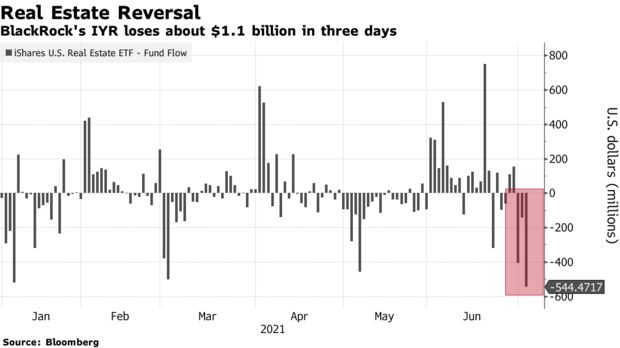
|
||||
|
||||
"The last real estate bust took place less than 20 years ago, so it's still in a lot of investors' minds," said Matt Maley, chief market strategist for Miller Tabak + Co. "Therefore, they're probably getting a little nervous after the huge run-up in the past 15 months."
|
||||
|
||||
The $6.4 billion BlackRock fund lost 0.5% last week. Still, it has risen more than 19% this year, compared to 16% for the S&P 500.
|
||||
|
||||
"There has been this surge in real estate, and the fact that's starting to come off reflects concerns about how interest rates could start to be moving higher," said Fiona Cincotta, senior financial markets analyst at City Index. "It's taken the shine off those areas of the market like real estate."
|
||||
|
||||
Following are the fund's biggest [holdings](https://www.bloomberg.com/quote/IYR:US "ETF Holdings") as of July 2:
|
||||
|
||||
| NAME | TICKER | POSITION | VALUE (USD) | CHANGE IN POSITION | % OF TOTAL ASSET VALUE |
|
||||
| :-------------: |:-------------:| :-------------: |:-------------:| :-------------: |:-------------:|
|
||||
| [American Tower Corp.](https://www.bloomberg.com/quote/AMT:US "All ETFs holding this security") | AMT US Equity | 2.1 million | 572.6 million | -178,610 | 9 |
|
||||
| [Prologis Inc.](https://www.bloomberg.com/quote/PLD:US "All ETFs holding this security") | PLD US Equity | 3.41 million | 413.2 million | -290,652 | 6.5 |
|
||||
| [Crown Castle International Cor](https://www.bloomberg.com/quote/CCI:US "All ETFs holding this security") | CCI US Equity | 1.99 million | 392.9 million | -169,812 | 6.1 |
|
||||
| [Equinix Inc.](https://www.bloomberg.com/quote/EQIX:US "All ETFs holding this security") | EQIX US Equity | 360,038 | 288.2 million | -30,634 | 4.5 |
|
||||
| [Public Storage](https://www.bloomberg.com/quote/PSA:US "All ETFs holding this security") | PSA US Equity | 708,993 | 214.6 million | -60,314 | 3.4 |
|
||||
| [Simon Property Group Inc.](https://www.bloomberg.com/quote/SPG:US "All ETFs holding this security") | SPG US Equity | 1.53 million | 198.3 million | -130,274 | 3.1 |
|
||||
| [Digital Realty Trust Inc.](https://www.bloomberg.com/quote/DLR:US "All ETFs holding this security") | DLR US Equity | 1.31 million | 197.1 million | -111,618 | 3.1 |
|
||||
| [Welltower Inc.](https://www.bloomberg.com/quote/WELL:US "All ETFs holding this security") | WELL US Equity | 1.94 million | 165.1 million | -165,572 | 2.6 |
|
||||
| [SBA Communications Corp.](https://www.bloomberg.com/quote/SBAC:US "All ETFs holding this security") | SBAC US Equity | 509,189 | 164.4 million | -43,354 | 2.6 |
|
||||
| [CoStar Group Inc.](https://www.bloomberg.com/quote/CSGP:US "All ETFs holding this security") | CSGP US Equity | 1.84 million | 151.9 million | -156,562 | 2.4 |
|
||||
|
||||
|
||||
These alerts are triggered for any U.S. exchange-traded fund that meets the following criteria (all numbers in US$). In some cases these updates may include portfolio rebalances:
|
||||
|
||||
| ASSETS UNDER MANAGEMENT | DAILY FLOW |
|
||||
| :-------------: |:-------------:|
|
||||
| >10bn | >1bn |
|
||||
| >1bn | >100m |
|
||||
| >500mln | >50m |
|
||||
| >250mln | >25m |
|
||||
| >100mln | >10m |
|
||||
| <100mln | >5m |
|
||||
|
||||
--- With assistance by Francesca Maglione
|
||||
@ -0,0 +1,26 @@
|
||||
SEC Charges Three Individuals with Insider Trading
|
||||
==================================================
|
||||
|
||||
| Author | Source |
|
||||
| :----: | :----: |
|
||||
| [SEC](https://www.sec.gov/about.shtml) | [sec.gov](https://www.sec.gov/news/press-release/2021-121) |
|
||||
|
||||
---
|
||||
|
||||
|
||||
FOR IMMEDIATE RELEASE\
|
||||
2021-121
|
||||
|
||||
Washington D.C., July 9, 2021 ---
|
||||
|
||||
The Securities and Exchange Commission today charged three individuals with insider trading in advance of an announcement by Long Blockchain Company (formerly known as Long Island Iced Tea Co.) that it was going to "pivot" from its existing beverage business to blockchain technology, which caused the company's stock price to soar.
|
||||
|
||||
According to the SEC's complaint, filed in the U.S. District Court for the Southern District of New York, Eric Watson, an undisclosed control person of Long Blockchain who helped drive this business change within the company and signed a confidentiality agreement not to disclose the company's business plans, tipped his friend and broker, Oliver Barret-Lindsay, of such plans, including by sharing with him a draft of the company's press release. Barret-Lindsay, in turn, allegedly passed the material nonpublic information on to his friend, Gannon Giguiere. Within hours of receiving this confidential information, Giguiere purchased 35,000 shares of Long Blockchain stock. According to the complaint, the company's stock price skyrocketed after the press release was issued, spiking more than 380% intraday. Within two hours of the announcement, Giguiere sold his shares for over $160,000 in illicit profits.
|
||||
|
||||
"The SEC remains committed to preventing all types of fraudulent conduct in connection with purported 'crypto' companies, including profiting from trading on material non-public information," said Richard R. Best, Director of the SEC's New York Regional Office.
|
||||
|
||||
The SEC's complaint charges Watson, Barret-Lindsay, and Giguiere with violating Section 10(b) of the Securities Exchange Act of 1934 and Rule 10b-5 thereunder, and seeks permanent injunctions and civil penalties as to all defendants, and, additionally, an officer and director bar as to Watson.
|
||||
|
||||
The SEC [previously charged Barret-Lindsay and Giguiere](https://www.sec.gov/litigation/litreleases/2018/lr24201.htm) in connection with their alleged role in a stock manipulation scheme, which is currently in litigation. Both Lindsay and Giguiere pled guilty to criminal charges in connection with that matter. Additionally, the Commission [revoked the registration](https://www.sec.gov/litigation/admin/2021/34-91174.pdf) of Long Blockchain's securities on Feb. 19, 2021, pursuant to Section 12(j) of the Exchange Act.
|
||||
|
||||
The SEC's investigation has been conducted by Lindsay S. Moilanen, Mark R. Sylvester, Diego Brucculeri, John O. Enright, and Sheldon L. Pollock, and the litigation will be led by Ms. Moilanen and Mr. Sylvester. The case is being supervised by Sanjay Wadhwa.
|
||||
@ -0,0 +1,75 @@
|
||||
Remember that Climate Change Meeting in March? They discussed Hedge Funds.
|
||||
==========================================================================
|
||||
|
||||
| Author | Source |
|
||||
| :----: | :----: |
|
||||
| [u/I_DO_ANIMAL_THINGS](https://www.reddit.com/user/I_DO_ANIMAL_THINGS/) | [Reddit](https://www.reddit.com/r/Superstonk/comments/oh0mhl/remember_that_climate_change_meeting_in_march/) |
|
||||
|
||||
---
|
||||
|
||||
|
||||
[DD 👨🔬](https://www.reddit.com/r/Superstonk/search?q=flair_name%3A%22DD%20%F0%9F%91%A8%E2%80%8D%F0%9F%94%AC%22&restrict_sr=1)
|
||||
|
||||
Good afternoon Apes,
|
||||
|
||||
***I'm an idiot. None of this is advice. You do you.***
|
||||
|
||||
I was reading the [Monetary Policy Reports](https://www.federalreserve.gov/monetarypolicy/mpr_default.htm), as one usually do.
|
||||
|
||||
[](https://preview.redd.it/okiszbnbz7a71.jpg?width=859&format=pjpg&auto=webp&s=eed2fcffbce92142bf8332d96fea3b39f8adbee4)
|
||||
|
||||
and McDonalds provides the McFlurry. All is well.
|
||||
|
||||
The who-who started the what-what?
|
||||
|
||||
Page 31 of 7/9/21 report discusses Developments Related to Financial Stability.
|
||||
|
||||
[](https://preview.redd.it/wxkeu4fsz7a71.jpg?width=339&format=pjpg&auto=webp&s=394b7d8fa1ad8778e63051f2164ed4a096902468)
|
||||
|
||||
Angela is now in charge of the party planning committee.
|
||||
|
||||
[Financial Stability Oversight Council](https://home.treasury.gov/policy-issues/financial-markets-financial-institutions-and-fiscal-service/fsoc)
|
||||
|
||||
> *The Council is charged with identifying risks to the financial stability of the United States; promoting market discipline; and responding to emerging risks to the stability of the United States' financial system. The Council consists of 10 voting members and 5 nonvoting members and brings together the expertise of federal financial regulators, state regulators, and an independent insurance expert appointed by the President.*
|
||||
|
||||
[Hedge Fund Working Group](https://i.kym-cdn.com/entries/icons/original/000/019/277/confusedtravolta.jpg)
|
||||
|
||||
> *I can't find anything about this yet. ~IDAT*
|
||||
|
||||
Sausage Recipe: Closed Door Meeting Minutes from 3-31-2021
|
||||
|
||||
**A closed door session was called to order at 2:02 PM. Here's what was discussed until 3:07PM**
|
||||
|
||||
[](https://preview.redd.it/77ur2gpvz7a71.jpg?width=765&format=pjpg&auto=webp&s=9a91101ee03ddf250160b6927d111e2b4c357815)
|
||||
|
||||
Five hundred twenty five thousand six hundred minutes. How do you measure, measure incompetence?
|
||||
|
||||
HEDGE FUND ACTIVITIES
|
||||
|
||||
[](https://preview.redd.it/go6o4fkp08a71.jpg?width=770&format=pjpg&auto=webp&s=b525e7812cdccb98cb013fdfee27d62f5a779455)
|
||||
|
||||
....continued.
|
||||
|
||||
[](https://preview.redd.it/j4w8t5wm08a71.jpg?width=792&format=pjpg&auto=webp&s=1d36479bbd4b1a3b6271d0a402c2ae285a4b9b21)
|
||||
|
||||
Fin
|
||||
|
||||
TL/DR Highlights: They know. They're working on it.
|
||||
|
||||
- Hedge funds entered 2020 with higher than historical leverage.
|
||||
|
||||
- Some very large funds have high leverage and are highly interconnected with financial markets and banks.
|
||||
|
||||
- Some reductions in exposures to U.S. Treasury securities may have been due to hedge funds withdrawing from a specific bond basis trade.
|
||||
|
||||
- Lenders to hedge funds face risks even if such lending is secured, because if a large fund, or many funds, suddenly failed, each counterparty may attempt to sell the collateral in unison, and the value of the collateral could decline materially, imposing losses on counterparties.
|
||||
|
||||
- Large banks' exposures to hedge funds through lending and the significance of these exposures relative to bank assets.
|
||||
|
||||
- Importance of the [SEC's Form PF.](https://www.sec.gov/divisions/investment/pfrd/pfrdfaq.shtml)
|
||||
|
||||
- Acting Chair of the SEC, provided additional information regarding Archegos, including further detail regarding the firm's investments and the SEC's coordination with other regulators
|
||||
|
||||
- SEC staff's presentation was based on newly available data
|
||||
|
||||
~Semper
|
||||
@ -0,0 +1,137 @@
|
||||
FINRA Requests Comment on SHORT INTEREST POSITION REPORTING ENHANCEMENTS & Other Changes Related to SHORT SALE REPORTING (Includes Reporting of Synthetic Shorts): Comments Accepted Until 8/3/2021
|
||||
===================================================================================================================================================================================================
|
||||
|
||||
| Author | Source |
|
||||
| :-------------: |:-------------:|
|
||||
| [u/Freadom6](https://www.reddit.com/user/Freadom6/) | [Reddit](https://www.reddit.com/r/Superstonk/comments/ofmswd/finra_requests_comment_on_short_interest_position/) |
|
||||
|
||||
---
|
||||
|
||||
|
||||
[DD 👨🔬](https://www.reddit.com/r/Superstonk/search?q=flair_name%3A%22DD%20%F0%9F%91%A8%E2%80%8D%F0%9F%94%AC%22&restrict_sr=1)
|
||||
|
||||
Edit 1/3: Formatting
|
||||
|
||||
Edit 2: A lot of comments about self-reporting being the problem. You should read about CAT (Consolidated Audit Trail) going into effect on 9/1. This does appear to be a more automated tracking system for reporting and removes some of the self-reporting features. Here's the link announcing retirement of OATS (Order Audit Trail System) for the CAT: [OATS Retirement - CATS Implementation](https://www.finra.org/filing-reporting/market-transparency-reporting/order-audit-trail-system-oats)
|
||||
|
||||
[Regulatory Notice 21-19](https://www.finra.org/rules-guidance/notices/21-19)
|
||||
|
||||
TL;dr: Above is a Regulatory Notice filed by FINRA on 6/4/2021 with a comment period through 8/3/2021. Document is pretty big, but here is a brief summary of the items that should be paid attention to from what I am seeing, including reporting of SYNTHETIC SHORT POSITIONS.
|
||||
|
||||
This rule change also CALLS out our DD as CORRECT where the sale of a call option and purchase of a put option (where options have the same strike price and expiration date) are being used to HIDE SYNTHETIC SHORTS. This rule is coming across as a pretty important step in proper reporting of short data. Highlights of Notice:
|
||||
|
||||
1. REQUIRING FIRMS TO SUBMIT SYNTHETIC SHORT POSITIONS. Text from rule, "For example, enhanced short interest reporting could include synthetic short positions achieved through the sale of a call option and purchase of a put option (where the options have the same strike price and expiration month) or through other strategies."
|
||||
|
||||
2. FINRA has historically only published short data for OTC securities and not exchange listed securities (definitions below). They now want to report both.
|
||||
|
||||
3. They also want to increase the frequency of reporting this information. Instead of twice per month, now daily or weekly.
|
||||
|
||||
4. Requiring short interest reporting of proprietary and customer accounts.
|
||||
|
||||
5. Making firms report short interest at the account level so FINRA knows the individuals or entities that accumulated short positions.
|
||||
|
||||
6. Jeepers, they are currently allowed to BORROW shares through financing options called "enhanced lending" or "short arranging products" from a firm's domestic or foreign affiliate to "CLOSE OUT" short sales. How is this legal? FINRA wants to make this borrowing included in their short interest reports.
|
||||
|
||||
7. Including Total Shares Outstanding (TSO) and Public Float information in short interest reports.
|
||||
|
||||
8. Adding a new field to short interest report to indicate whether a security is a threshold security.
|
||||
|
||||
9. Reducing processing time by FINRA to disseminate information more quickly after it has been reported.
|
||||
|
||||
10. Daily reporting of Fails-To-Deliver and more stringent reporting requirements.
|
||||
|
||||
Here are a couple of copy/pasted definitions of terms above:
|
||||
|
||||
OTC Security: OTC refers to the process of how securities are traded for companies not listed on a formal exchange. Securities that are traded over-the-counter are traded via a dealer network as opposed to on a centralized exchange. [Define OTC Security](https://www.investopedia.com/terms/o/otc.asp)
|
||||
|
||||
Exchange Listed Securities: A listed security is a [financial instrument](https://www.investopedia.com/terms/f/financialinstrument.asp) that is traded through an exchange, such as the NYSE or Nasdaq. [Define Listed Security](https://www.investopedia.com/terms/l/listedsecurity.asp)
|
||||
|
||||
Threshold Security: Threshold securities are equity securities that have an aggregate fail to deliver position for:
|
||||
|
||||
- Five consecutive settlement days at a [registered clearing agency](https://www.sec.gov/divisions/marketreg/mrclearing.shtml) (e.g., [National Securities Clearing Corporation](https://www.sec.gov/cgi-bin/goodbye.cgi?www.nscc.com/index.html) (NSCC));
|
||||
|
||||
- totaling 10,000 shares or more; and
|
||||
|
||||
- equal to at least 0.5% of the issuer's total shares outstanding. [Define Threshold Security](https://www.investor.gov/introduction-investing/investing-basics/glossary/threshold-securities)
|
||||
|
||||
You know other major players will make comments on this regulatory notice that may cause changes to these regulation changes before implementation. If you are interested, there is a link on the top right of the source webpage to "Submit a Comment". Comments are accepted until 8/3/2021. Remember, any personal information you provide will be made publicly available. - END TL;dr
|
||||
|
||||
Here's some text snippets from the notice from this point forward with no interpretation from myself:
|
||||
|
||||
Background and Discussion
|
||||
|
||||
FINRA is considering whether amendments to its short interest reporting and dissemination program would be appropriate to improve the regulatory and public utility of the information. FINRA also is considering whether any changes to other aspects of its short sale regulatory program would be beneficial, as discussed below.
|
||||
|
||||
A. Publication of Short Interest for Exchange-listed Equity Securities
|
||||
|
||||
FINRA is considering consolidating the publication of short interest data that is reported to FINRA for both listed and unlisted securities. If FINRA were to make this change, short interest files for all equity securities would be made available free of charge on the FINRA website and would not require changes to firms' reporting requirements. In addition, if this change was made, the below potential changes to the content and timing of publicly disseminated data would apply to listed and unlisted securities.
|
||||
|
||||
B. Content of Short Interest Data
|
||||
|
||||
As discussed above, FINRA's website publication of short interest data currently is limited to non-exchange listed, OTC equity securities and includes the following fields:
|
||||
|
||||
- Security name
|
||||
|
||||
- Symbol
|
||||
|
||||
- Settlement Date
|
||||
|
||||
- Market (*i.e.*, OTC equity securities)
|
||||
|
||||
- Current aggregate short interest position for the security across all firms
|
||||
|
||||
- Previous aggregate short interest position for the security across all firms
|
||||
|
||||
- Change in short interest position since the prior reporting period (number of shares)
|
||||
|
||||
- Change in short interest position since the prior reporting period (percentage)
|
||||
|
||||
- Average daily trading volume for the security
|
||||
|
||||
- Days to cover[9](https://www.finra.org/rules-guidance/notices/21-19#_edn9)
|
||||
|
||||
- Revision Flag[10](https://www.finra.org/rules-guidance/notices/21-19#_edn10)
|
||||
|
||||
FINRA is considering the following changes to reported and disseminated short interest data.[11](https://www.finra.org/rules-guidance/notices/21-19#_edn11) In some cases, FINRA also is considering whether the additional data points proposed to be collected should be disseminated publicly or used only for regulatory purposes.
|
||||
|
||||
- Proprietary and Customer Account Categorization: FINRA is considering requiring firms to segregate the total reportable short interest into two categories---short interest held in proprietary accounts and short interest held in customer accounts. Specifically, in addition to reporting the total short interest in a security, firms also would be required to specify the short interest held across all proprietary accounts and across all customer accounts (for both retail customer and institutional customer accounts) for each equity security as of the close of the designated reporting settlement date. FINRA believes that this information would provide beneficial regulatory information regarding the type of market participant that accumulated a short interest position (i.e., a firm or a non-broker-dealer customer).
|
||||
|
||||
- Account-level Position Information: Alternatively, FINRA is considering requiring firms to report (for regulatory purposes only; not to be disseminated publicly) short interest position information with more granularity by reporting at the account level for all equity securities. Account-level short interest position information would provide FINRA with insight into the identity of the individuals or entities that accumulated concentrations of large short interest positions, which FINRA would use to enhance its reviews for compliance both with SEC Regulation SHO and FINRA's short sale rules.
|
||||
|
||||
- Synthetic Short Positions: In addition, FINRA is considering requiring firms to reflect synthetic short positions in short interest reports. For example, enhanced short interest reporting could include synthetic short positions achieved through the sale of a call option and purchase of a put option (where the options have the same strike price and expiration month) or through other strategies. FINRA believes this information would assist FINRA in understanding the scope of market participants' short sale activity, specifically regarding the use of less-traditional means of establishing short interest.
|
||||
|
||||
- Loan Obligations Resulting From Arranged Financing: FINRA understands that members may offer arranged financing programs (sometimes called "enhanced lending" or "short arranging products") through which a customer can borrow shares from the firm's domestic or foreign affiliate and use those shares to close out a short position in the customer's account. FINRA is considering requiring members to report as short interest outstanding stock borrows by customers in their arranged financing programs to better reflect actual short sentiment in the stock.
|
||||
|
||||
- Total Shares Outstanding (TSO) and Public Float: FINRA also is considering including in FINRA-disseminated short interest data, where available, the TSO and public float for securities. FINRA would obtain this information from a third-party source and include it in disseminated information; therefore, this change would not alter firms' reporting requirements. FINRA believes disseminating a security's TSO and public float would provide investors with contextual information regarding the relative size of the aggregate short position in the security.
|
||||
|
||||
- Threshold Security Field:[12](https://www.finra.org/rules-guidance/notices/21-19#_edn12) FINRA is considering including in FINRA-disseminated short interest data a new field that would indicate if the security is a threshold security as of the short interest position reporting settlement date. This change would not alter firms' reporting requirements. FINRA believes that a security's status as a threshold security could be useful to investors and other market participants in evaluating an investment decision, and that consolidating this information into disseminated short interest data simplifies the process of obtaining this information for users of the data.
|
||||
|
||||
C. Frequency and Timing of Short Interest Position Reporting and Data Dissemination
|
||||
|
||||
Members currently must submit short interest reports to FINRA twice a month and reports are due to FINRA by 6:00 p.m. ET on the second business day after the reporting settlement date designated by FINRA. FINRA is considering requiring firms to report short interest data to FINRA more frequently. Specifically, FINRA is considering reducing the reporting timeframe to daily or weekly submissions and, to enable FINRA to disseminate the collected information to the marketplace on a timelier basis, such reports also would be due to FINRA in a shorter timeframe following the applicable settlement date. For example, if FINRA were to require daily submissions, short interest reports could be due by 6:00 p.m. ET one business day after the designated reporting settlement date, and for weekly submissions, short interest reports could be due by 6:00 p.m. ET one business day after the weekly designated reporting settlement date (instead of the current requirement of two business days after the designated reporting settlement date).[13](https://www.finra.org/rules-guidance/notices/21-19#_edn13)
|
||||
|
||||
FINRA also is considering reducing the FINRA processing time involved in disseminating short interest data. Currently, FINRA disseminates short interest data for OTC equity securities on the FINRA website seven business days after the designated settlement date, which is five business days after the reports are due from member firms. FINRA is considering reducing this processing time. The proposed reduction in FINRA processing time could apply where firms report short interest to FINRA on a daily or weekly basis, as described above, and also could apply to the current twice a month reporting cycle (with or without a reduced firm turnaround time).
|
||||
|
||||
D. Information on Allocations of Fail-to-Deliver Positions
|
||||
|
||||
Regulation SHO permits a member that is a participant of a registered clearing agency to allocate a portion of its Rule 204 fail-to-deliver position to another broker-dealer based on that other broker-dealer's short position.[14](https://www.finra.org/rules-guidance/notices/21-19#_edn14) FINRA is considering enhancing its short sale reporting program by adopting a new rule to require members to submit to FINRA (for regulatory purposes only; not for public dissemination) a report of daily allocations of fail-to-deliver positions to correspondent firms pursuant to Rule 204(d) of Regulation SHO.
|
||||
|
||||
The proposed allocation report may include the following fields:
|
||||
|
||||
- Security
|
||||
|
||||
- Identity of correspondent firm
|
||||
|
||||
- Amount allocated to correspondent firm (number of shares)
|
||||
|
||||
- Trade date(s)
|
||||
|
||||
- Allocation Date
|
||||
|
||||
- Close out Date
|
||||
|
||||
- Applicable close out obligation (T+3, T+5 or T+35)
|
||||
|
||||
Th-th-th-that's all folks!
|
||||
|
||||
Tanks fo' readin'
|
||||
45
Regulations/2021-07-08-Regulation-PDFs.md
Normal file
45
Regulations/2021-07-08-Regulation-PDFs.md
Normal file
@ -0,0 +1,45 @@
|
||||
# List of Regulations and their PDFs
|
||||
|
||||
---
|
||||
|
||||
## Regulations
|
||||
|
||||
| Regulation | Description | Date Effective | PDF |
|
||||
| :-------------: |:-------------| :-------------:| :-------------:|
|
||||
| **DTC** | **The Depository Trust Company is a subsidiary of the DTCC, and was created to reduce costs and provide clearing and settlement efficiencies.** [[1]](https://www.dtcc.com/about/businesses-and-subsidiaries/dtc) | | **[Regulatory Rule Filings](https://www.dtcc.com/legal/sec-rule-filings?subsidiary=DTC&pgs=1)** |
|
||||
| SR-DTC-2021-003 | Changes the risk/margin reporting period from monthly to daily. | ✅ 2021-03-16 | [SR-DTC-2021-003-Approval-Notice.pdf](https://github.com/verymeticulous/wikAPEdia/files/6784840/SR-DTC-2021-003-Approval-Notice.pdf)|
|
||||
| SR-DTC-2021-004 | Outlines procedures for asset liquidation in the event of a defaulting member. | ✅ 2021-03-16 | [SR-DTC-2021-004.pdf](https://github.com/verymeticulous/wikAPEdia/files/6784834/SR-DTC-2021-004.pdf) |
|
||||
| SR-DTC-2021-005 | Prevents loaned/borrowed shares from being loaned/borrowed more than once. | ✅ 2021-06-25 | [SR-DTC-2021-005.pdf](https://github.com/verymeticulous/wikAPEdia/files/6784788/SR-DTC-2021-005.pdf) |
|
||||
| SR-DTC-2021-006 | Removes the old method of asset tracking in favor of SR-DTC-2021-005. | ✅ 2021-04-21 | [SR-DTC-2021-006.pdf](https://github.com/verymeticulous/wikAPEdia/files/6784830/SR-DTC-2021-006.pdf) |
|
||||
| SR-DTC-2021-007 | Eliminates the APO system in favor of the Claim Connect system for fee reconciliation between parties. **Mandatory 2021-07-09** | ✅ 2021-04-30 | [SR-DTC-2021-007.pdf](https://github.com/verymeticulous/wikAPEdia/files/6784828/SR-DTC-2021-007.pdf) |
|
||||
| SR-DTC-2021-008 | Reorganizes existing tax reporting/withholdingg guides to accomodate for various DTCC procedural changes that have been implemented.| ✅ 2021-06-08 | [SR-DTC-2021-008.pdf](https://github.com/verymeticulous/wikAPEdia/files/6784823/SR-DTC-2021-008.pdf) |
|
||||
| SR-DTC-2021-009 | Changes current procedures to clearly define deadlines in order to eliminate existing delay-loop workarounds. | ✅ 2021-06-16 | [SR-DTC-2021-009.pdf](https://github.com/verymeticulous/wikAPEdia/files/6784808/SR-DTC-2021-009.pdf) |
|
||||
| **ICC** |**The ICE Clear Credit was founded to digitize markets and provide greater price transparency.** [[1]](https://www.theice.com/about) | | **[Regulatory Rule Filings](https://www.sec.gov/rules/sro/icc.shtml)** |
|
||||
| SR-ICC-2021-005 | ICC version of SR-DTC-2021-004 to define procedures for asset liquidation in the event of a defaulting member. | ✅ 2021-05-10 | [SR-ICC-2021-005.pdf](https://github.com/verymeticulous/wikAPEdia/files/6784935/SR-ICC-2021-005.pdf) |
|
||||
| SR-ICC-2021-007 | Redefines what can and cannot be considered collateral, reducing overall capital on books and lowering acceptable risk ceilings. | ✅ 2021-05-13| [SR-ICC-2021-007.pdf](https://github.com/verymeticulous/wikAPEdia/files/6784931/SR-ICC-2021-007.pdf) |
|
||||
| SR-ICC-2021-008 | Redefines how risky collateral is handled in Credit Default Swaps. Increases initial margin requirements, and lowers ICC exposure. | ✅ 2021-05-18 | [SR-ICC-2021-008.pdf](https://github.com/verymeticulous/wikAPEdia/files/6784924/SR-ICC-2021-008.pdf) |
|
||||
| SR-ICC-2021-009 | Charges calculation of risk from using month-to-month averages to using day-to-day-averages. | ✅ 2021-05-20 | [SR-ICC-2021-009.pdf](https://github.com/verymeticulous/wikAPEdia/files/6784922/SR-ICC-2021-009.pdf) |
|
||||
| SR-ICC-2021-014 | Defines fee schedules for the 2nd half of 2021; includes reduced fees on CDS (25%) and incentives for risk sharing.| ✅ 2021-05-18 | [SR-ICC-2021-014.pdf](https://github.com/verymeticulous/wikAPEdia/files/6784919/SR-ICC-2021-014.pdf) |
|
||||
| **OCC** | **The Office of the Comptroller of the Currency is a federal agency that oversees the execution of laws relating to national banks.** [[1]](https://www.investopedia.com/terms/o/office-comptroller-currency-occ.asp#:~:text=The%20Office%20of%20the%20Comptroller%20of%20the%20Currency%20(OCC)%20is,laws%20relating%20to%20national%20banks.) | | **[Regulatory Rule Filings](https://www.sec.gov/rules/sro/occ.htm)** |
|
||||
| SR-OCC-2021-003 | Increases margin requirements for market makers when dealing with options contracts. | ✅ 2021-05-27 | [SR-OCC-2021-003.pdf](https://github.com/verymeticulous/wikAPEdia/files/6784888/SR-OCC-2021-003.pdf) |
|
||||
| SR-OCC-2021-004 | Allows previosuly excluded firms to participate in auctions of assets when a member is liquidated. | ✅ 2021-05-19 | [SR-OCC-2021-004.pdf](https://github.com/verymeticulous/wikAPEdia/files/6784904/SR-OCC-2021-004.pdf) |
|
||||
| **NSCC** | **The National Securities Clearing Corporation is a subsidiary of the DTCC, and was created to provide clearing settlement, risk managment, central counterparty services, and a guarantee of completion for certain transactions for virtuall all broker-to-broker trades.** [[1]](https://www.dtcc.com/about/businesses-and-subsidiaries/nscc) | | **[Regulatory Rule Filings](https://www.dtcc.com/legal/sec-rule-filings?subsidiary=NSCC&pgs=1)** |
|
||||
| SR-NSCC-2021-002 | Automates the margin call process when daily reports indicate a member is overleveraged. | ✅ 2021-06-23 | [SR-NSCC-2021-002.pdf](https://github.com/verymeticulous/wikAPEdia/files/6784875/SR-NSCC-2021-002.pdf) |
|
||||
| SR-NSCC-2021-004 | NSCC version of SR-DTC-2021-004 to define procedures for asset liquidation in the event of a defaulting member. | ✅ 2021-03-18 | [SR-NSCC-2021-004.pdf](https://github.com/verymeticulous/wikAPEdia/files/6784872/SR-NSCC-2021-004.pdf) |
|
||||
| SR-NSCC-2021-005 | Increases the minimum required fund deposit for DTCC members from $10,000 to $250,000 each. | ⚠️ TBD (2021-08-12) | [SR-NSCC-2021-005.pdf](https://github.com/verymeticulous/wikAPEdia/files/6784869/SR-NSCC-2021-005.pdf) |
|
||||
| SR-NSCC-2021-006 | Removal of the 10-day approval period on proposed rule changes among other numerous ammendments. | ✅ 2021-05-12 | [SR-NSCC-2021-006.pdf](https://github.com/verymeticulous/wikAPEdia/files/6784867/SR-NSCC-2021-006.pdf) |
|
||||
| **Other** | | | |
|
||||
| Exchange Act Rule 15c3-3 | Establishes a requirement for 100% collateral to be held on all positions within six months. | ✅ 2021-04-22 | [Rule-15c3-3.pdf](https://github.com/verymeticulous/wikAPEdia/files/6784958/Rule-15c3-3.pdf) |
|
||||
| MSBS978-21: FICC Notice | Returns MBSD Intraday Mark-Market Charge to hourly assessment istead of once-per-day for margins. | ✅ 2021-05-03 | [MBSD978-21.pdf](https://github.com/verymeticulous/wikAPEdia/files/6784986/MBSD978-21.pdf) |
|
||||
| SR-NYSEAMER-2021-29 | Provides incentives for brokers to route retail orders through the NYSE instead of through dark pools/off-market exchanges (OTC). | ✅ 2021-06-17 | [SR-NYSEAMER-2021-29.pdf](https://github.com/verymeticulous/wikAPEdia/files/6784991/SR-NYSEAMER-2021-29.pdf) |
|
||||
| FINRA Regulatory Notice 21-19 | Requires firms to submit synthetic short positions with increased reporting frequency tfrom twice per month to daily or weekly. | ⚠️ TBD (Comments accepted until 2021-08-03) | [Regulatory-Notice-21-19.pdf](https://github.com/verymeticulous/wikAPEdia/files/6784777/Regulatory-Notice-21-19.pdf) |
|
||||
|
||||
**Sources**
|
||||
1. [TLDR of Regulations](https://www.reddit.com/r/Superstonk/comments/o5mhie/tldr_regulations_edition_updated_20210622_to/)
|
||||
2. [Go / No Go Launch Checklist](https://www.reddit.com/r/Superstonk/comments/nhh0f1/update_go_nogo_for_launch_the_checklist_keeping/)
|
||||
3. [FINRA Short Interest Position Reporting Enhancements](https://www.reddit.com/r/Superstonk/comments/ofmswd/finra_requests_comment_on_short_interest_position/)
|
||||
|
||||
---
|
||||
**Relevant Information/Material**
|
||||
|
||||
_For more information on Regulations, check out [wikAPEdia](https://github.com/verymeticulous/wikAPEdia/tree/main/Regulations)_
|
||||
Reference in New Issue
Block a user